My Summer 2022 Europe adventure: Berlin, Amsterdam, Split, Mostar, Sarajevo, Belgrade, Budapest, Vienna.
March 03, 2024In Summer 2022, I went on an epic trip in Europe. I’m writing about it here, inspired by my friend Max’s travel blog.
Needless to say, it took me a while to edit this. In the meantime I’ve been reflecting on some of these themes. Urban infrastructure; history; culture; art.
Showing is better than telling.
Berlin, Germany
Right after graduating from grad school, my partner Paula and I flew to Berlin.
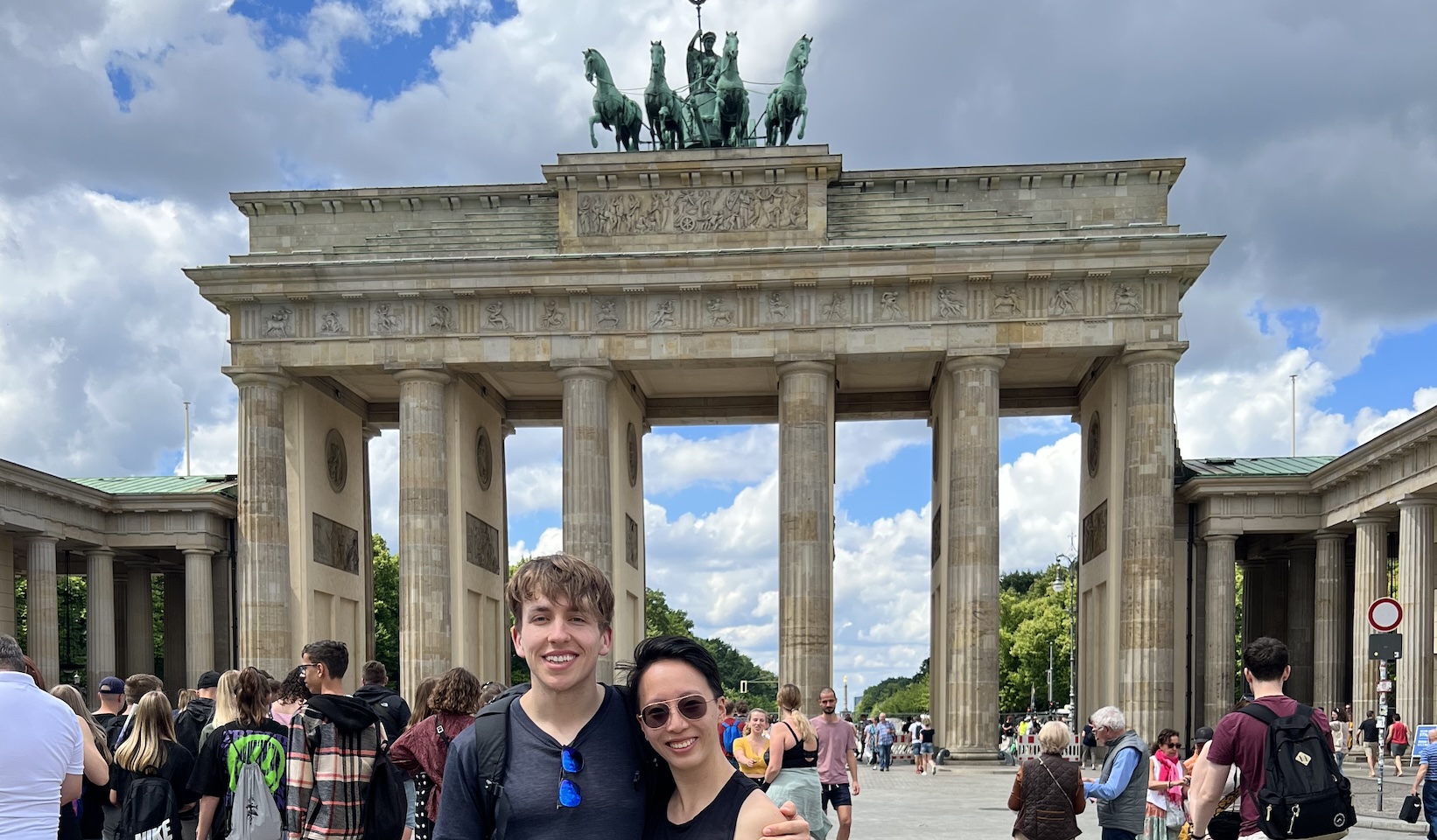
My sister Zanny lives there, as does her partner Dennis. We stayed with them in a house in the southern suburbs. My other sister Karen, and her partner Logan, visited too. We had a mini Zellers kids reunion.
Tempelhof
Tempelhof is a former airport that was constructed by the Nazis. The Nazi architecture is spooky. The sharp jagged lines really make it feel like it’s not at human scale. Actually the whole thing doesn’t feel like it’s at human scale, partially because it’s a giant airport.
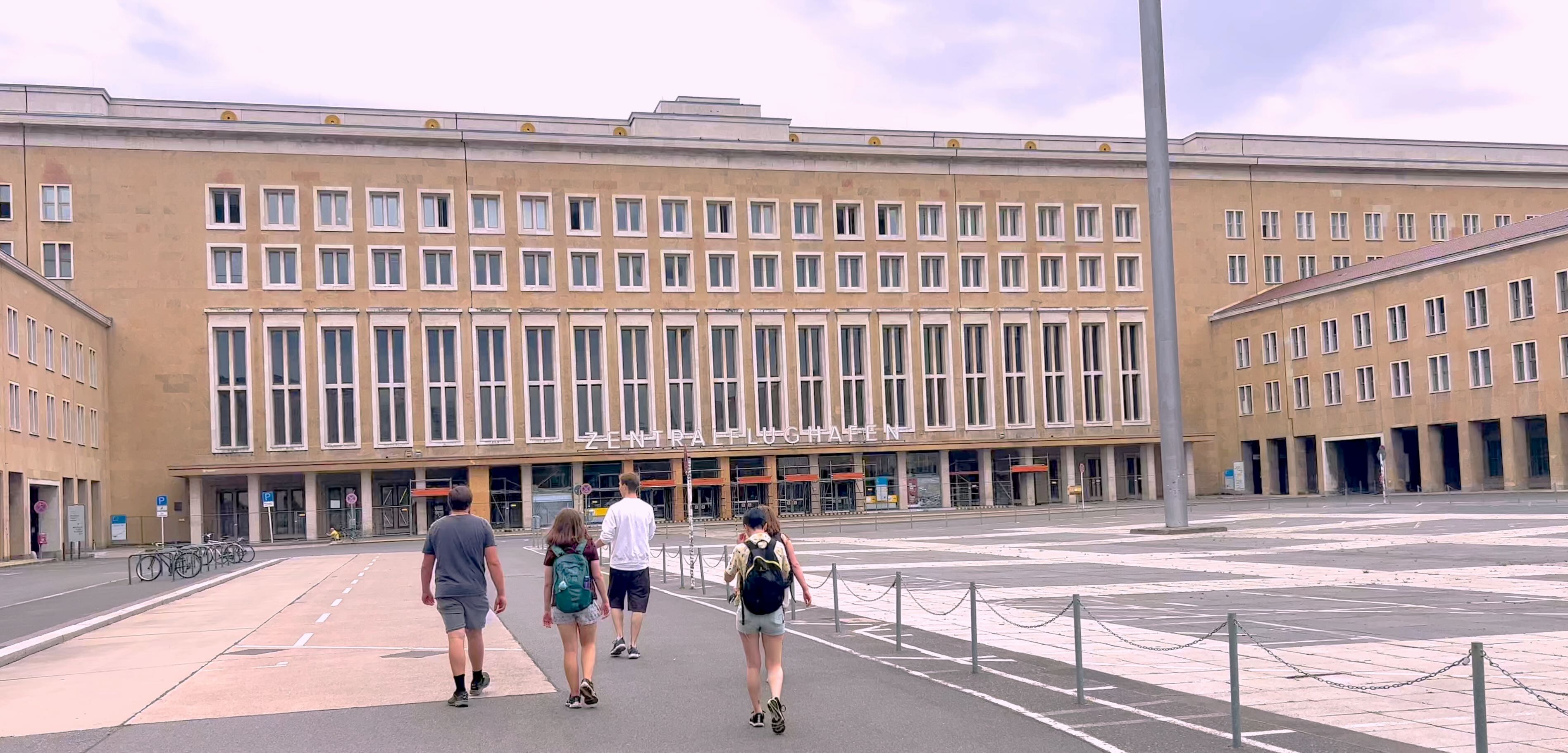
Over the last century, Tempelhof was the site of so much history: construction by the Nazis, then the Berlin airlift. Right now it’s a massive park.
It’s worth noting that airports require a ton of land. It’s easy to forget this, as no one ever walks across a whole airport on foot. Here, we did that.
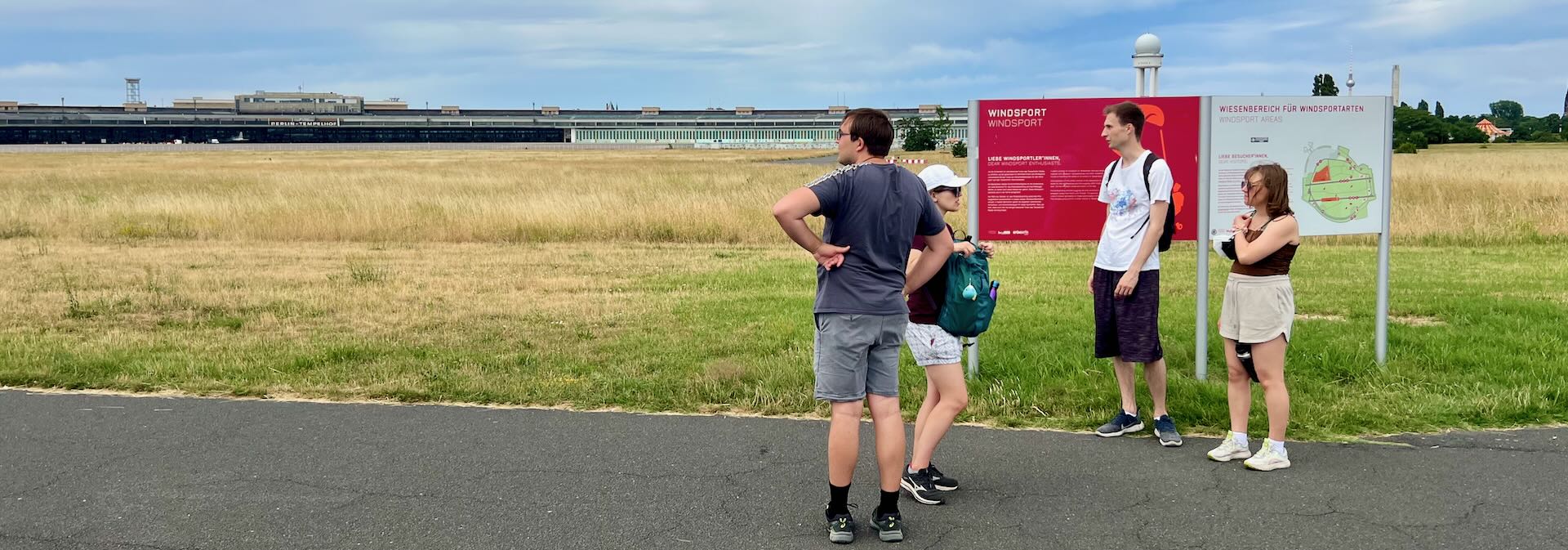
The land required for an airport isn’t just the runway and the passenger loading area, plus some space for planes. You also need lots of water. So when the airport became decommissioned, the former rainwater basin became unused and life returned to the swamp. To preserve it and make use of the space a bunch of people built walkways and structures around it. This became the Floating University.
We attended a talk there; it was pretty hip.

Hochbunker Pallasstraße
One of the cool neighborhoods we strolled through featured a giant apartment complex on top of a WWII era bunker. A literal juxtaposition of new-on-old.
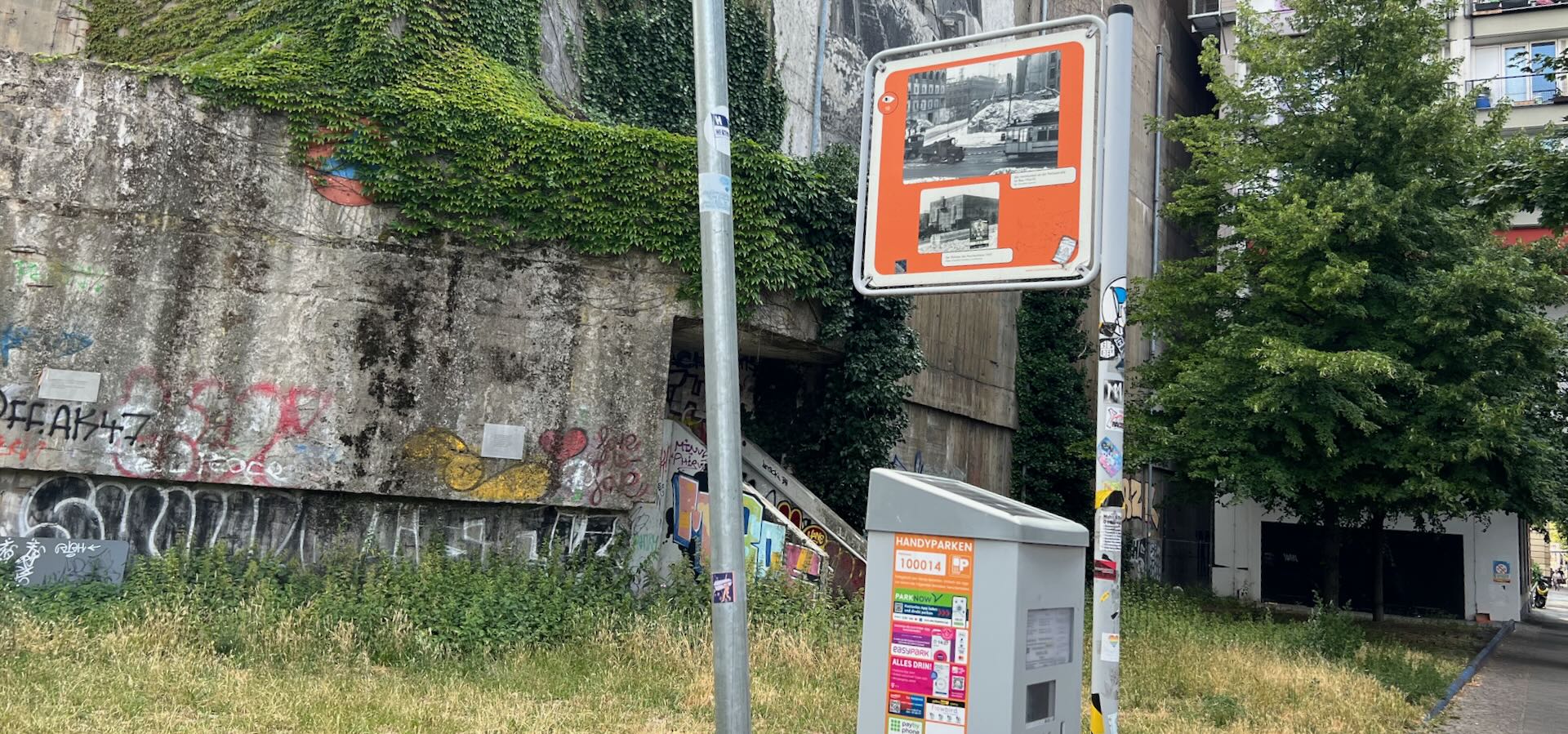
We told Dennis’ parents about our adventure and they were horrified. Apparently that neighborhood used to be super dangerous. It felt pretty safe to us at least now.
Berlin Wall
I also went on a lot of runs near Zanny's place.
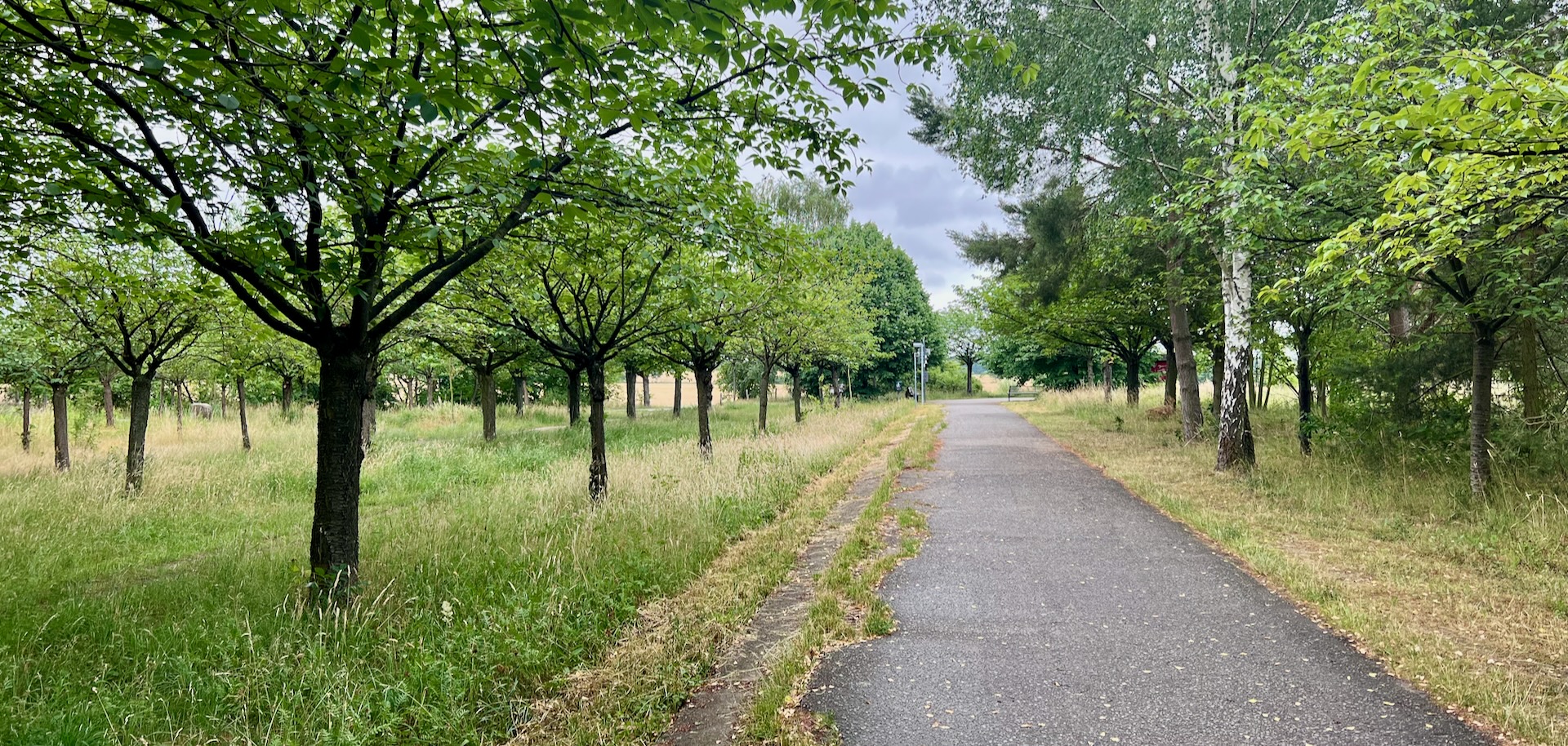
The Berlin Wall is now a nice running and cycling path.
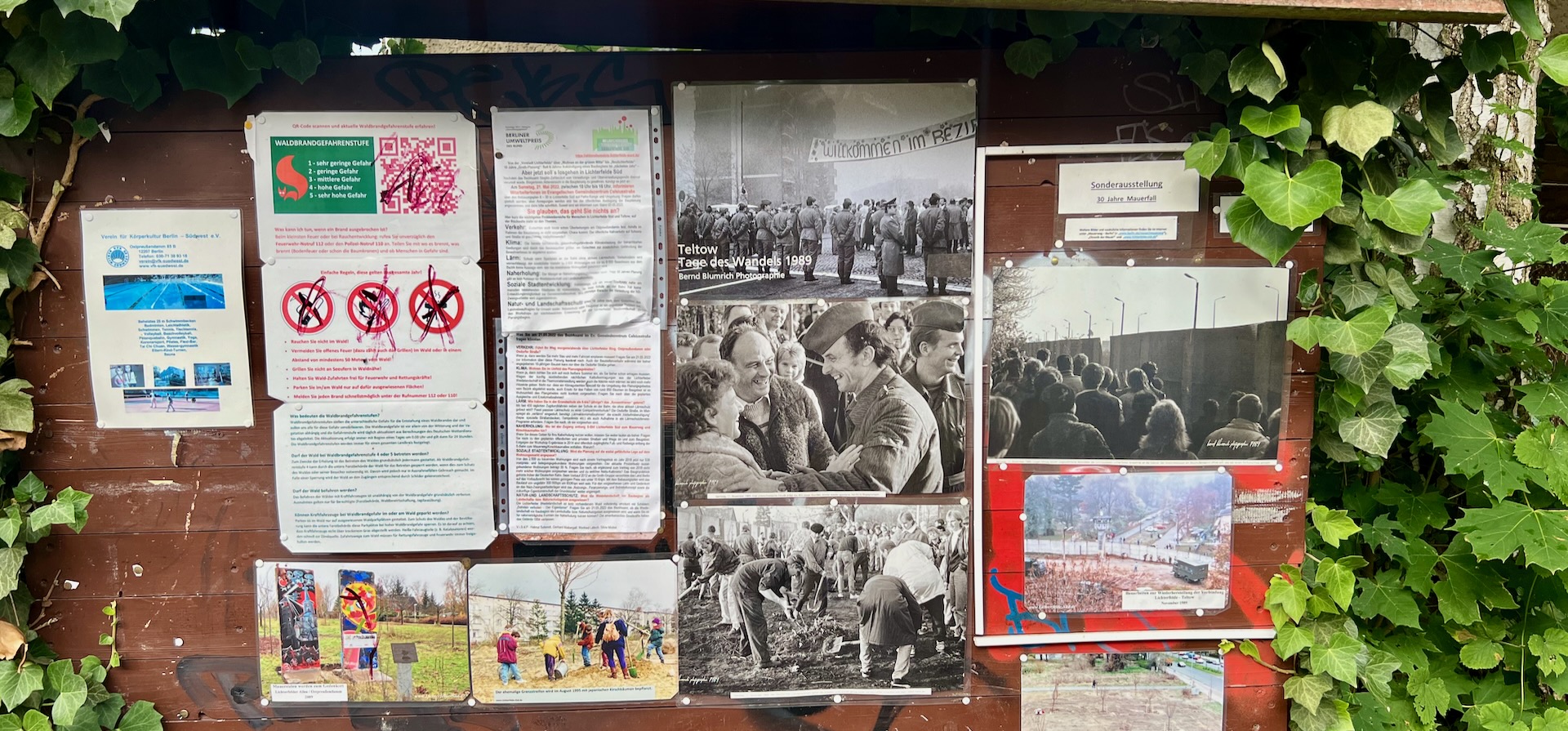
A sign there had both typical park rules and regulations, as well as photos of the wall being taken down. Today the wall is no more.
Teufelsberg and minigolf
Teufelsberg is a giant landfill full of WW2 debris, with a US cold war spy station on top. Karen and Logan had returned for home already, so the rest of us went to a hike up to Teufelsberg.
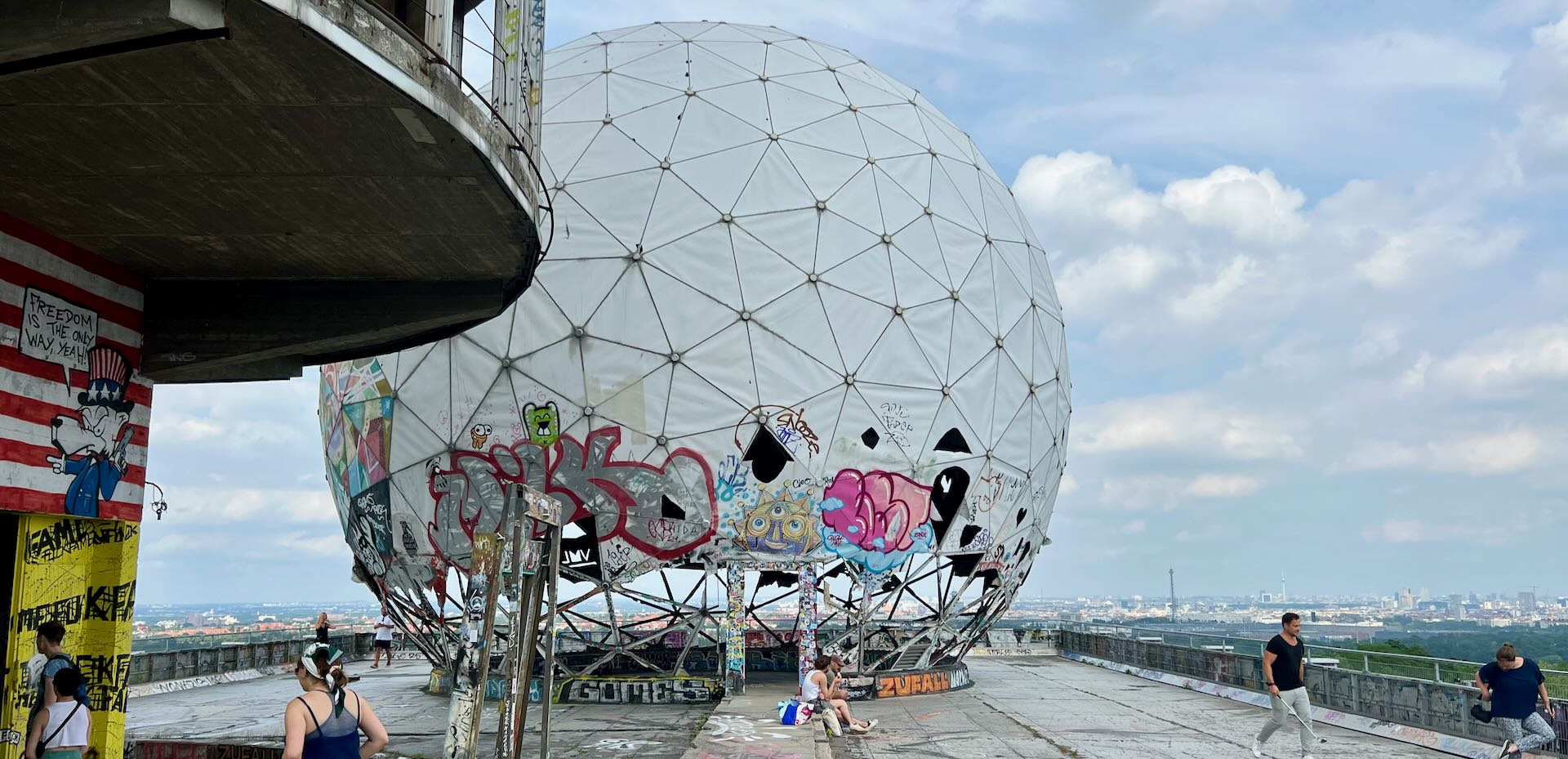
Right now, it’s a place for views of the city and graffiti. And yes, the person in the photo was playing mini-golf (though unsanctioned here).
Relatedly, Mini Golf feels like a Thing in Berlin. There are 3 little mini golf courses nearby my sister’s neighborhood. My neighborhood in San Francisco only has one -- maybe it’s easier to get the zoning needed?
The rules are a bit different too. In German mini golf one player continues until they’re done with the hole. So no player-on-player collisions. It’s more organized this way.
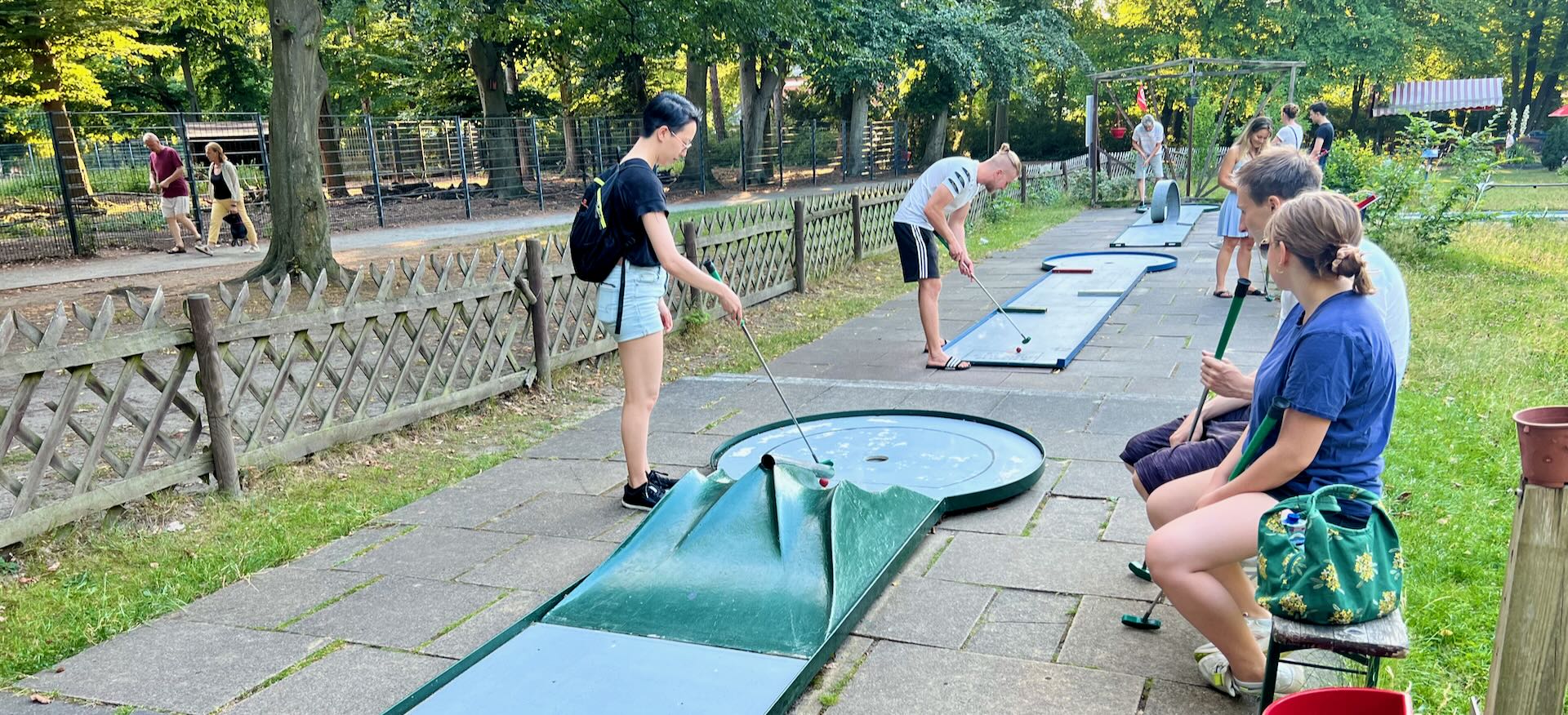
Vegan food
My final takeaway from Berlin is the quantity and quality of vegan food there.
I'm vegetarian, but Zanny is vegan, so we were on the lookout. It wasn't very hard though.
Friedrichshein was probably the most surprising neighborhood for me. It felt like there were vegan restaurants right next to other vegan restaurants. Though just about every restaurant seemed to have a sizeable vegan menu.
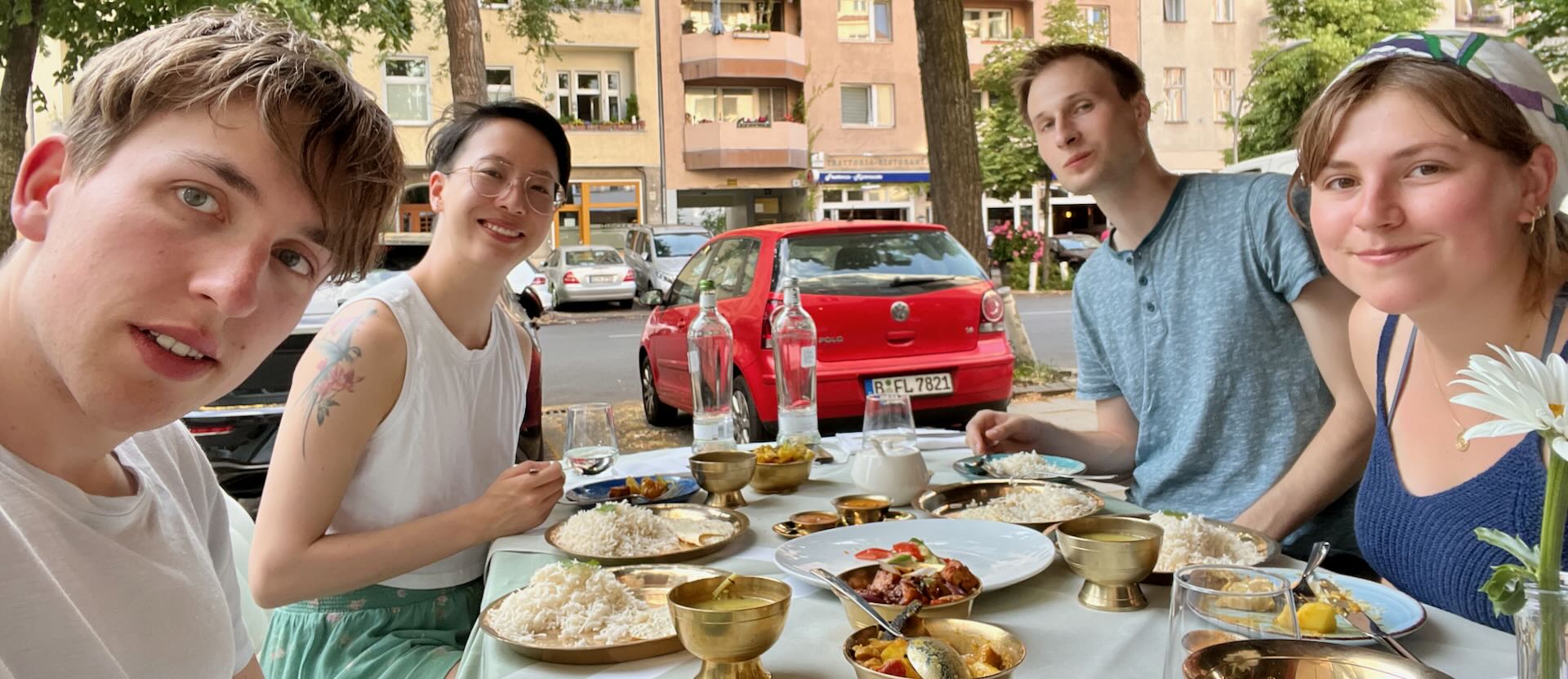
Amsterdam, Netherlands
Zanny, Dennis, Paula, and I took a trip to Amsterdam. The main factor that brought us all there was watching a lot of urbanist YouTubers rave about the bike infrastructure. It really feels like a city made for bikes.
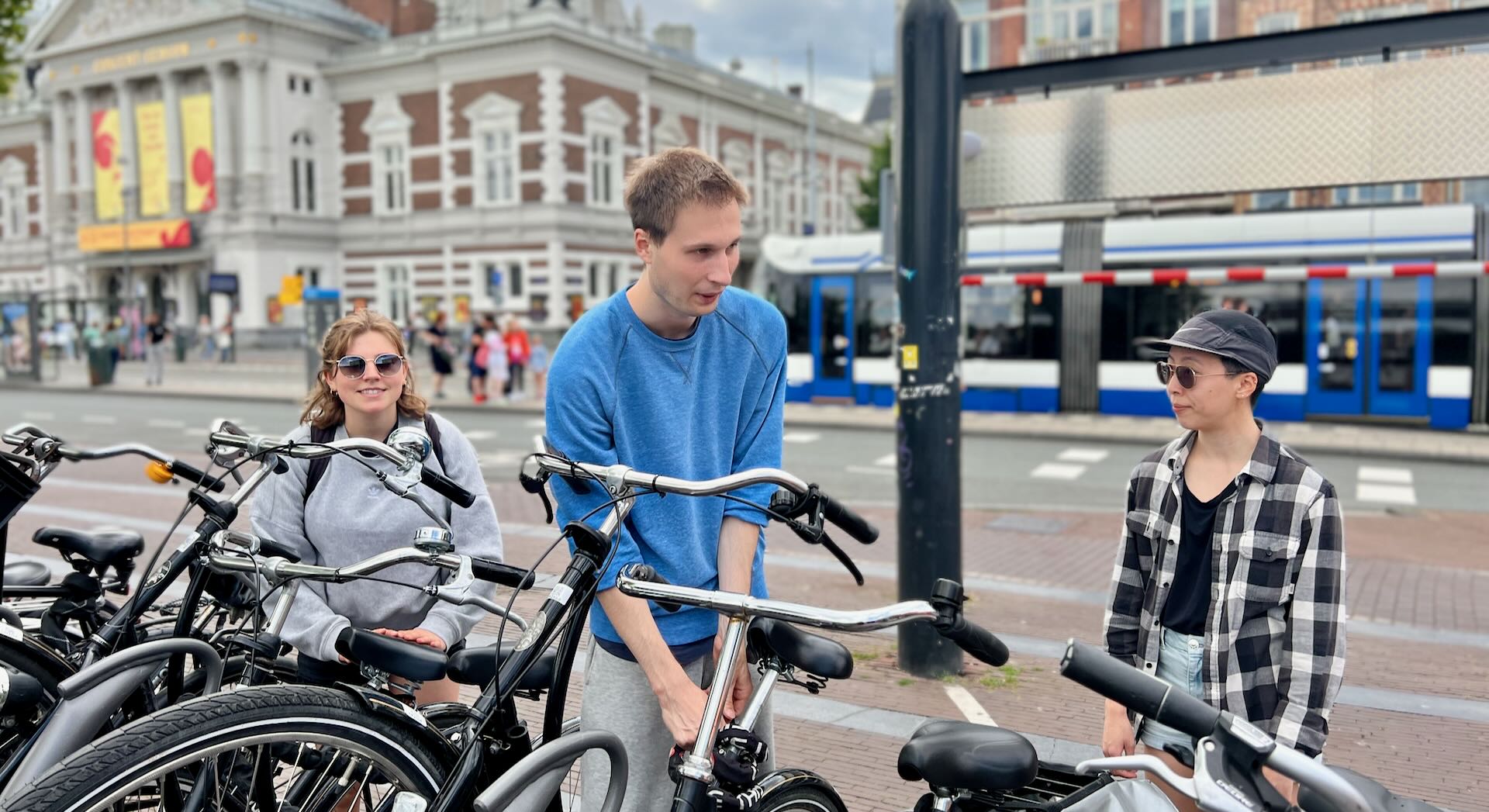
Obviously we rented bikes. Though bikes aren’t the only way to get around, we also took trams and walked.
Biking around Amsterdam feels pretty terrifying at first, which no urbanist YouTuber seems to talk about. Bikes and pedestrians are both very maneuverable. If someone is crossing the street it feels like the biker doesn’t usually stop, they just move at the last second. Also, no one here wears helmets.
After coming to terms with those two things, I really enjoyed the bike paths and infrastructure.
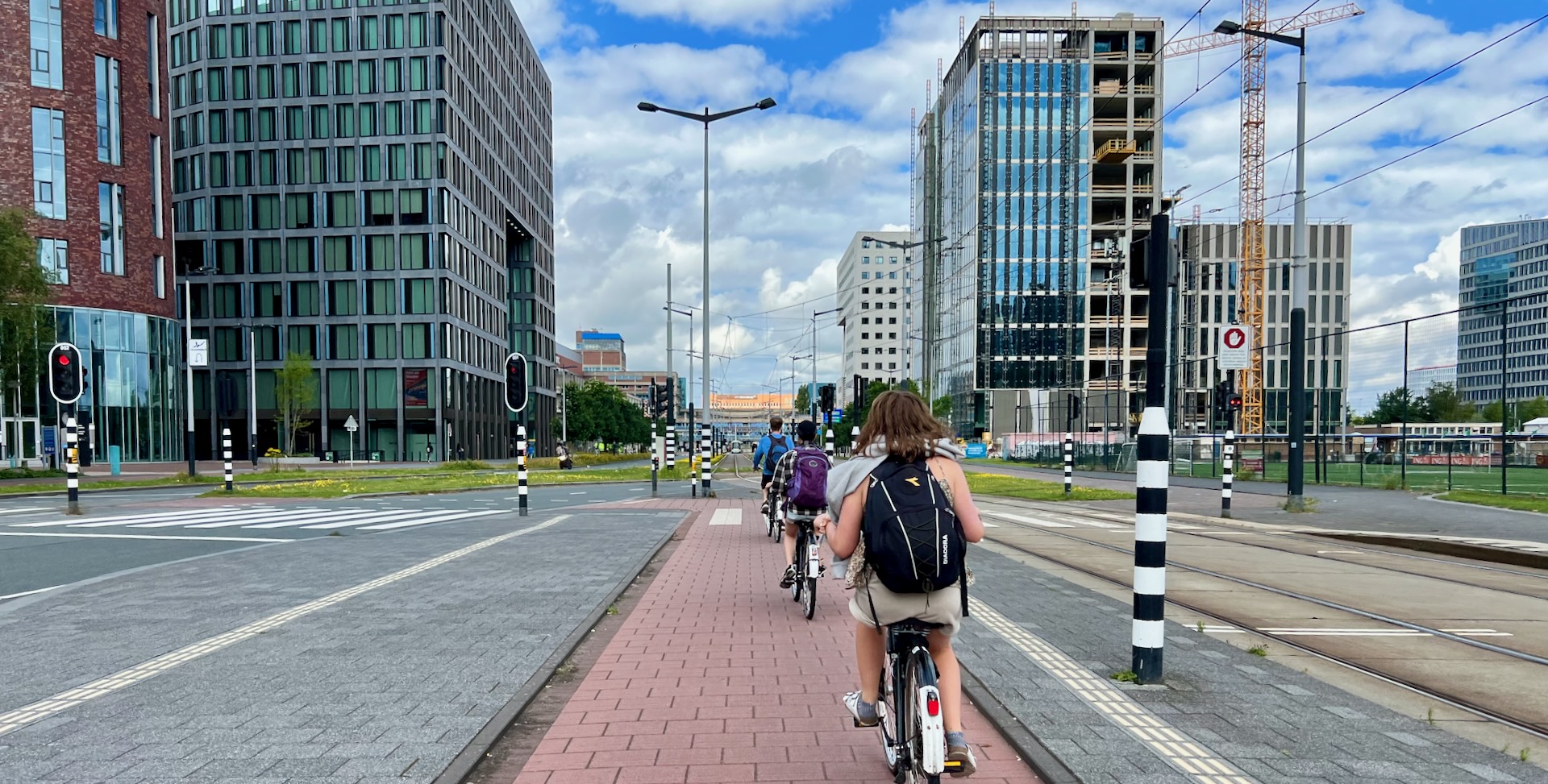
Amsterdam feels really successful as a biking city – so successful that it’s hard to find bike parking. It was also pretty crowded in general when we visited – so many people were out and about that it was often hard to find a table in restaurants. But maybe that’s because we visited during the peak tourist time.
Not just bikes
We did stuff besides ride bikes.
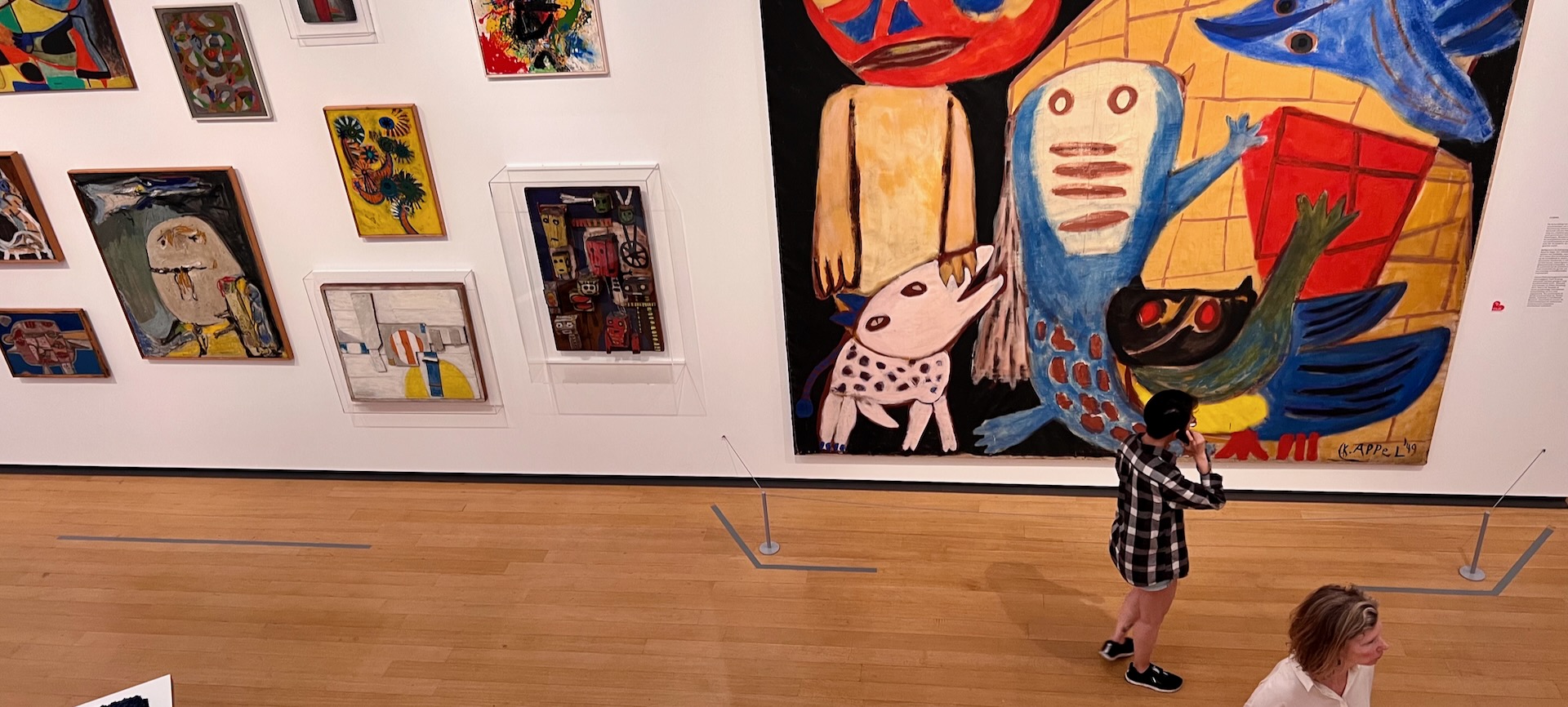
We visited the Stedeldijk museum, which on its outside looks like a giant bathtub and on its inside has an impressive collection of modern and postmodern art. I liked the Mondrian section.
Amsterdam has some pretty wonderful parks in the center. We loved the public space.
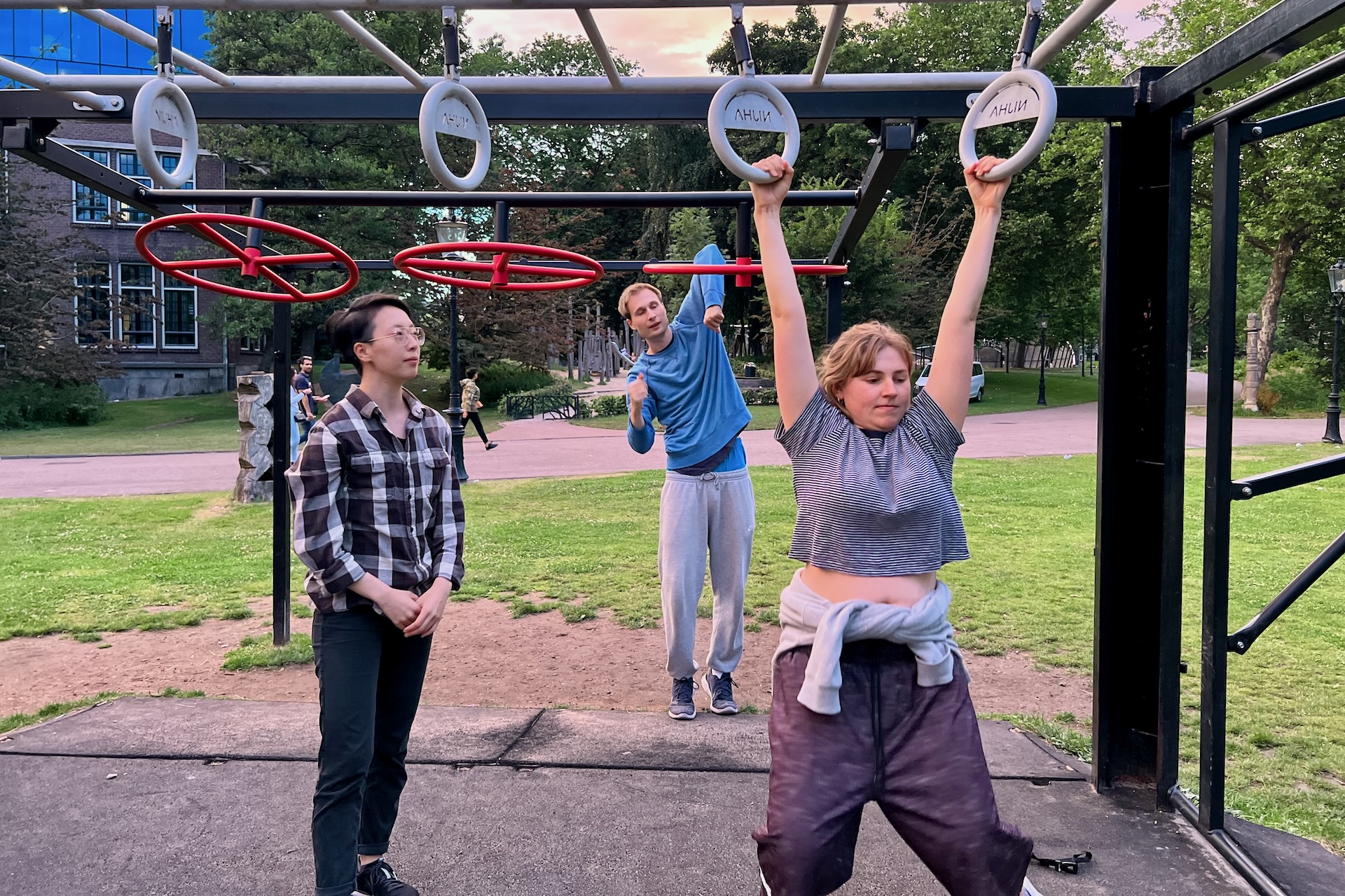
We also saw some pretty demented port-a-potties.
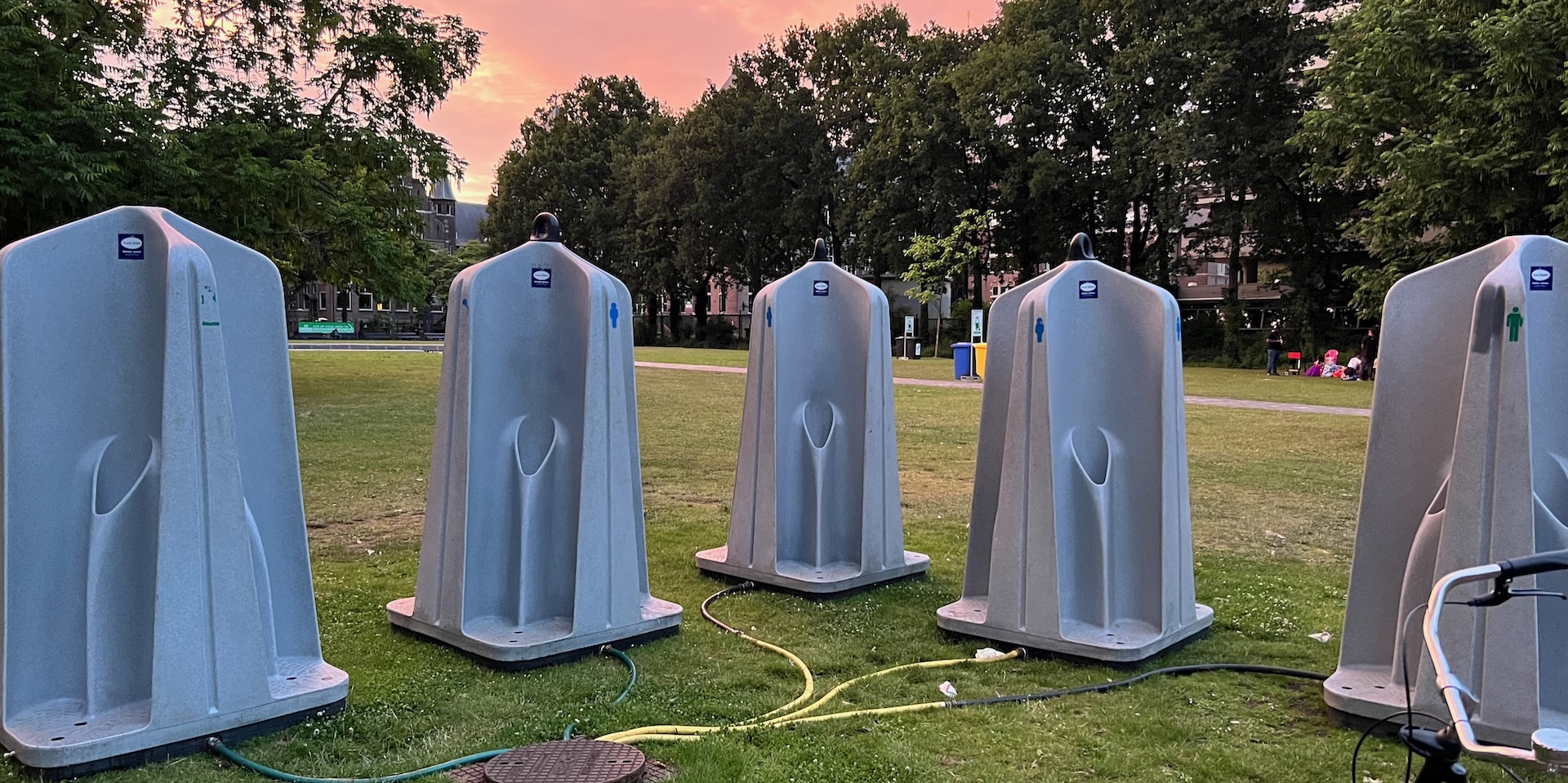
Seems tricky if you’re not a dude. Also, I'm not sure where you’re supposed to wash your hands here.
Surinamese food
I’d never had Surinamese food in the states. But in Amsterdam, Surinamese food is everywhere. It feels like a delicious fusion between Indian, Chinese, Indonesian, and Caribbean food.
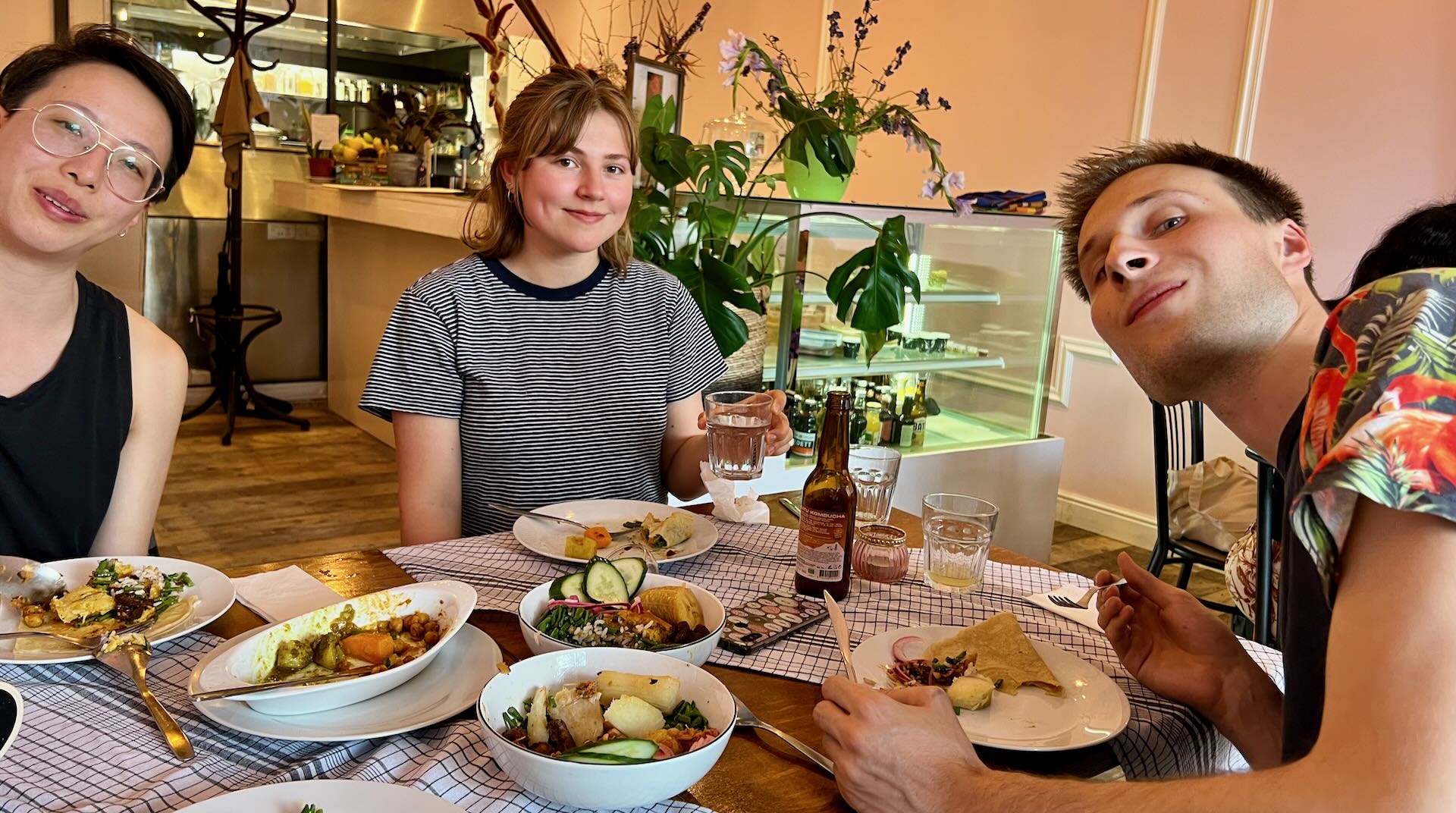
There's a lot of nuance and complexity here. Surinamese food in the Netherlands is deeply intertwined with the history of Dutch colonialism. Different Surinamese restaurants specialize in more Indonesian-Surinamese or Indian-Surinamese styles for instance. Most seem like more takeout or fast-food oriented, though the one we ate at in the above photo seemed pretty slow (but still delicious).
All I feel qualified to say is that the Roti was tasty and delightfully dough-y.
Het Amsterdamse Bos
Something that surprised me about Amsterdam was how close it is to nature. Het Amsterdamse Bos is like a 5k run away and yet it feels like a legit forest. We rode bikes there.
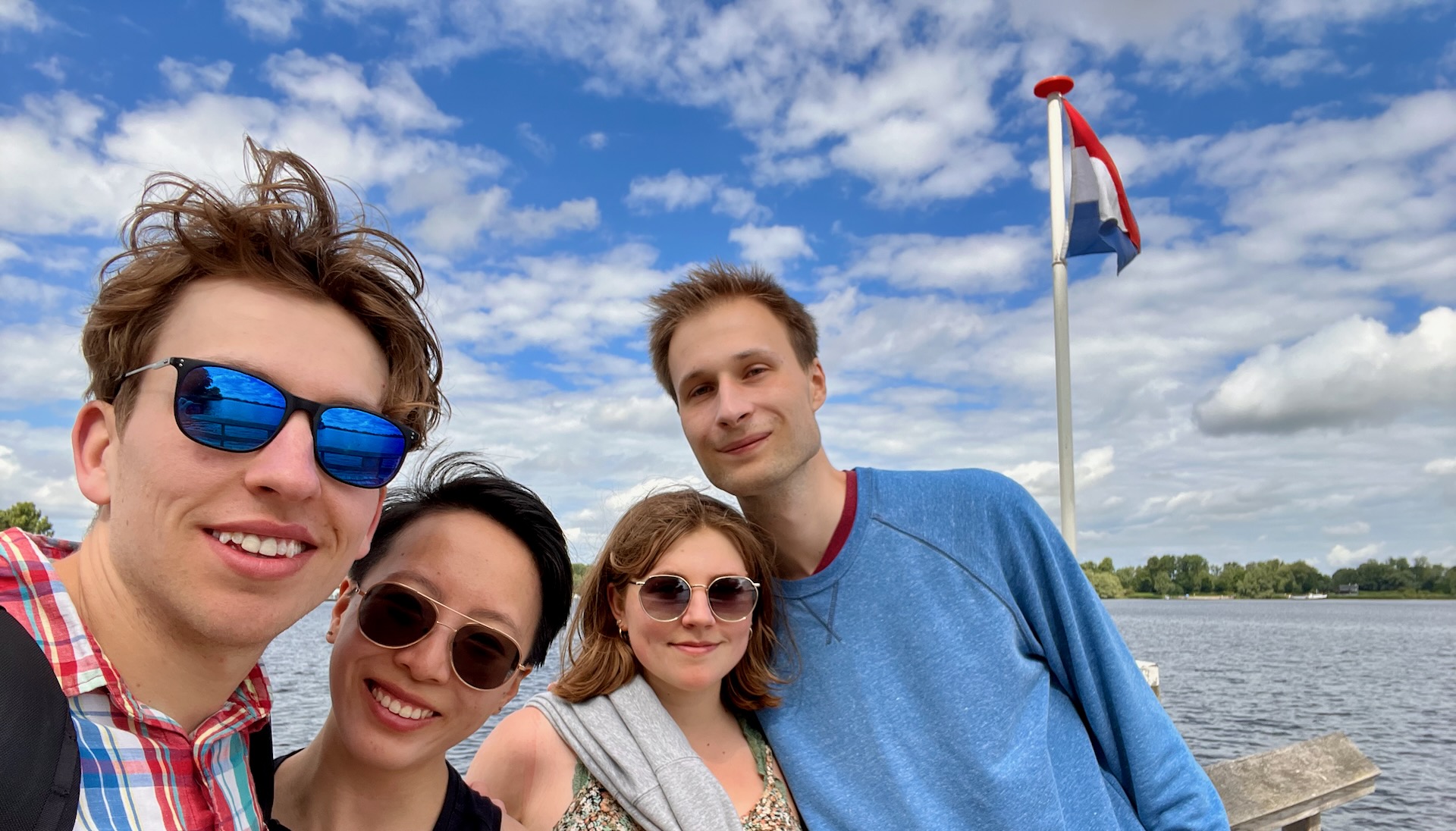
The only downside is that it’s right next to the airport, so we heard planes flying overhead constantly.
Amsterdam is also right next to a lot of farms. There are suburbs in between, but they feel less sprawling. Compared with the West Coast of the US, it’s a way different land use pattern.
Split, Croatia
After Berlin and Amsterdam, Paula left back to the US, and Dennis had to stay behind and work.
Zanny and I took an EasyJet to Split, Croatia. This was going to be our epic trip across the Balkans and back to Berlin.

I can’t say that Split was really on my radar before. We chose it in part because the flight was cheapest in the area.
Zanny and I both packed a single bag. The joy of onebag travel comes especially in the in-betweens of the journey. During the first day when we arrived to Split, there was a beach right next to the airport, which we checked out.
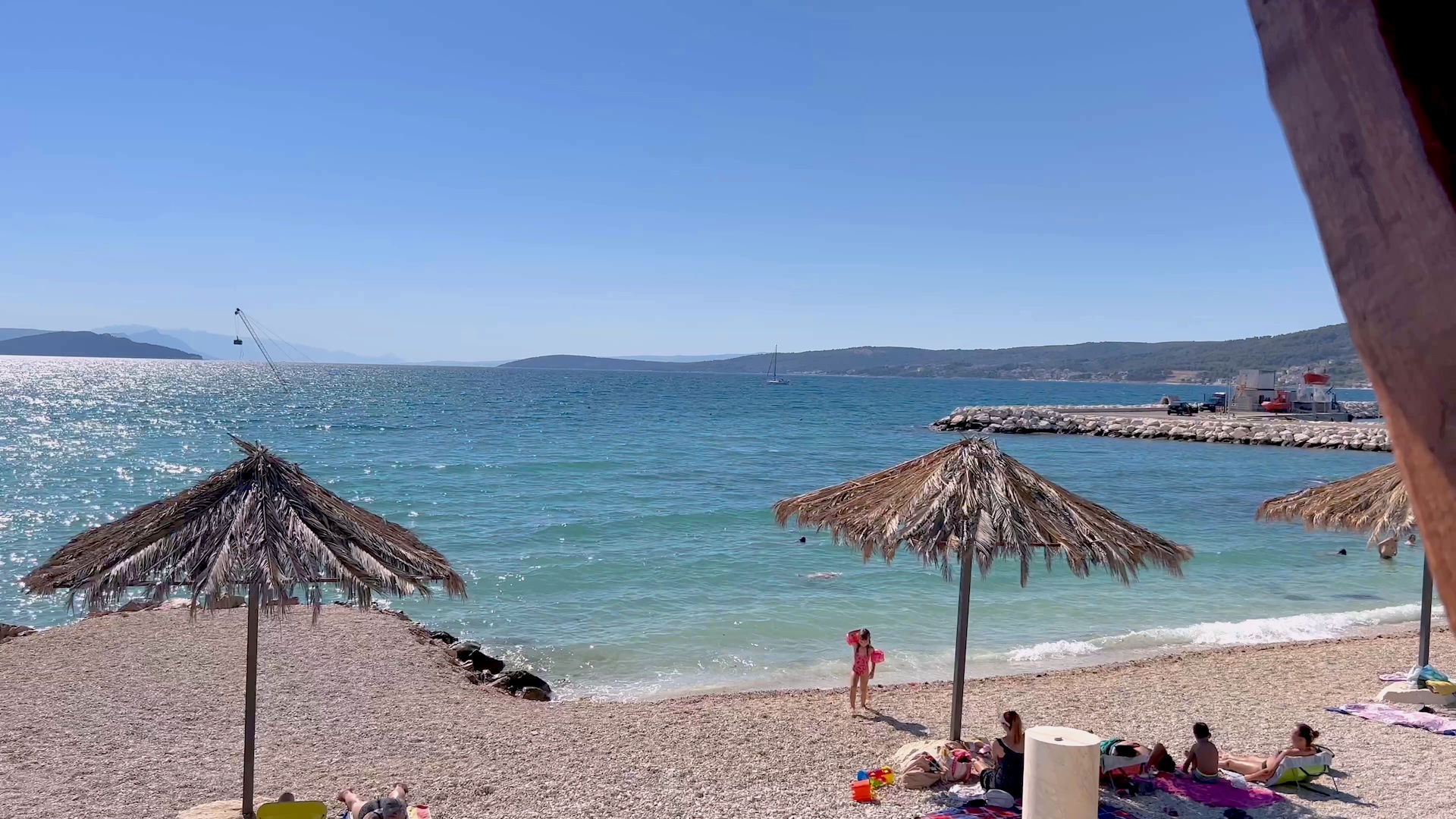
Then we went into the city on a bus.
Old town
Split (also) has layers of history.
The old town is well-preserved precisely because it was constantly used. It started out as a Roman Villa, then during the dark ages people used it as a giant fort to hide from Barbarians.
Kind of like Hochbunker Pallasstraße, but longer.
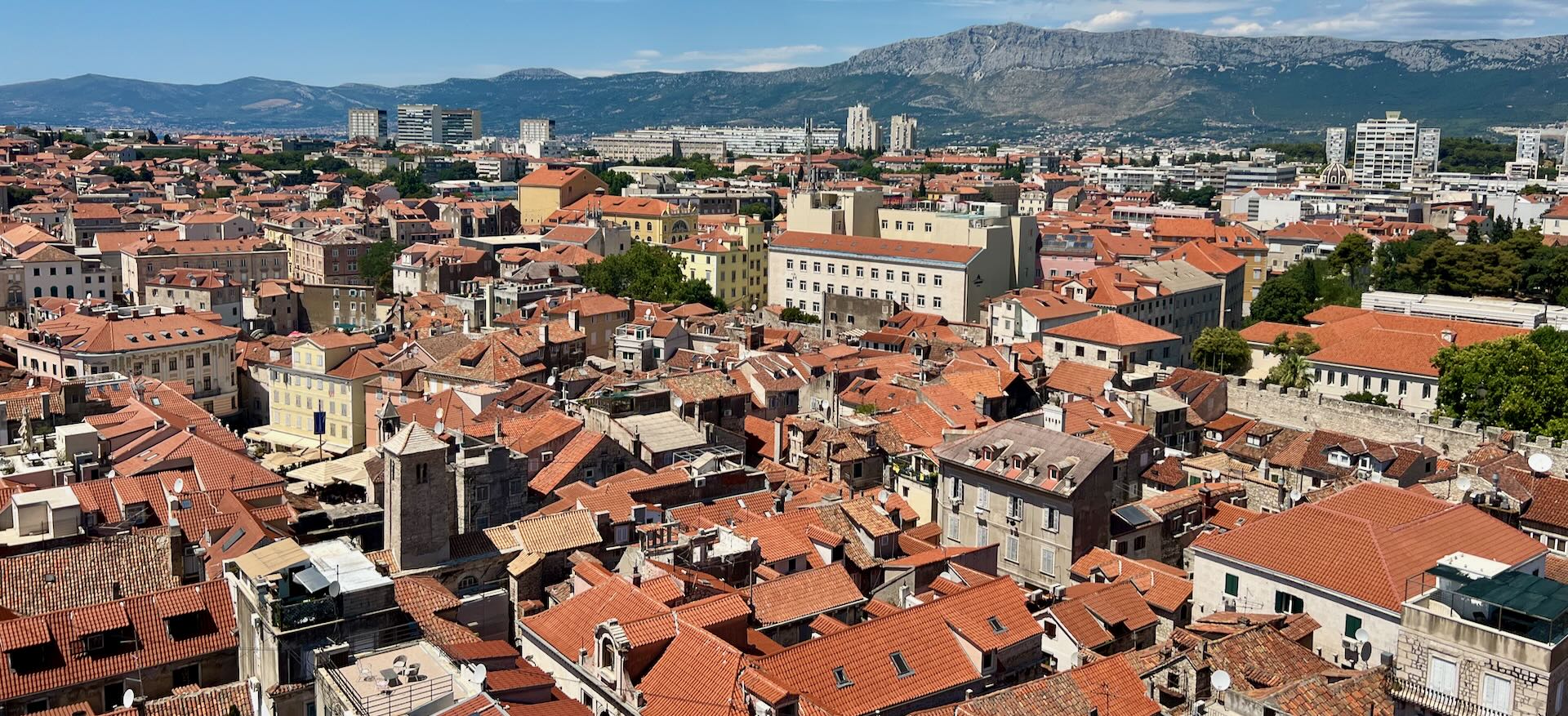
The harbor is relatively modern, it was infill constructed on Napoleon's orders.
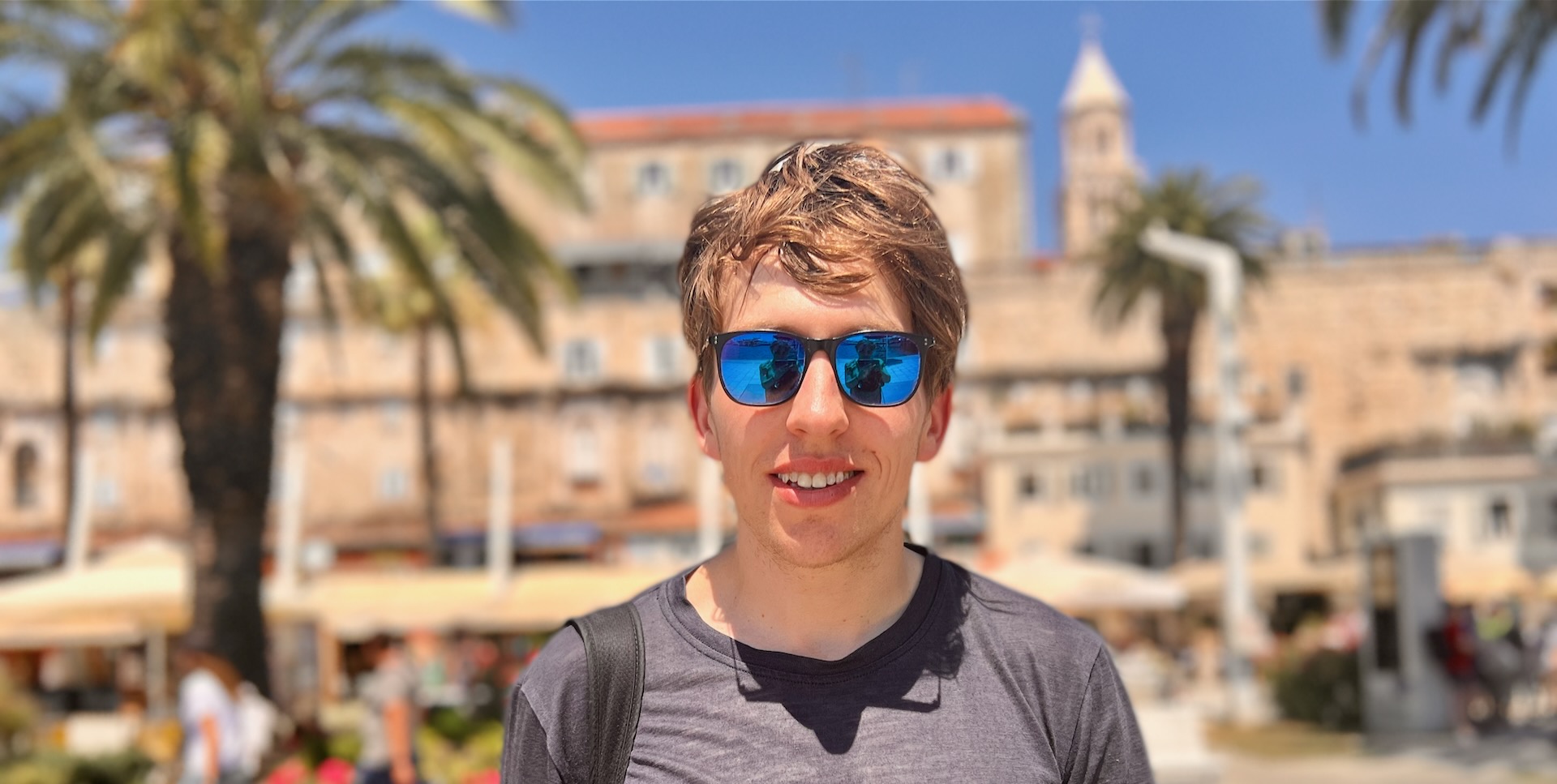
Farmers market
We went to a Farmers market. A lot of highlights here.
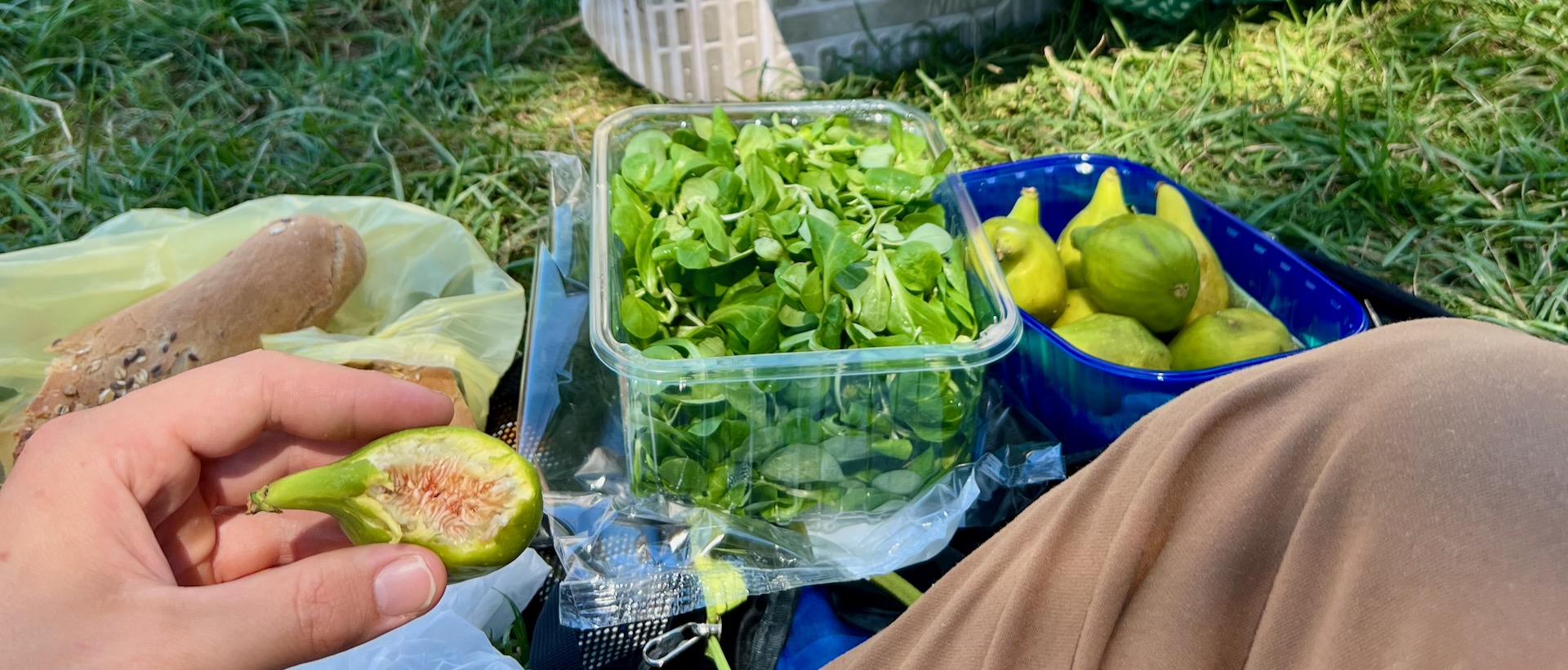
The Adriatic figs were delicious with notes of honey, with a little acidity. We had a delicious baked good that looked like a spinach Pizza -- Pita? Finally, I always get Maché when I'm in Europe -- we don’t have it the states for whatever reason. It tastes like arugula, but better.
Getting out
We took a flixbus on the way out. It was one of the most gorgeous bus rides I had ever been on, but also nerve wracking and windy. Definitely nausea-inducing.
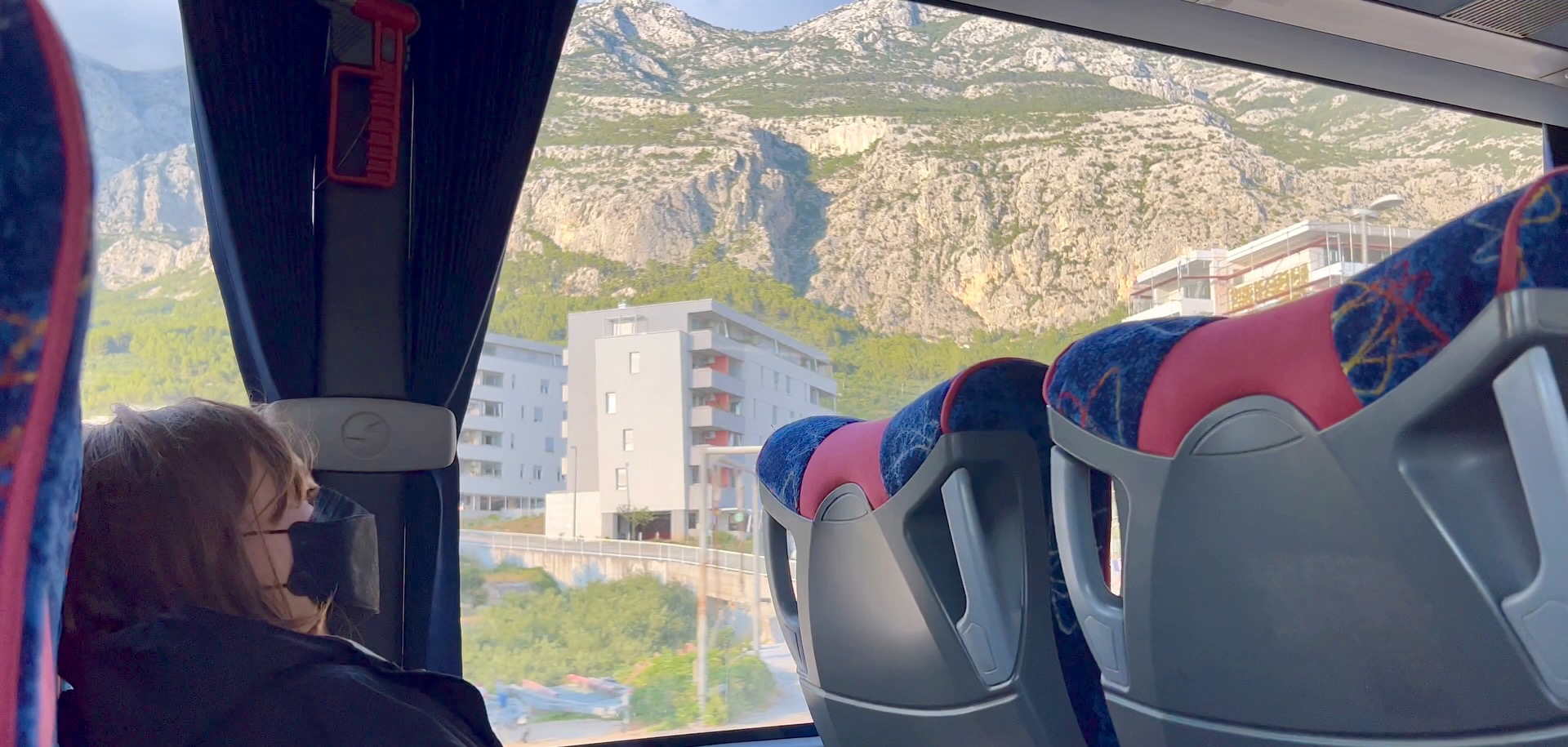
Croatia is situated right in between the mountains and the sea and it shows.
Mostar, Bosnia and Herzegovina
After a long border crossing, we made it to Mostar late at night.
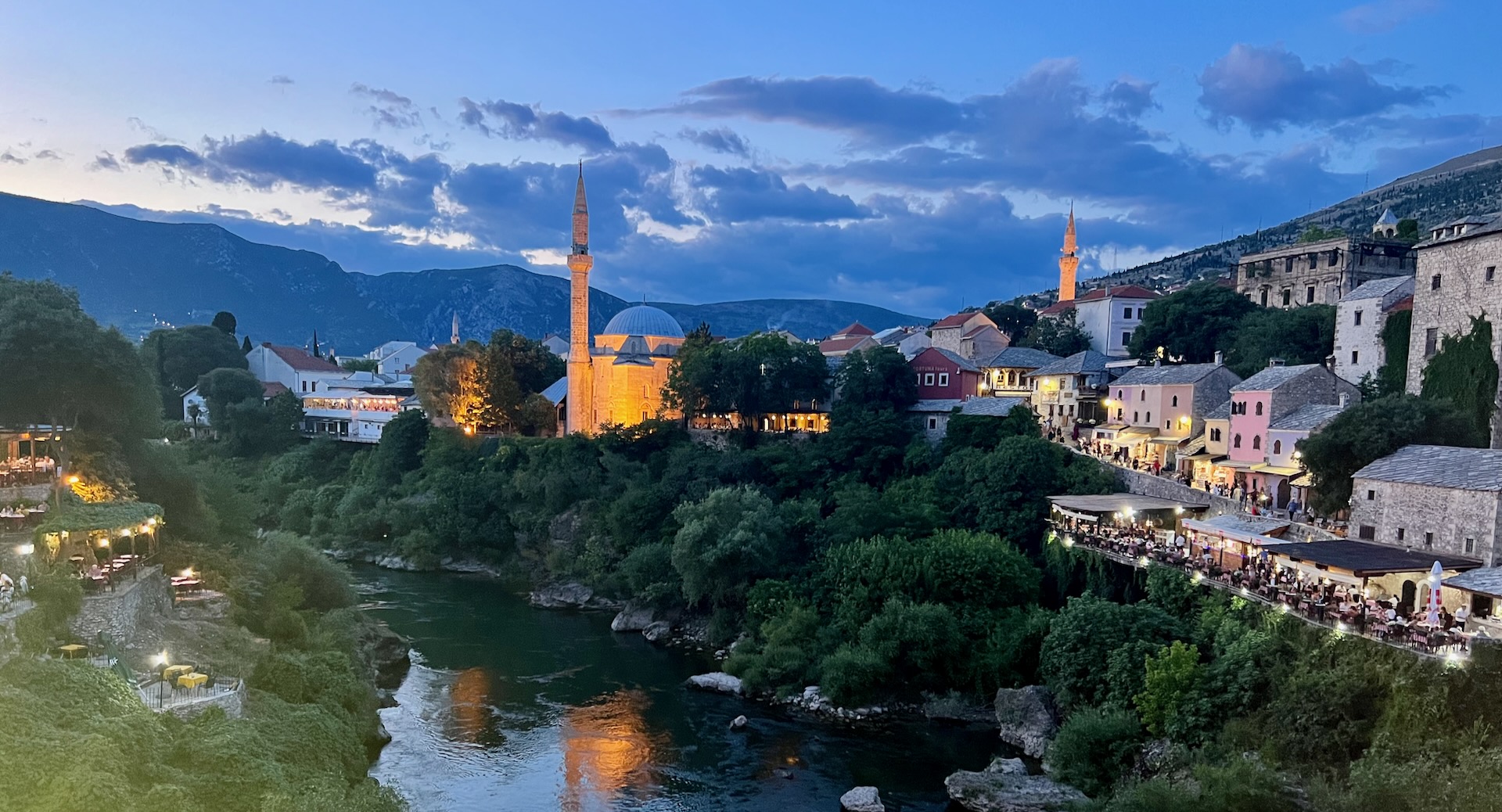
Mostar is in a valley surrounded by mountains, with a river running through it. The south side of the city is predominantly Bosniak Muslim. There are mosques, narrow cobblestone streets, and outdoor shops. There’s an important bridge that connects to the northern half.
We stayed pretty close to the old town, on the south side of the city. The building next to us was scuffed up from mortar shells.
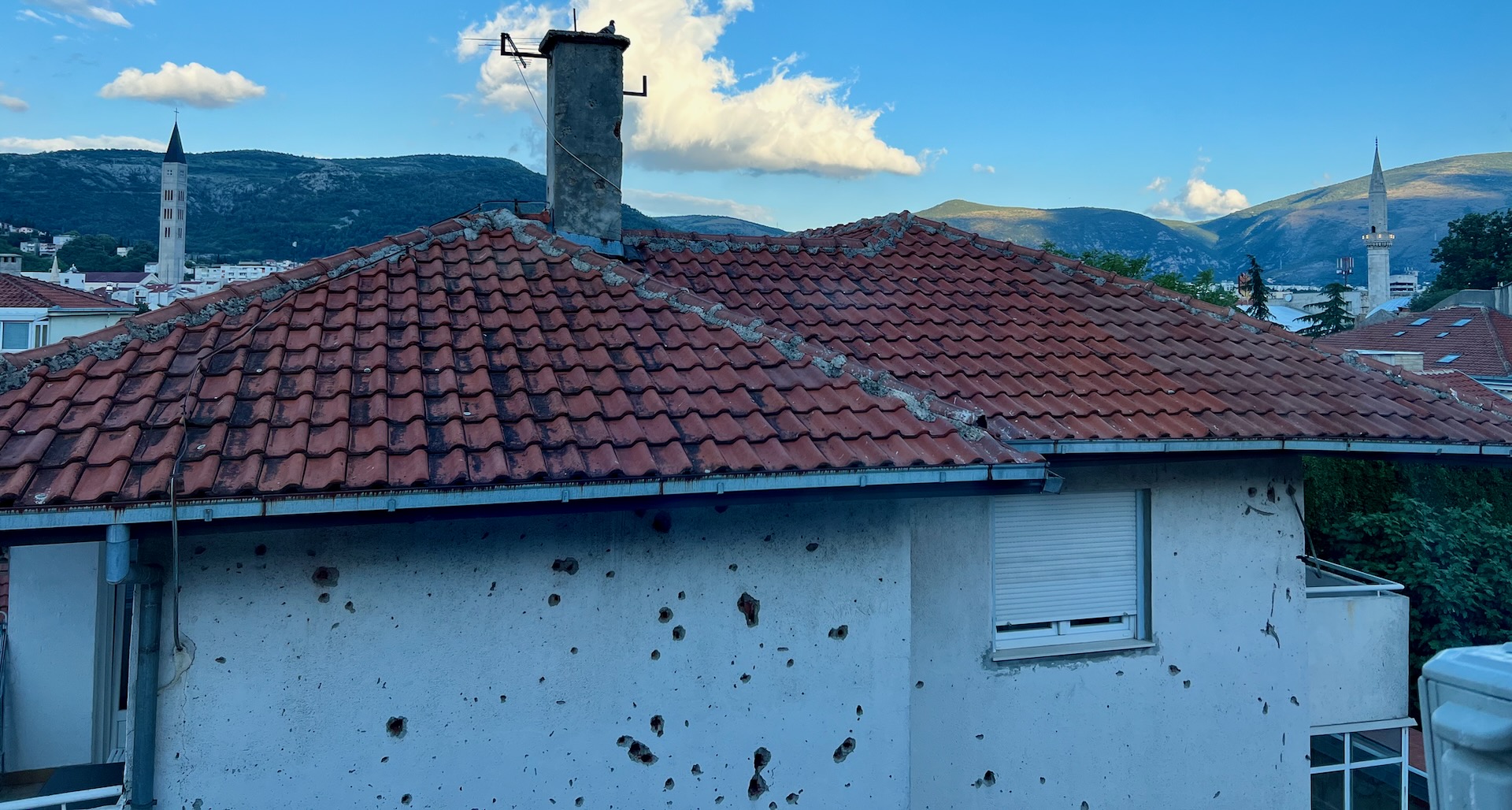
We were woken up the next day by the call to prayer. We checked out the old town and crossed the famous bridge.
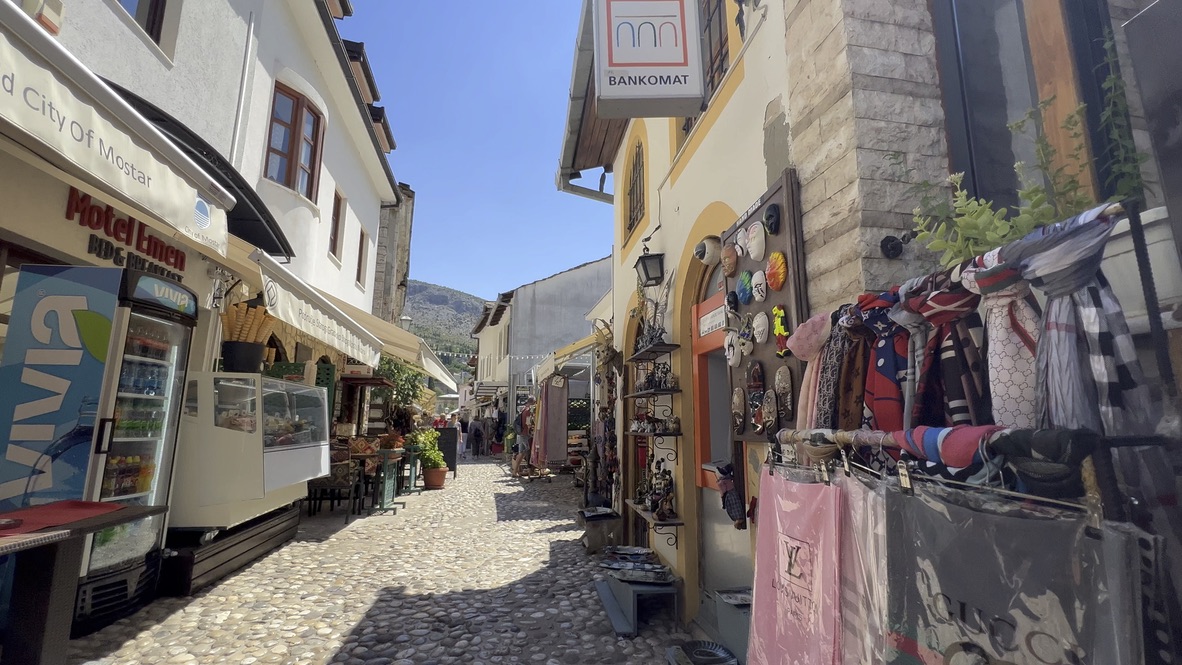
Conflict
The northern half of the city felt like a totally different world.
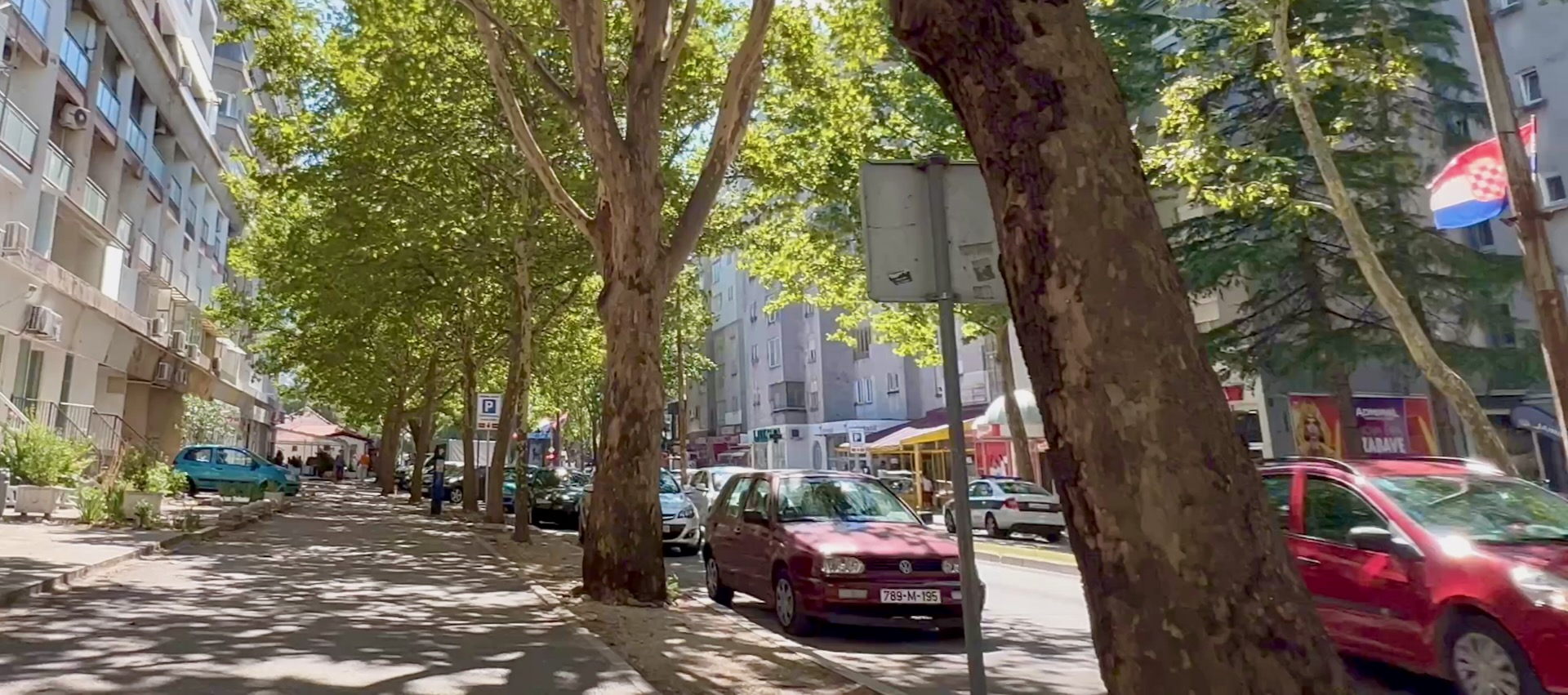
A lot more green space, and space in general. Instead of the Bosnian flag, people flew the Croatian flag.
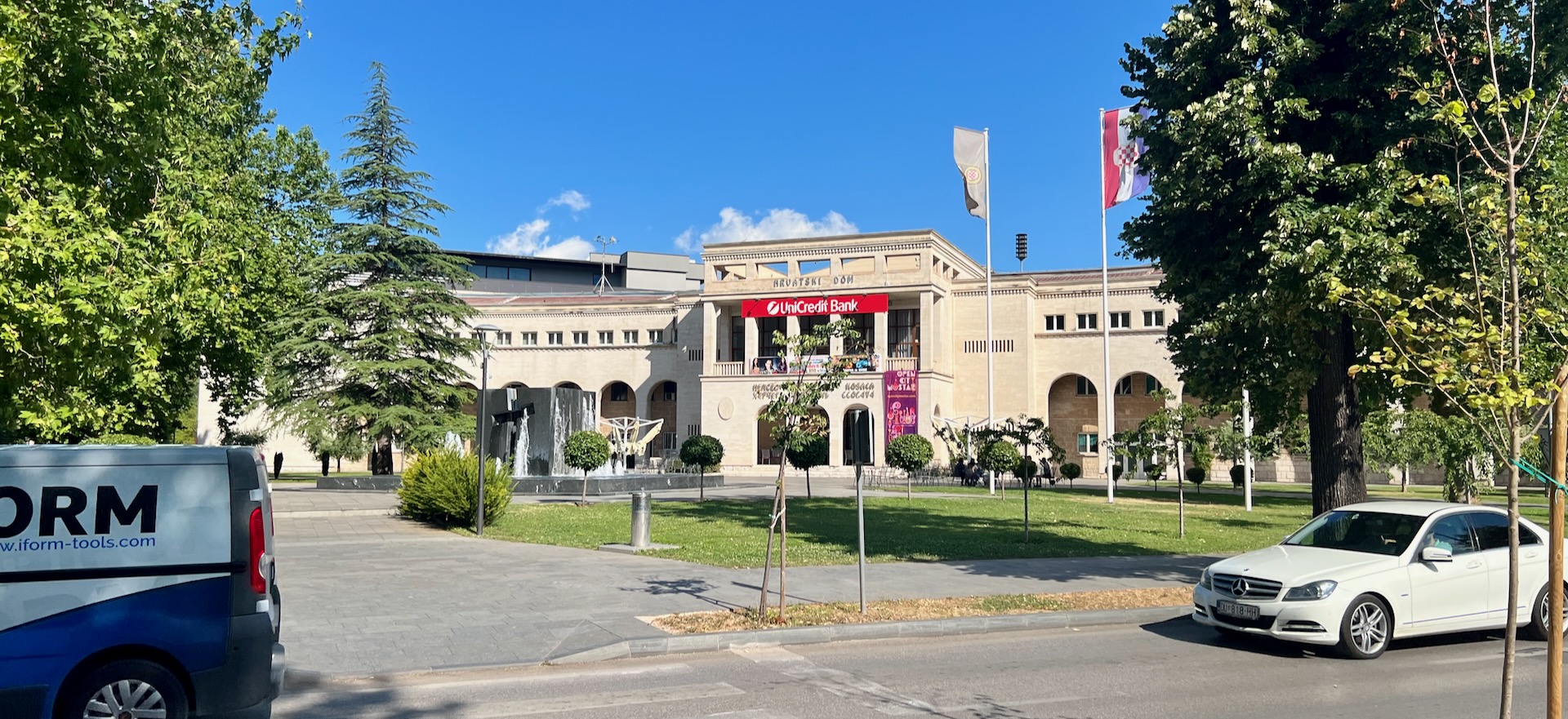
It felt eerie overall being in such a city that was so visibly segregated.
Later that day, we dug into Bosnian history a bit more, in a free walking tour. This was the first of these that we did -- we’d end up doing more in Sarajevo and Belgrade too. Our tour with Ševko here in Mostar was by far our favorite one. The tours are nominally free, but set up by volunteers; it’s expected that you pay a donation at the end.
Ševko took us around the city, explaining not just what happened during the Bosnian war but offering his own story.
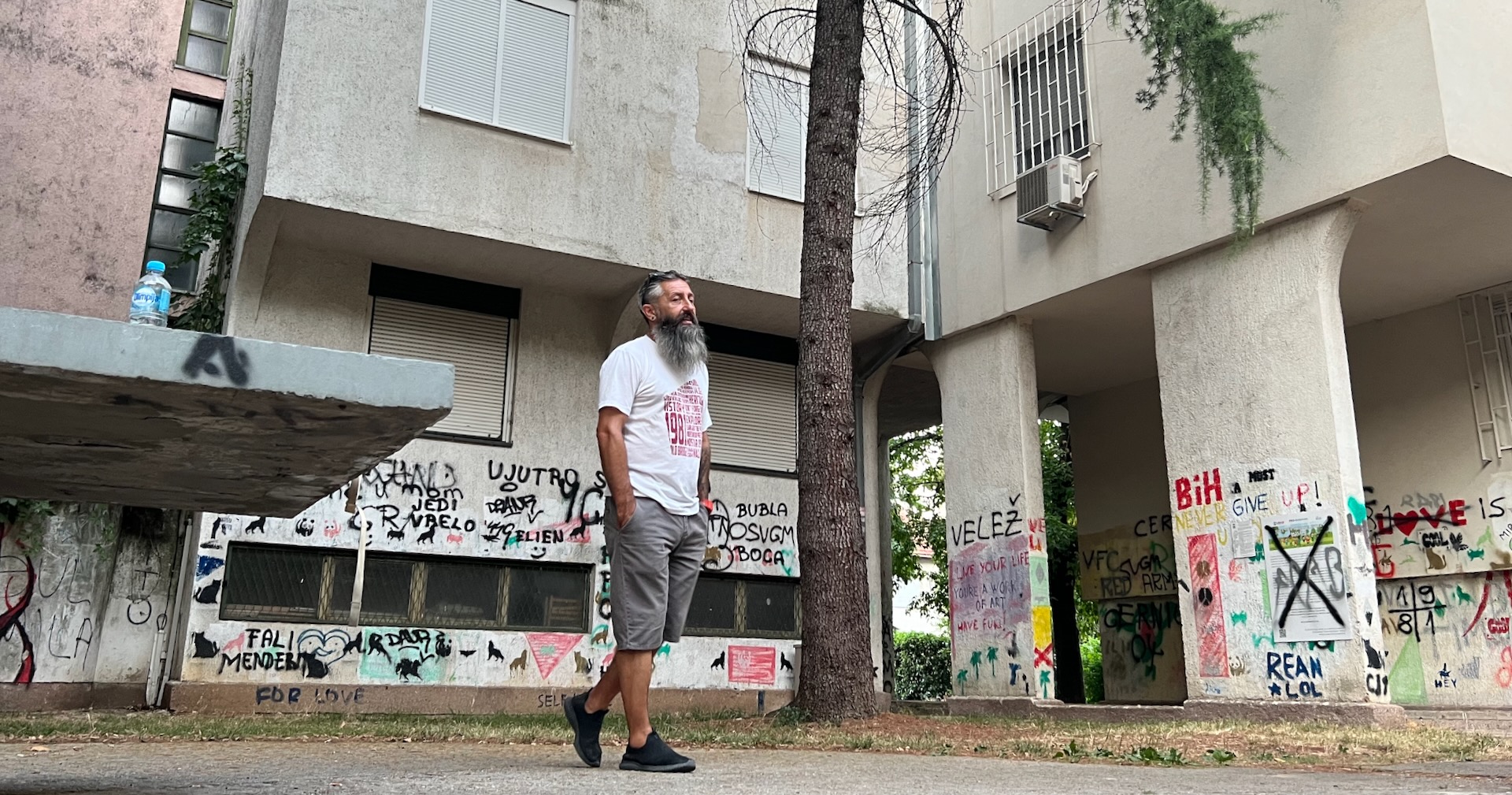
The Bosnian wars were 30 years ago, but the scars and trauma visibly remain. We walked by the river, which was the most dangerous part during the time of the civil war. The concrete walls still had mortar holes.
And of course, during the war, the bridge was destroyed completely. It was rebuilt so that the city would qualify for UNESCO world heritage status.
He took us to a traditional coppersmith’s shops, and pointed out this piece as a symbol of the city.
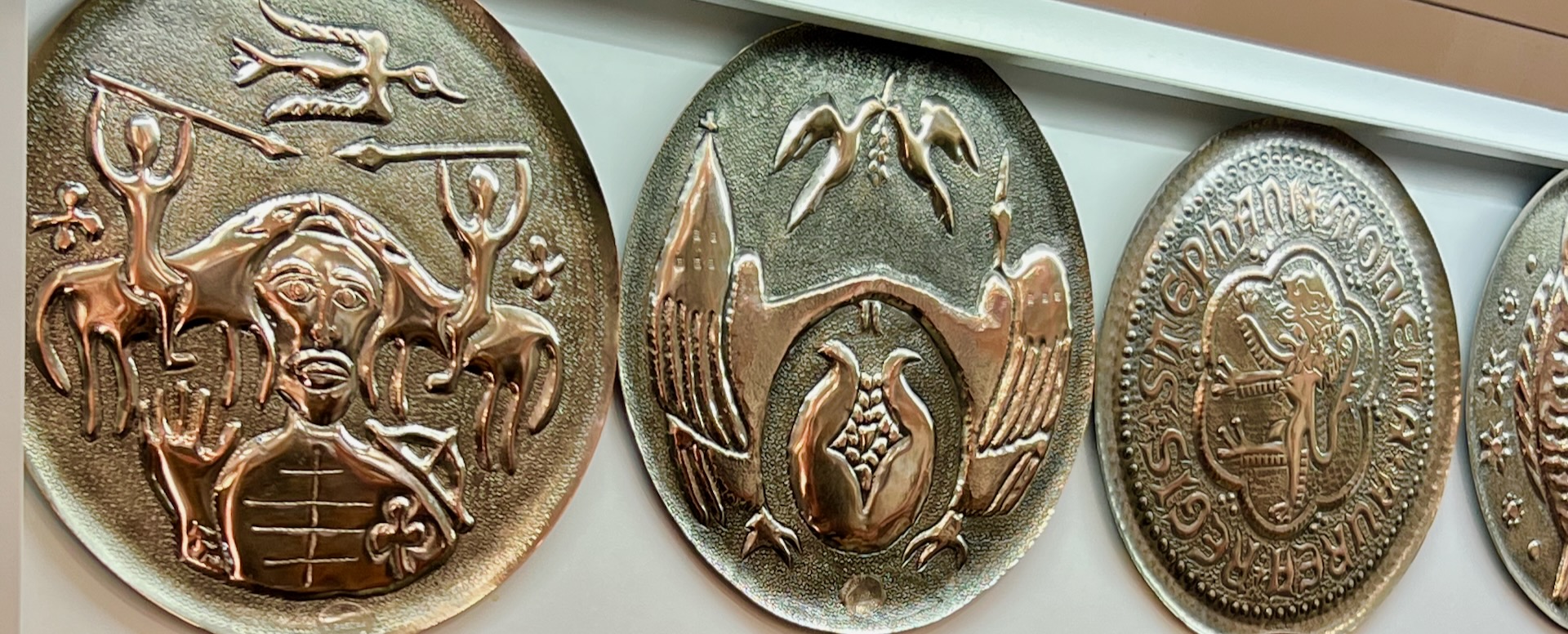
The middle plate shows two sides of the city with two doves overhead (and doves) for peace.
Food and culture
It’s weird looking from the outside on the city’s conflict, because in some ways the two sides felt super similar. Food brought that out for us.
Ajvar was popular throughout.
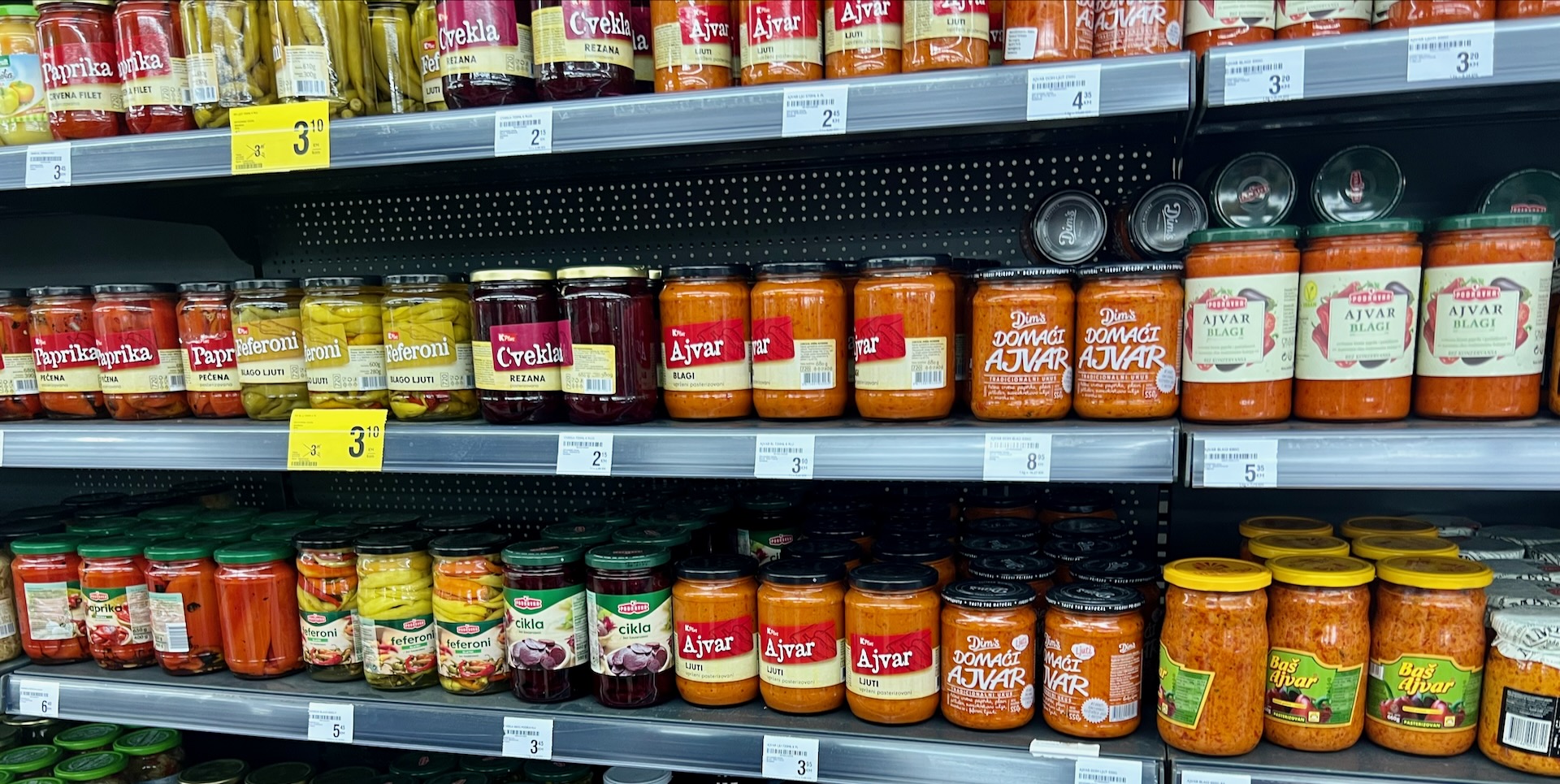
We had some amazing Bürek, though here it’s called Pita. Bürek is specifically a Pita that has meat in it, so not for us vegetarians. Potentially confusing!
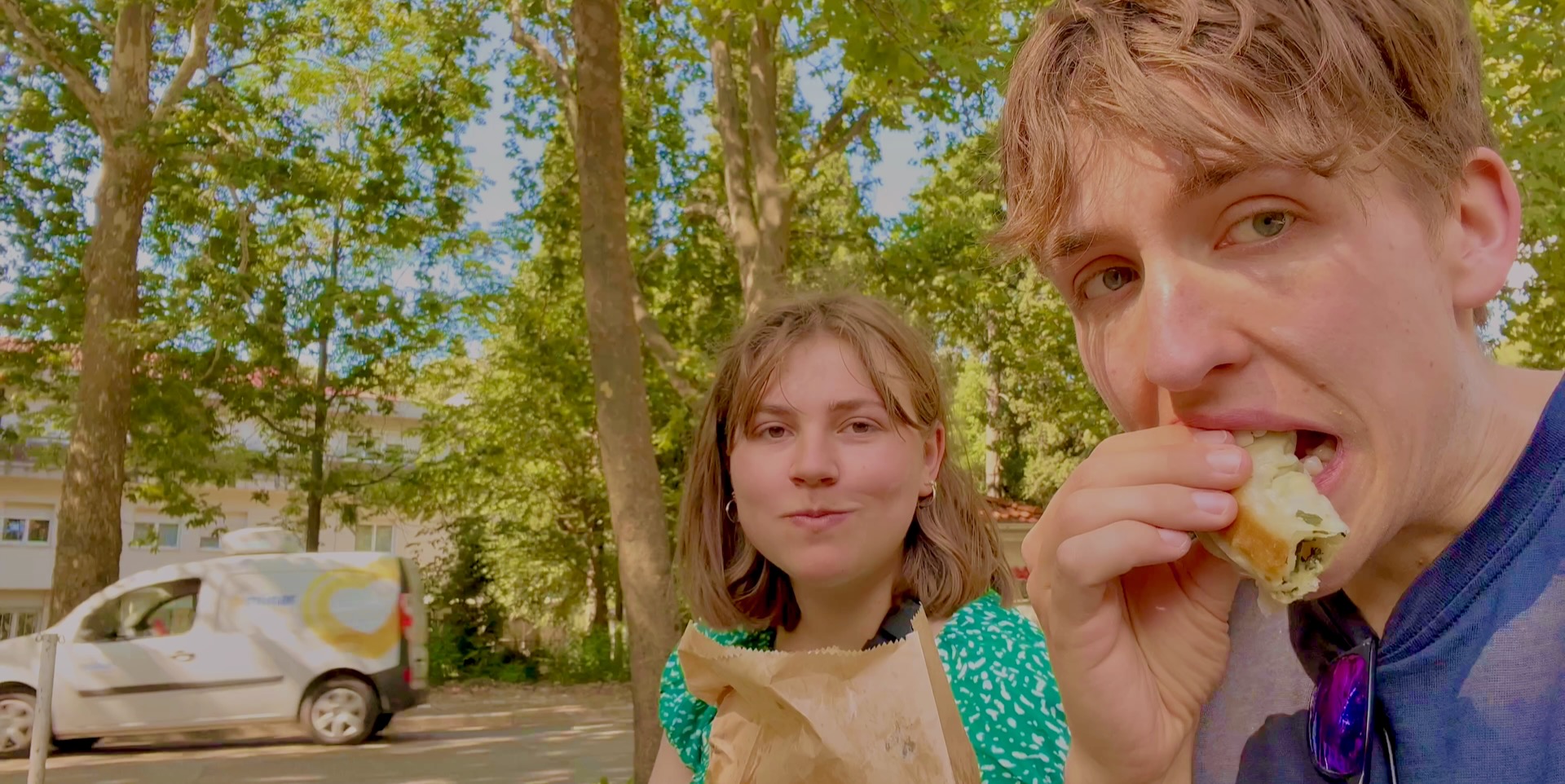
All the signs were written in the same language, but for political reasons Bosnian, Croatian, and Serbian (BCS) are legally different languages. Zanny memorized the BCS numbers from 1-10 and we both memorized some basic phrases; though the greetings we learned for “hi” were different in the various dialects: “Bok” in Croatian versus “selam” in Bosnian.
A fantastic train ride to Sarajevo
The next day we boarded a train to Sarajevo.
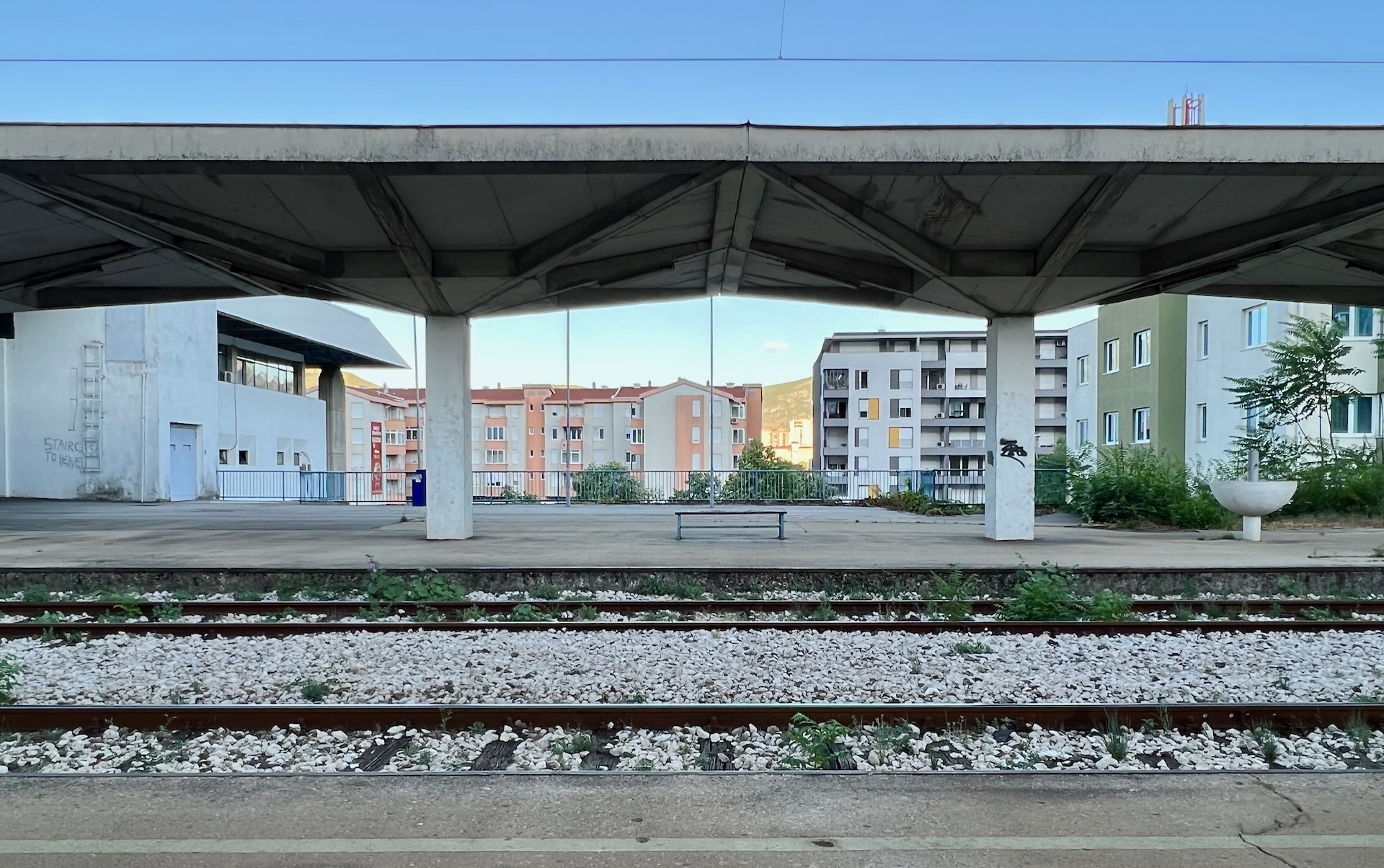
This platform reminded me of Hungary. Sometimes, the trains would just come on the most random platforms. This one fit the bill.
Surprisingly, the train itself was super modern and the voyage was probably the most impressive train ride I’ve ever been on.

Sarajevo
We arrived at another old train station. I was excited.
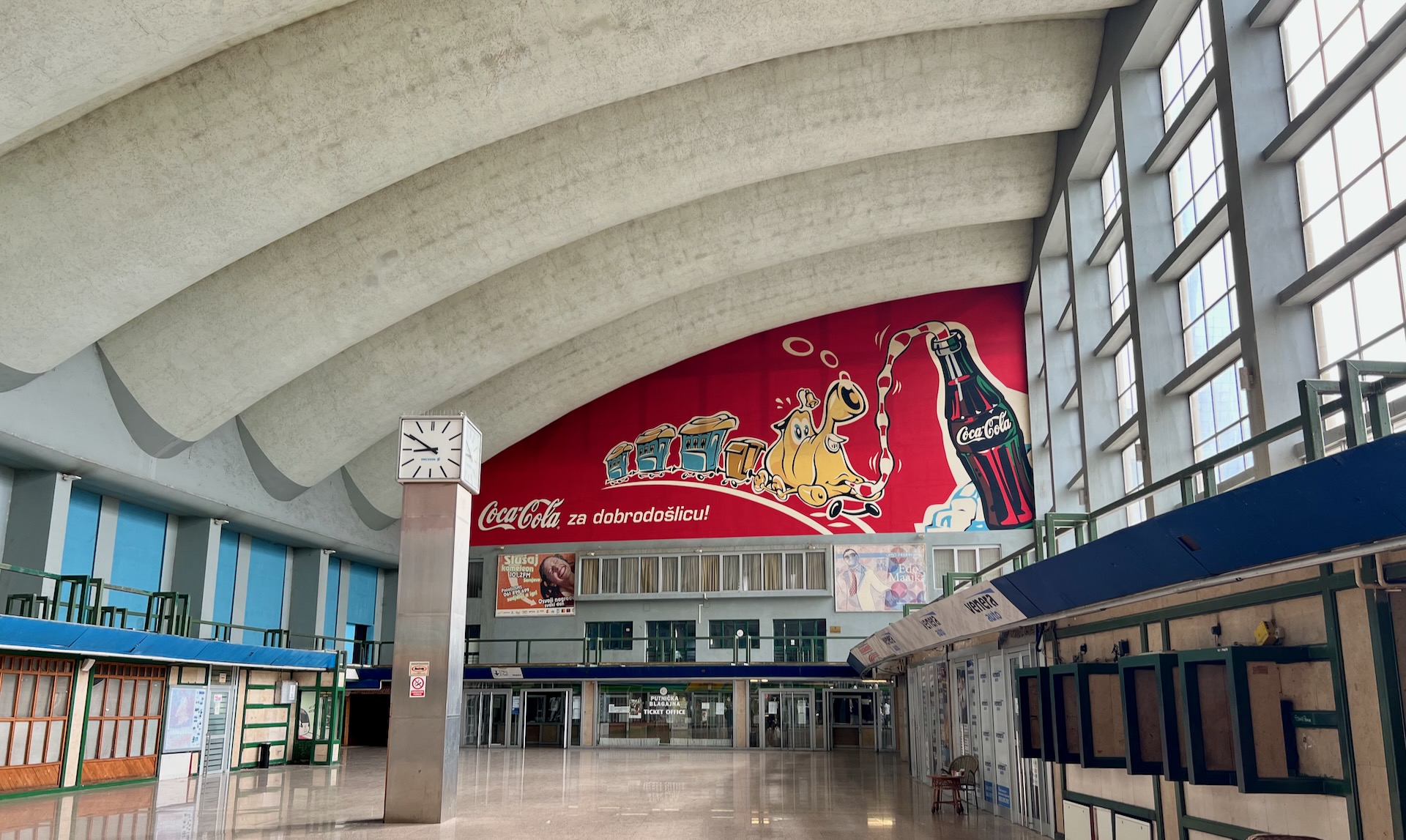
Sarajevo was the whole reason I wanted to visit Bosnia.
I did a semester abroad in Hungary back in 2014. One of the staff at my study-abroad institution had visited Bosnia with her husband - Sarajevo in particular. She said that, even though they got pickpocketed and lost expensive camera gear, Bosnia was one of their favorite countries.
We thankfully didn’t get pickpocketed, and had a great time. Though – it’s a bit hard to use that term when acknowledging all the tragedy and hardship that Bosnia and Sarajevo in particular has gone through.
Olympic History
We took a cable car to Trebević, a mountain overlooking the city.
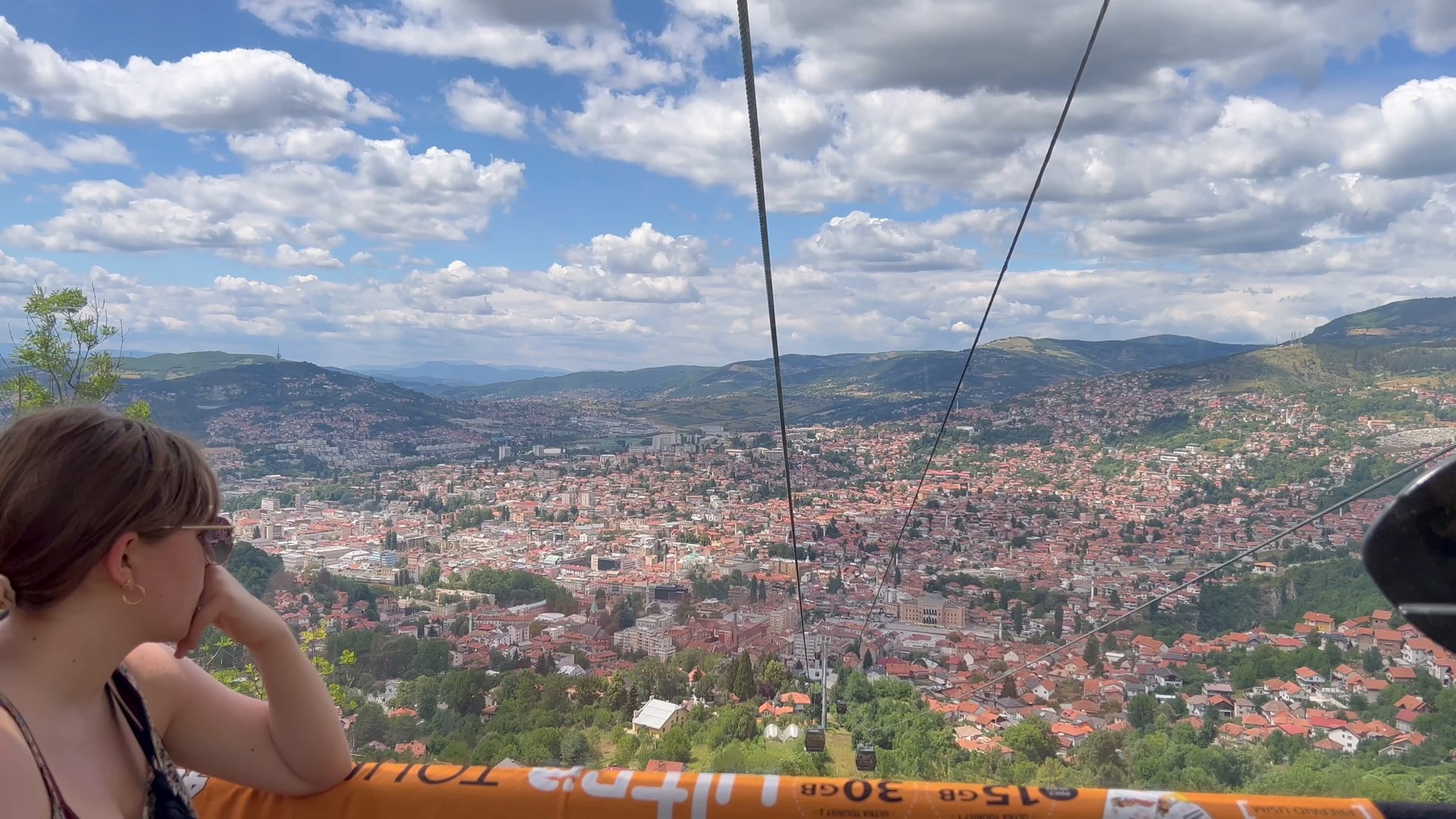
Sarajevo is (also!) a gorgeous city in a valley. The city is more or less organized in a line. Most of the tourist attractions, and our hotel, were on the eastern side near the old town.
Sarajevo was the host of the 1984 Winter Olympics, which is when the cable car was built. The games must have been a landmark event for the city. One could totally imagine them offering a window into the future where Bosnia is just another normal country.
Of course that future didn’t end up happening. The war would be 8 years later, during which time military forces used things like the bobsled track as an artillery fortification.
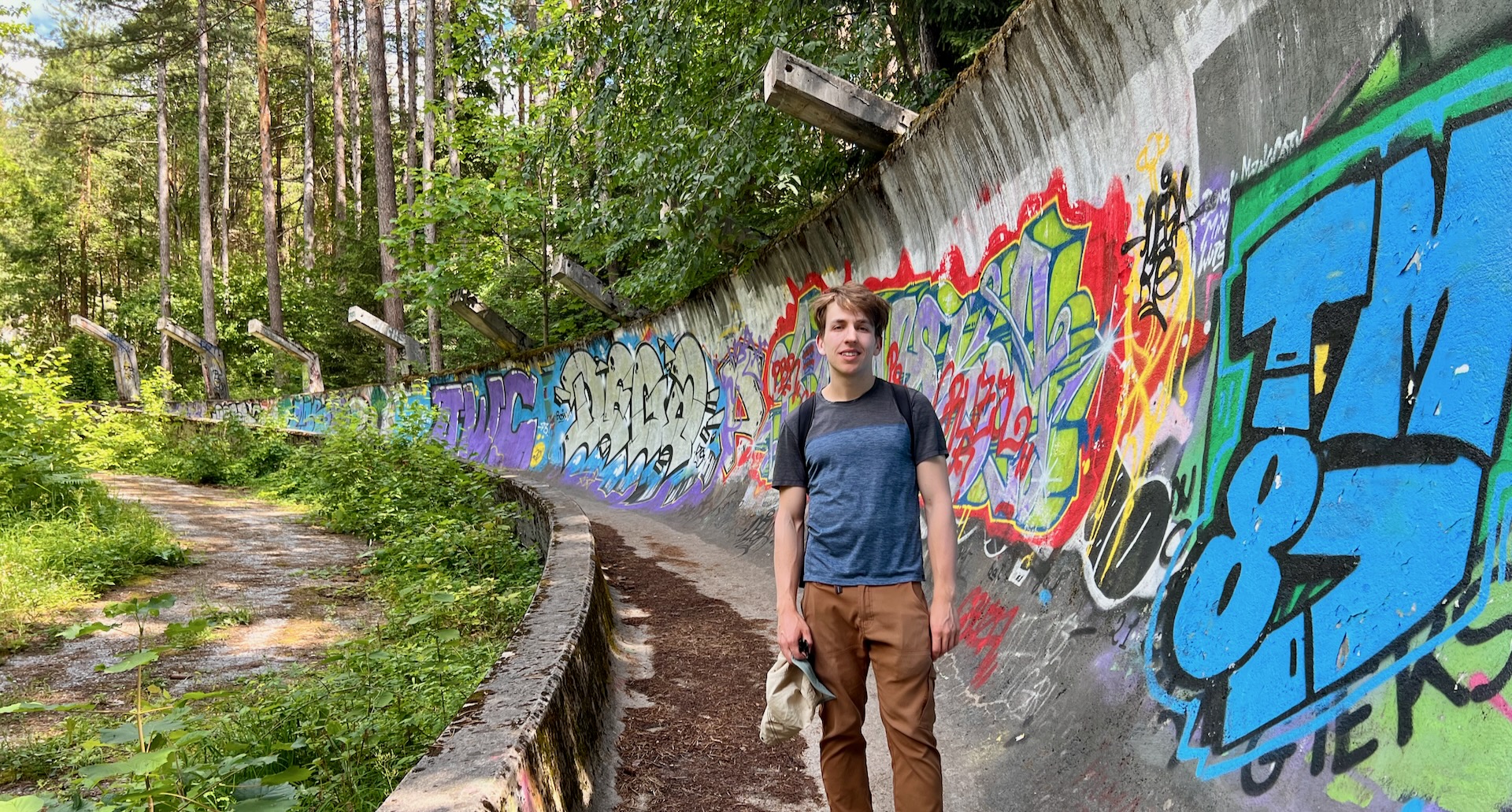
The track is still in disrepair, though at least the area we could explore was de-mined.
Sarajevo Old Town
We returned and checked out the old town, steps away from the cable car base.
The old town dates back to the 15th century.
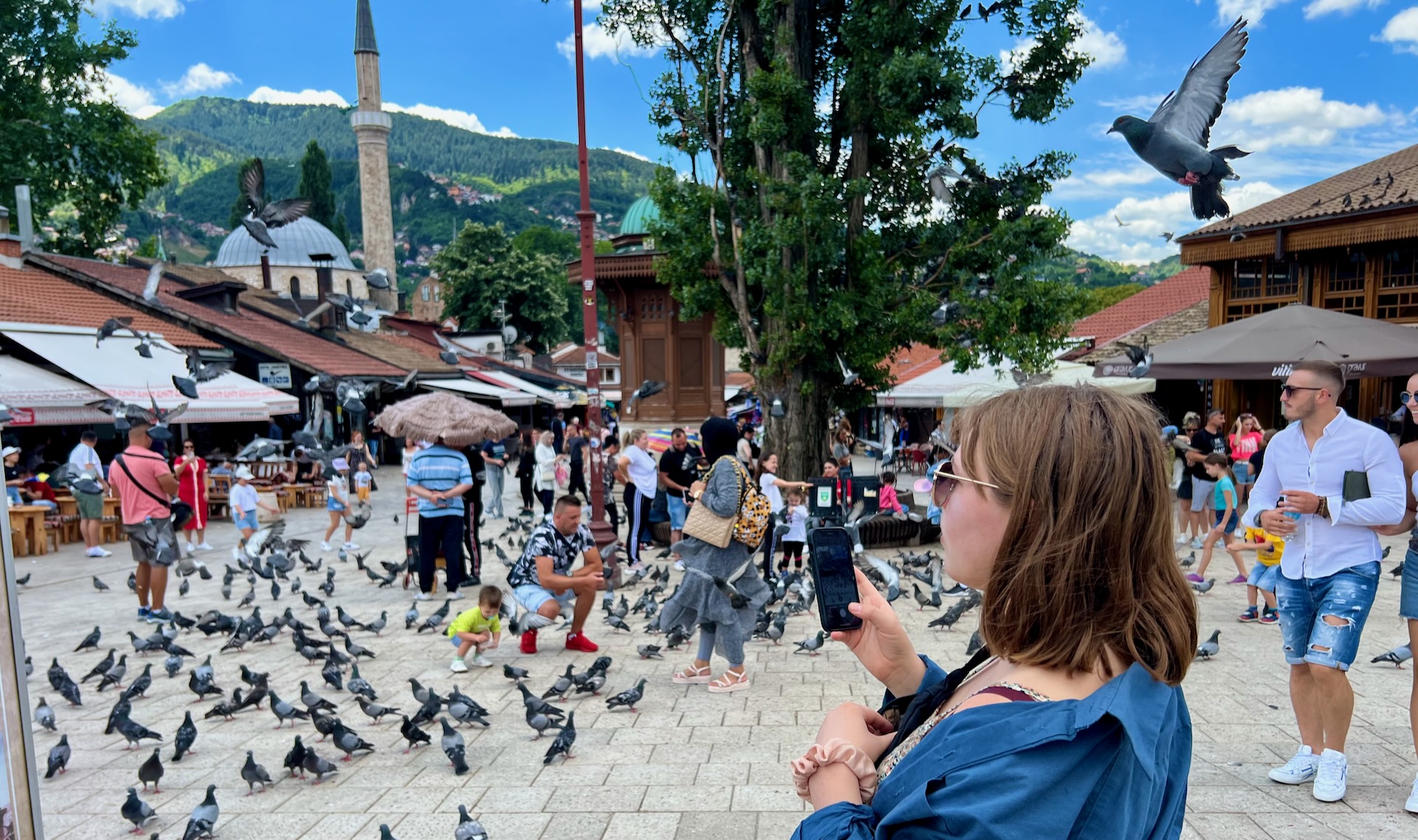
It had cool architecture, lots of shops, and pigeons.
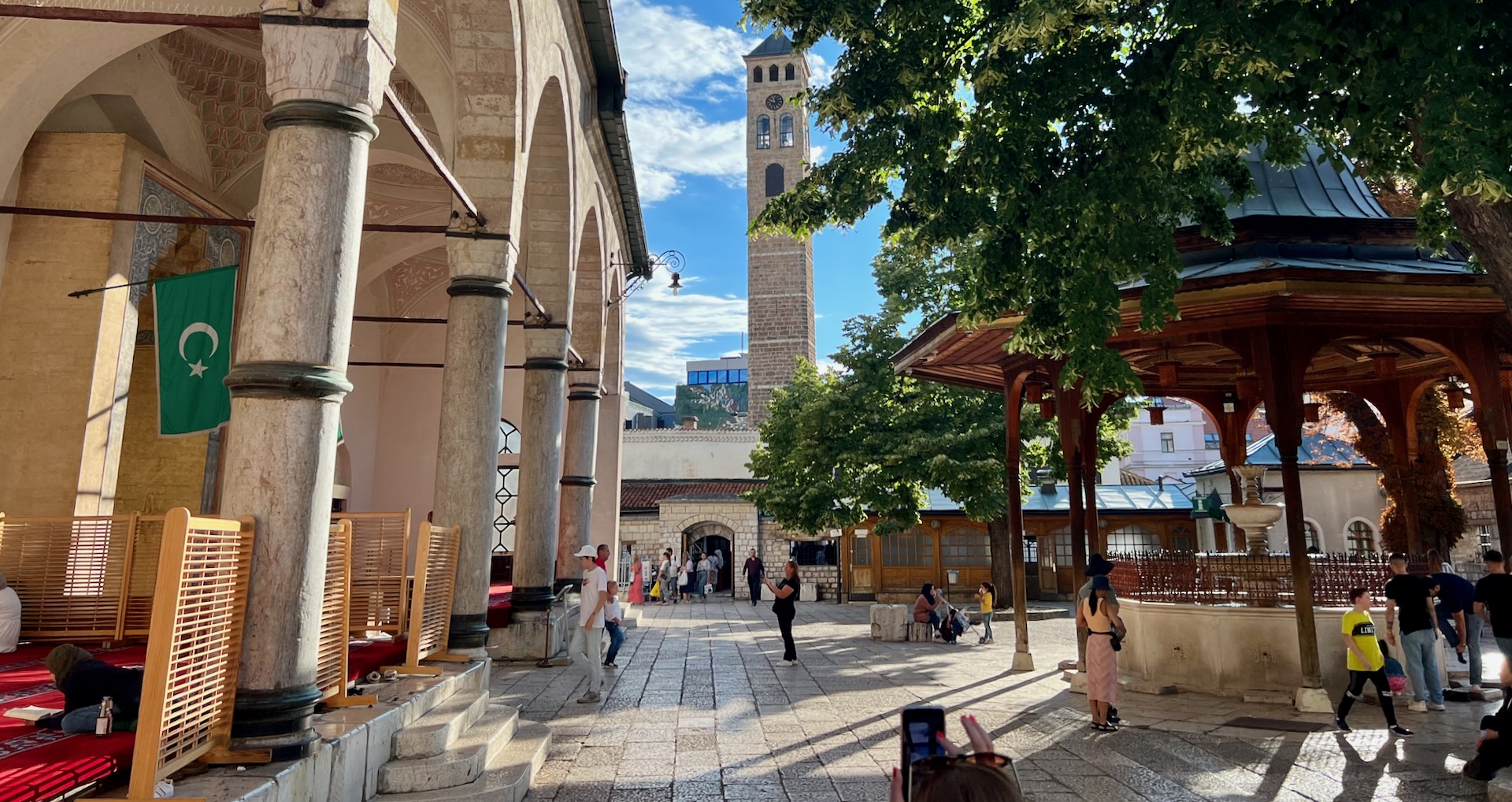
We checked out the Gazi Husrev-beg Mosque. It still seemed like it was in active use.
One perhaps minor thing that I nonetheless appreciate – you can fill up water at the water fountain for free. That’s a thing at the mosques we saw, and it’s rooted in Islamic tradition. Water fountains seem so much harder to come by in Europe versus the US.
Food, prices, gridlock
The old town had some fantastic food. Our favorite food was Grah (beans). We pretended that they were vegan.
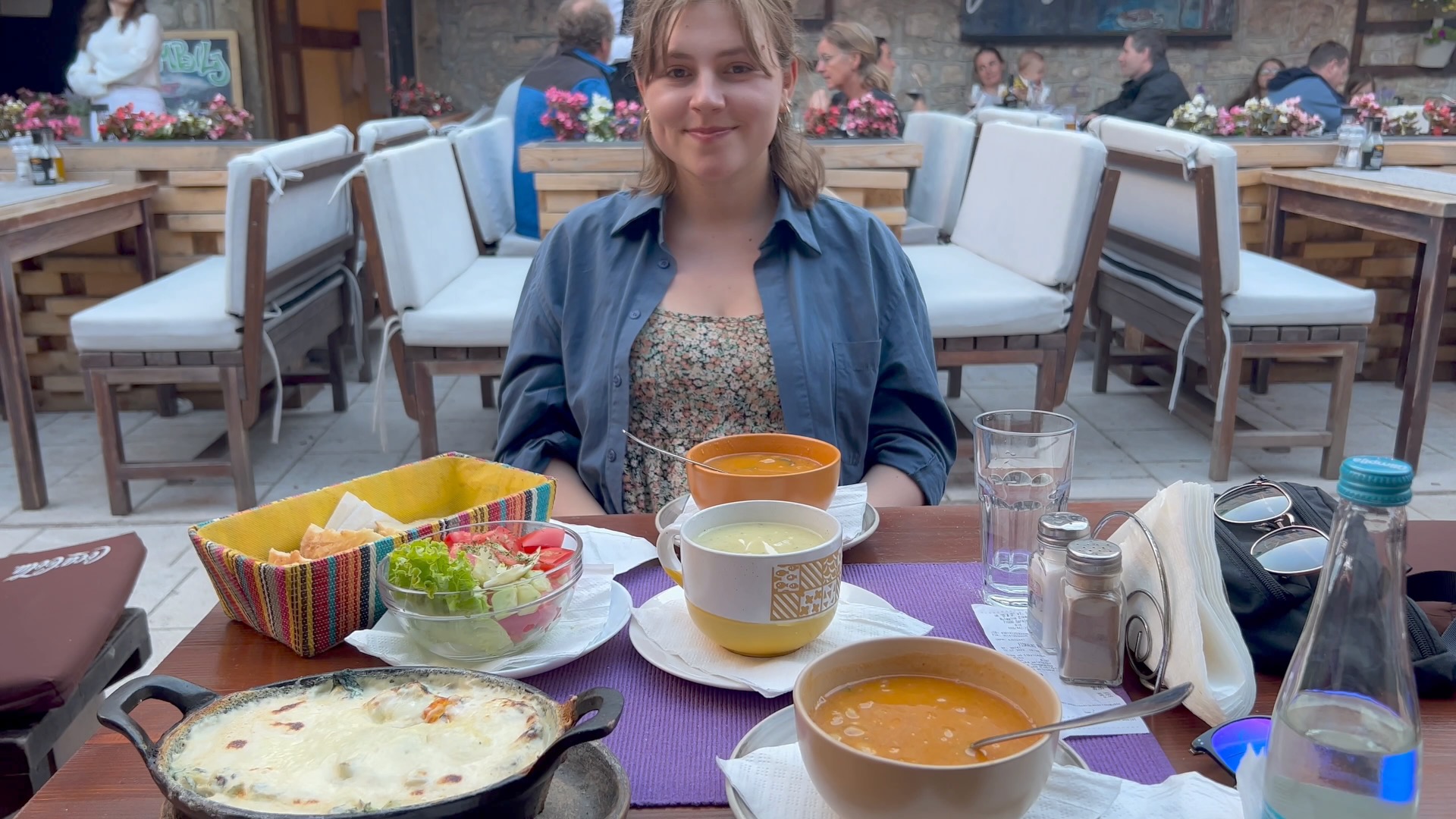
There were lots of other delicious food items. There were stores selling flaky freshly made Pita, baked in what looked to be cast-iron Dutch ovens covered in hot coals. You ordered slices and paid by weight. I was told to try the Pumpkin Pita but couldn't find any. The Spinach Pita was still rich, cheesy, and delicious.
Coming from the US, all the food here was very inexpensive.
Bosnia’s currency is the “KM” aka Konvertible Mark, which is an interesting abbreviation as it’s spelled the same as Kilometer. It’s pegged to the euro, at the rate of 2 KM for 1 Euro. A meal like the above would set us back around 20 KM.
This note about the currency is part of a recurring pattern. Bosnia is so gridlocked between Serbs, Bosniaks and Muslims that the official government can’t really do much (like have its own independent currency). This currency arrangement was set up from the Dayton Agreement which settled the Yugoslav wars.
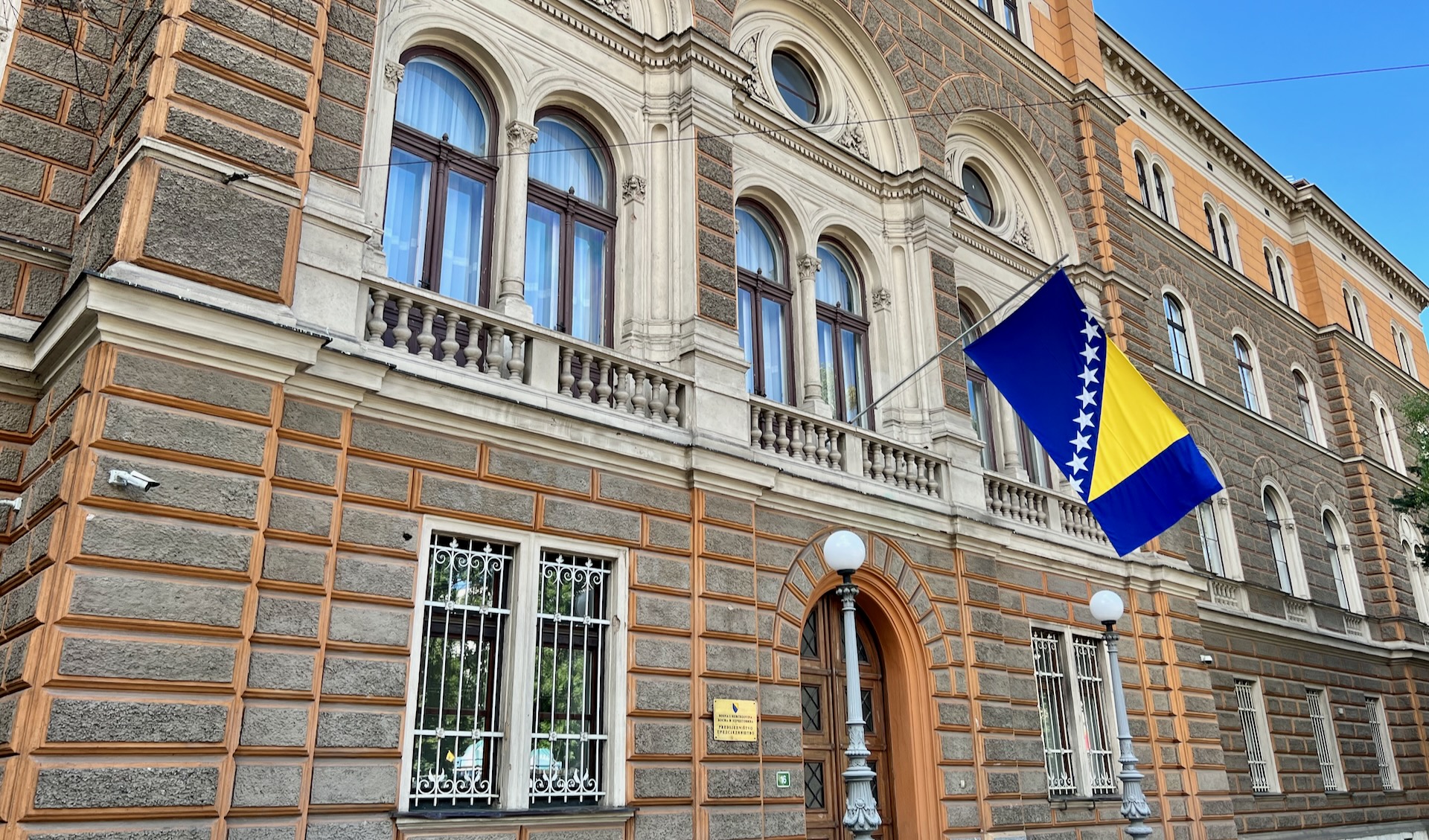
Similarly, the official flag of the country isn’t something that Bosnians created, it was also introduced by the Dayton Agreement and proposed by a Spanish diplomat. It’s less controversial because it has nothing to do with Bosnia, aside from the country kind of looking like a triangle.
We learned about this, and other things, on a walking tour around the city.
Siege of Sarajevo
Our tour guide showed us a few landmarks that I probably would have missed otherwise.
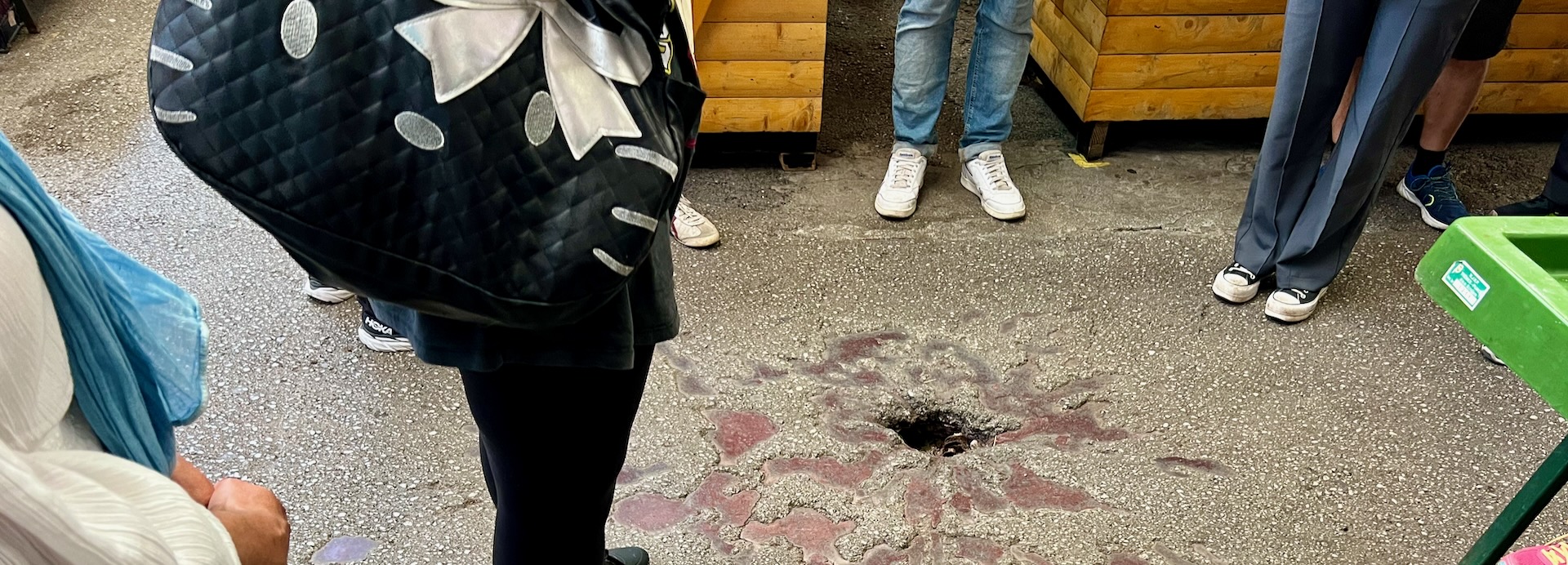
This Sarajevo rose marks the Markale massacres. Over 100 people were killed by a mortar strike, launched by the Republika Srpska forces.
Our tour guide spoke openly about this, as somebody who grew up in the city and was there during the siege. Children had to hide indoors. Starvation killed.
We learned more the impacts of all this at the War Childhood museum.
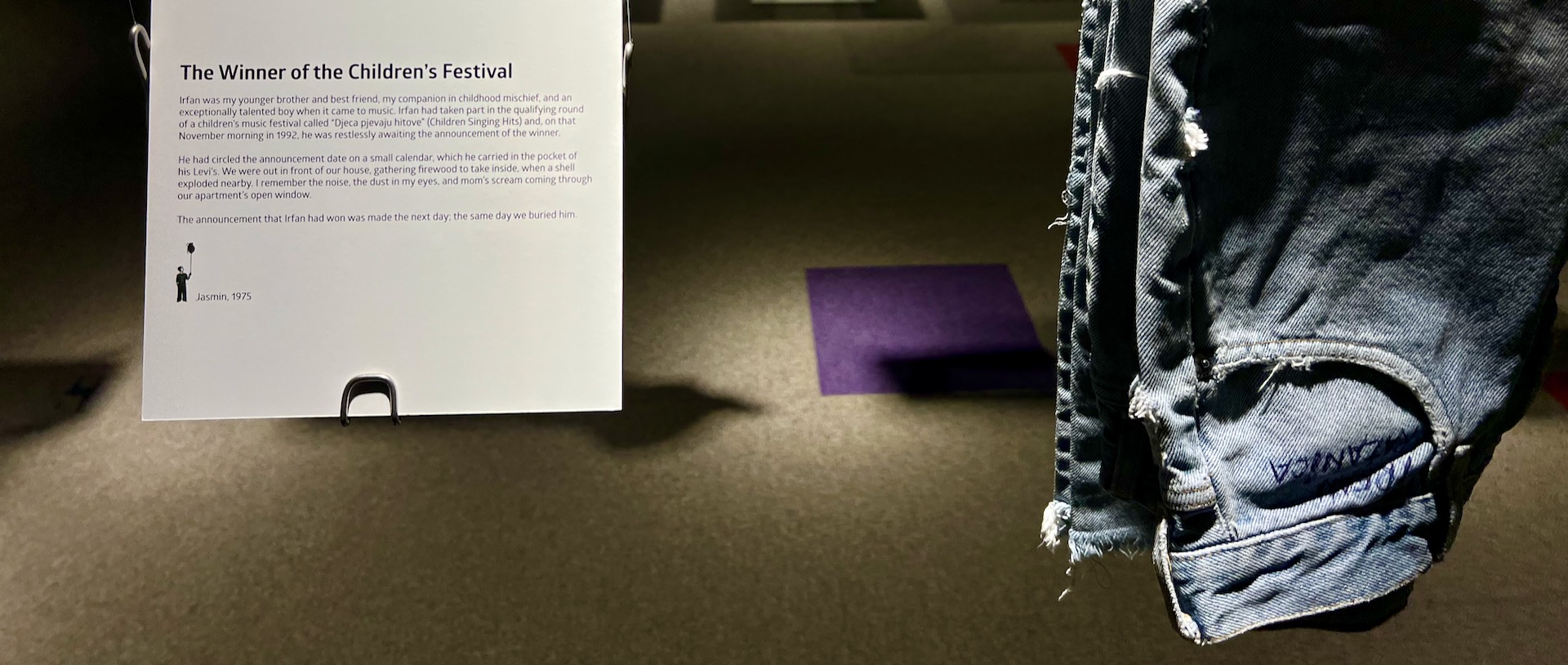
Sniper’s alley is another such landmark. Nowadays, it’s just a big stroad next to office towers and a mall.
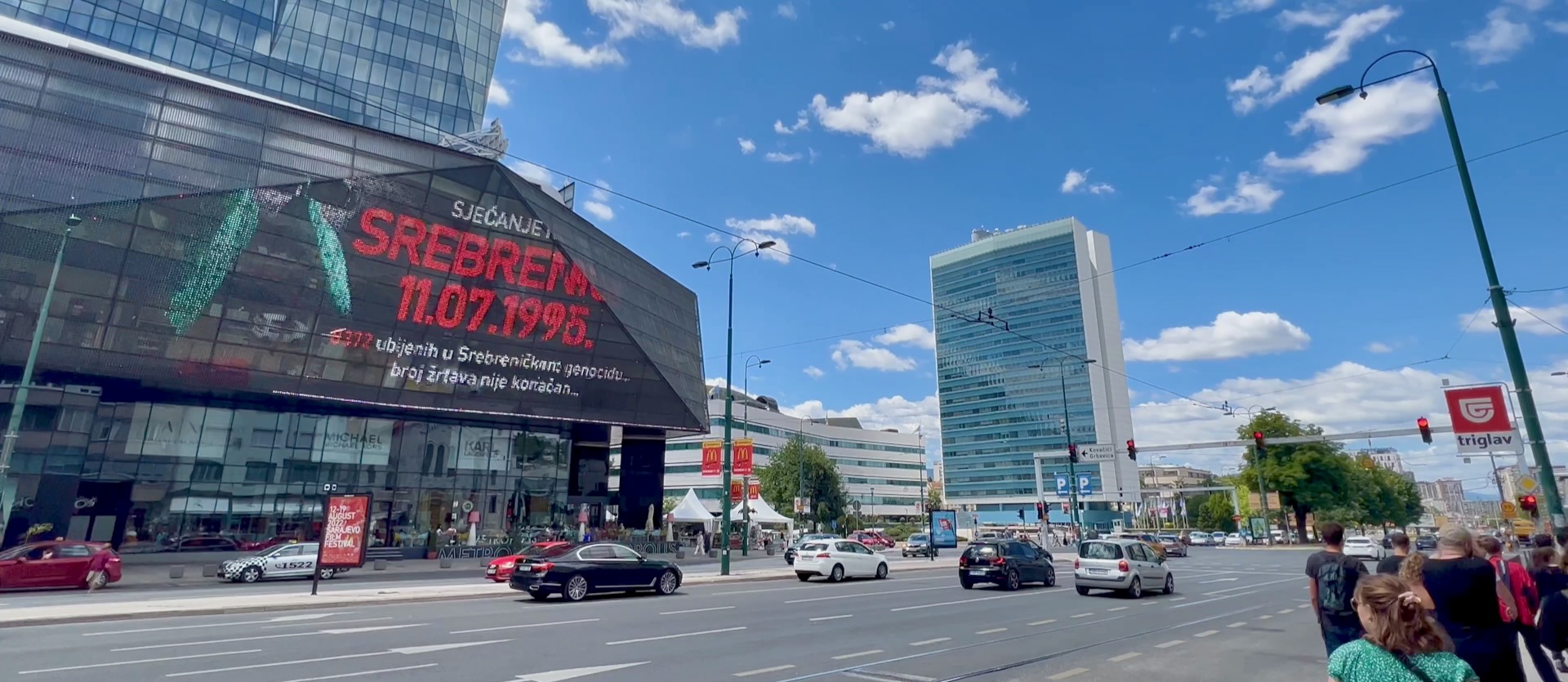
During the Siege of Sarajevo, this was a no-man’s land. The pristine view of the mountains to the south meant that snipers would shoot the moment anyone would try crossing the street.
Srebrenica
Note also the sign about Srebrenica. We happened to visit on the anniversary of it, July 11th.
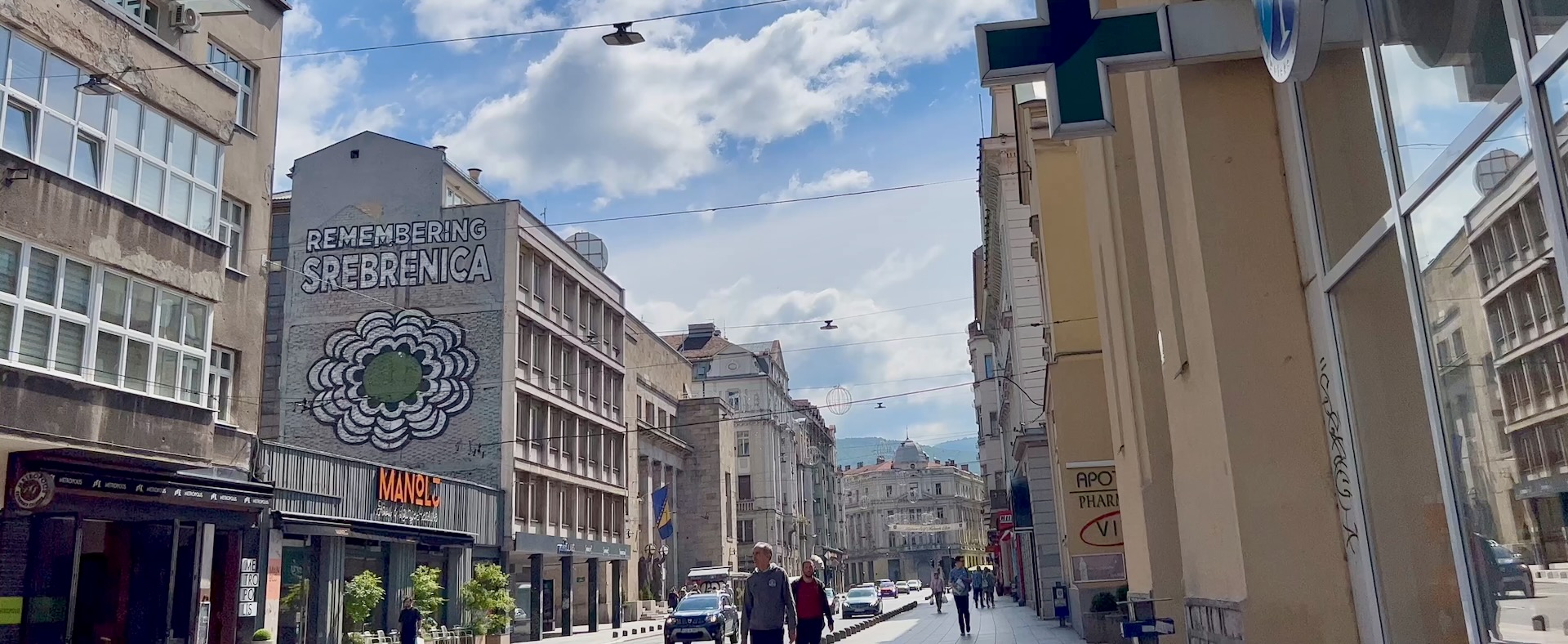
The flower is a symbol of the genocide. Eleven petals represent the 11th of July, when it happened. We bought little crocheted flowers from a merchant selling them on the street.
There’s a lot to unpack here. Per a recommendation from our tour guide, I later watched a BBC documentary titled "The Death of Yugoslavia" on this. I'd highly recommend it.
To Belgrade, through Republika Srpska
The next leg in our journey was to go to Belgrade, in Serbia.
Unfortunately, there’s no train service from Sarajevo to Belgrade. Apparently there was a train in the past when both were part of Yugoslavia, but after the Yugoslav wars, these are no more.
There was a bus, but we opted to instead hire a tour guide to take us there. The rate felt absurdly cheap by US standards, around $200.
Our bus driver was a Bosniak from Sarajevo. He was super friendly, and chatted openly about his experience in Bosnia and with the war. He mentioned that he personally felt uncomfortable where we were going – through the Republika Srpska over to Belgrade – which is perhaps not an amazing sign.

There were a bunch of interesting attractions along the way. We had never heard about any of them before our tour guide took us there.
Višegrad, Andrićgrad, Emir Kusturica
We visited the Mehmed Paša Sokolović bridge in the town of Višegrad.
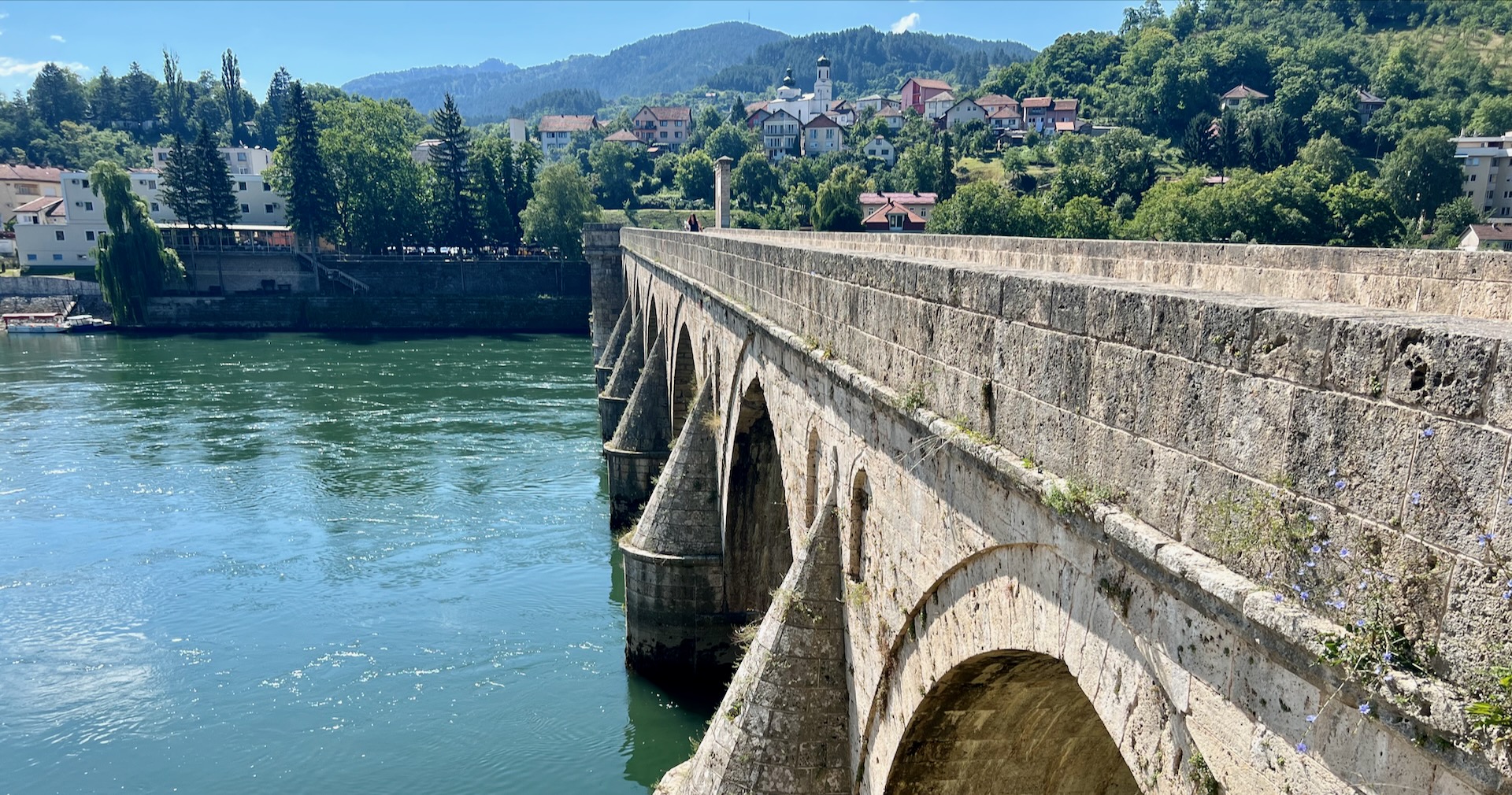
We were told that the town was popularized by novelist Ivo Andrić in his book “The Bridge on the Drina.” We had never heard of that book, but we followed along.
Višegrad was also the site of massacres and ethnic cleansing during the Yugoslav war.
Instead, we saw something more surreal. We visited this tiny fake village called Andrićgrad. This was being built by a film director, Emir Kusturica, to make a movie about Ivo Andrić.
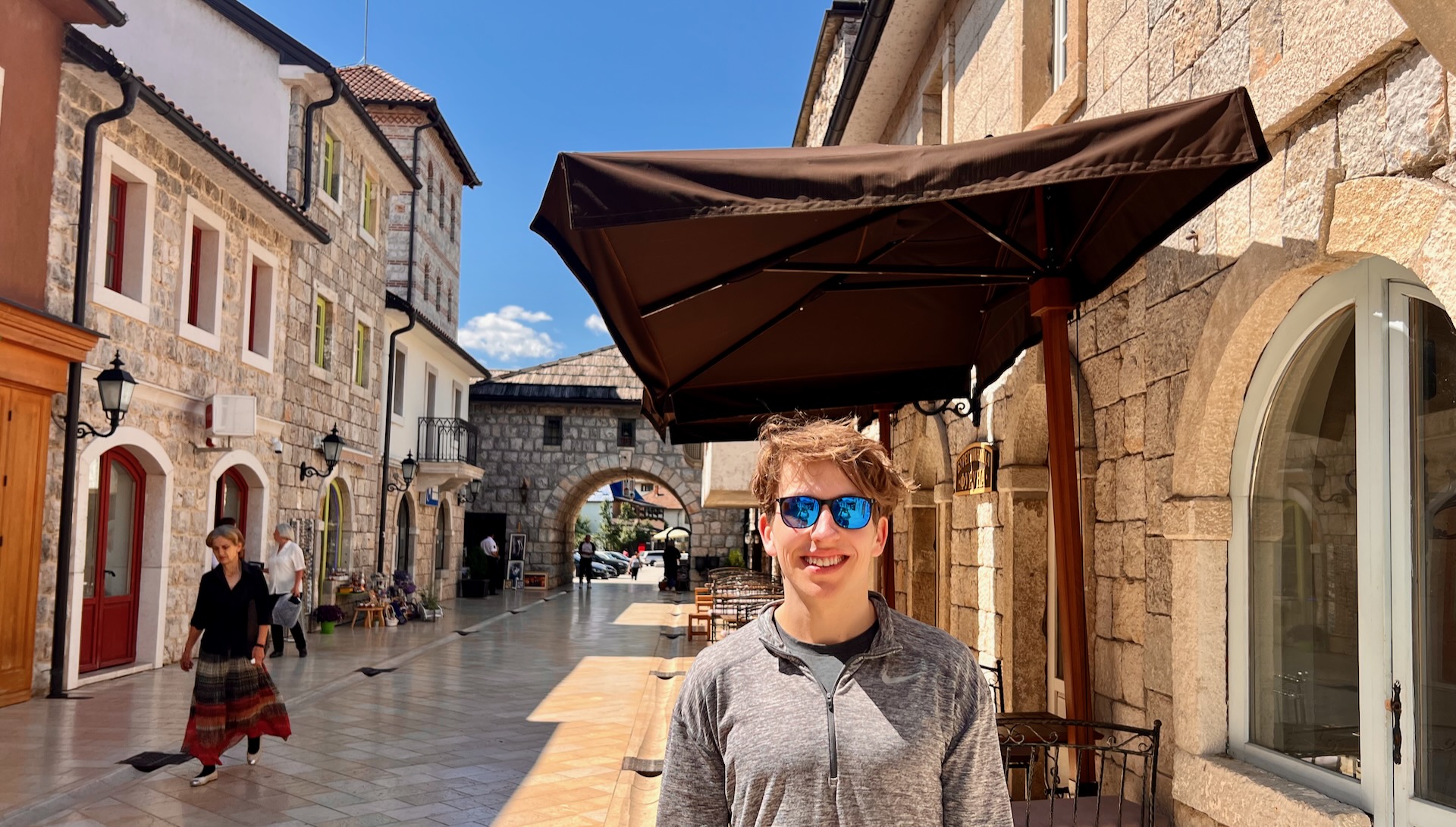
It makes sense that, being built by a film director, this tiny anachronistic town would also have a tiny movie theater.
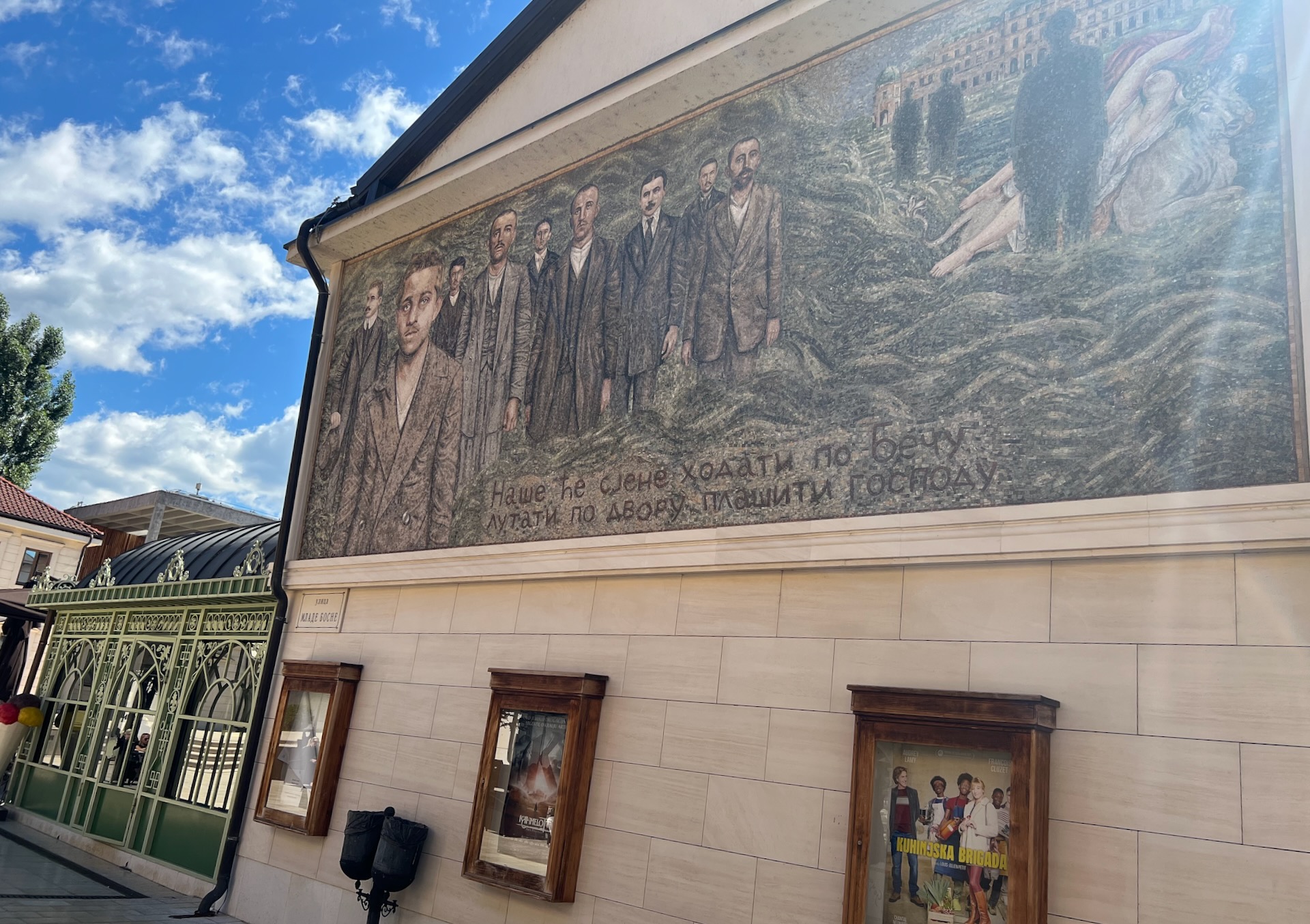
This mural is about Gavrilo Princip, and it states “Our shadows will walk through Vienna.” Our tour guide explained this has other nationalistic connotations. Gavrilo Princip set off World War 1 by assassinating Archduke Franz Ferdinand in Sarajevo - we had visited the bridge where it happened. He was a Bosnian Serb.
The end of the village featured a half-built, surprisingly modern looking building next to a mostly empty Orthodox Serb church.
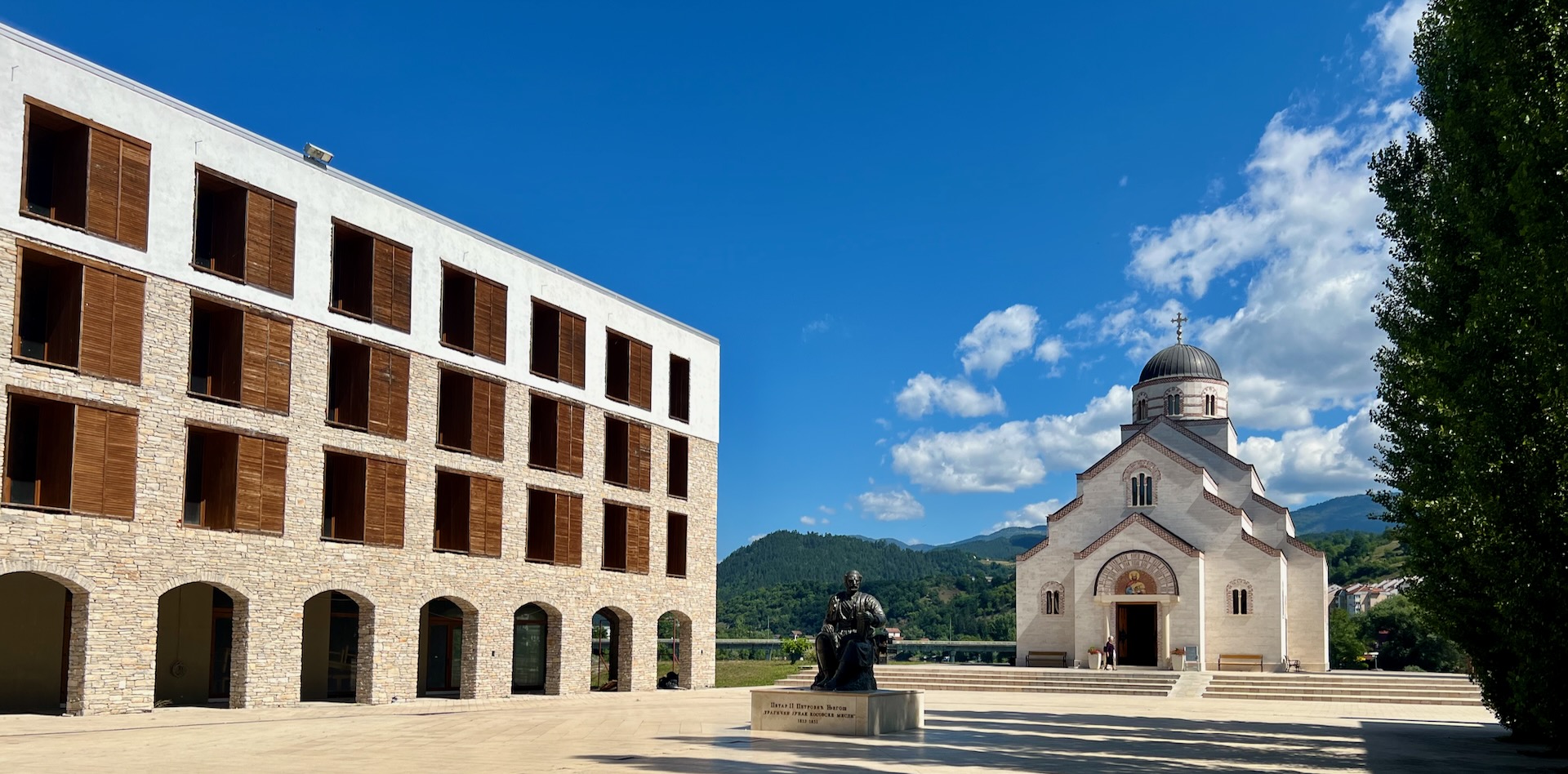
A miniature railway in Mokra Gora
We visited another random tourist village in the middle of nowhere. The director Emir Kusturica was also involved.
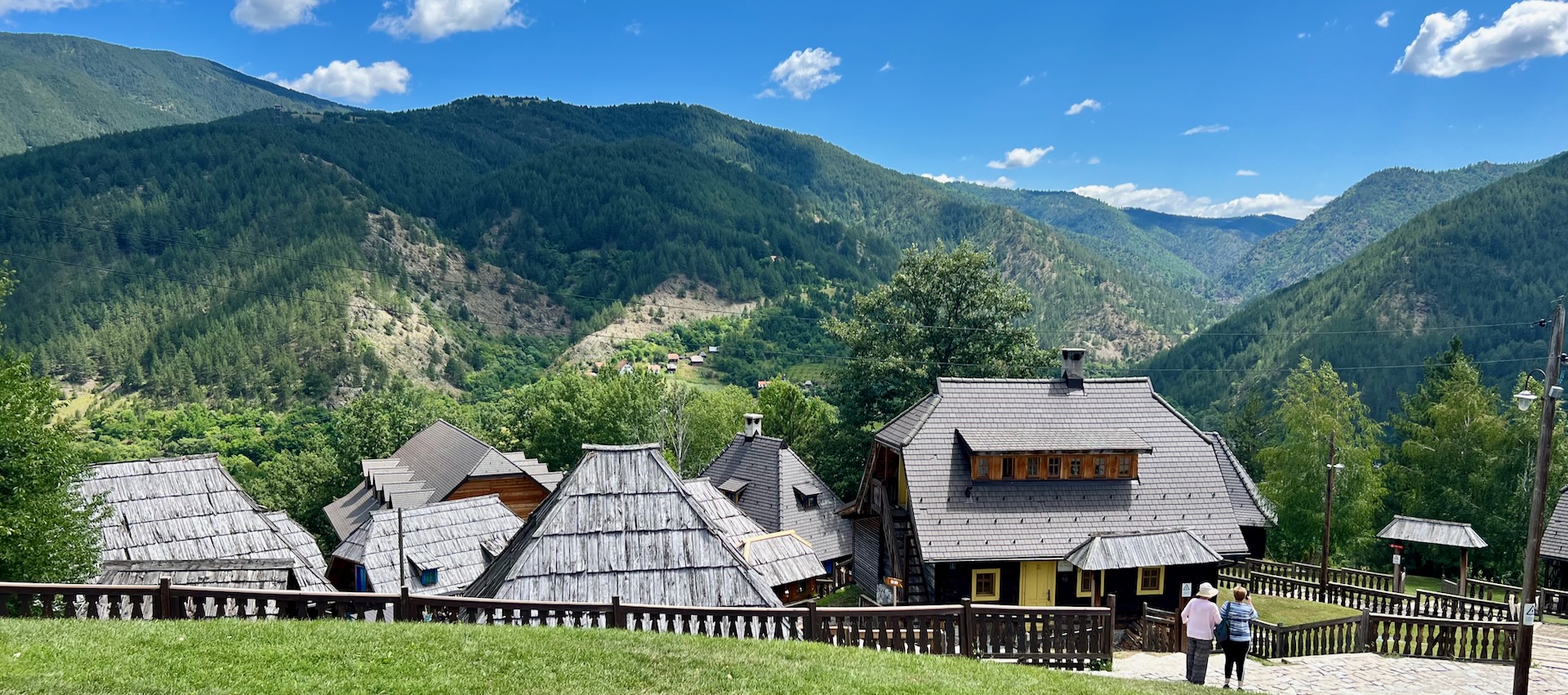
The main attraction was a tiny miniature railway.
The plan was ostensibly to connect Serbia with Austro-Hungary back in World War 1. Very little of the train was actually built. What’s left is a figure 8 loop that’s about 16 miles long and a tourist attraction.
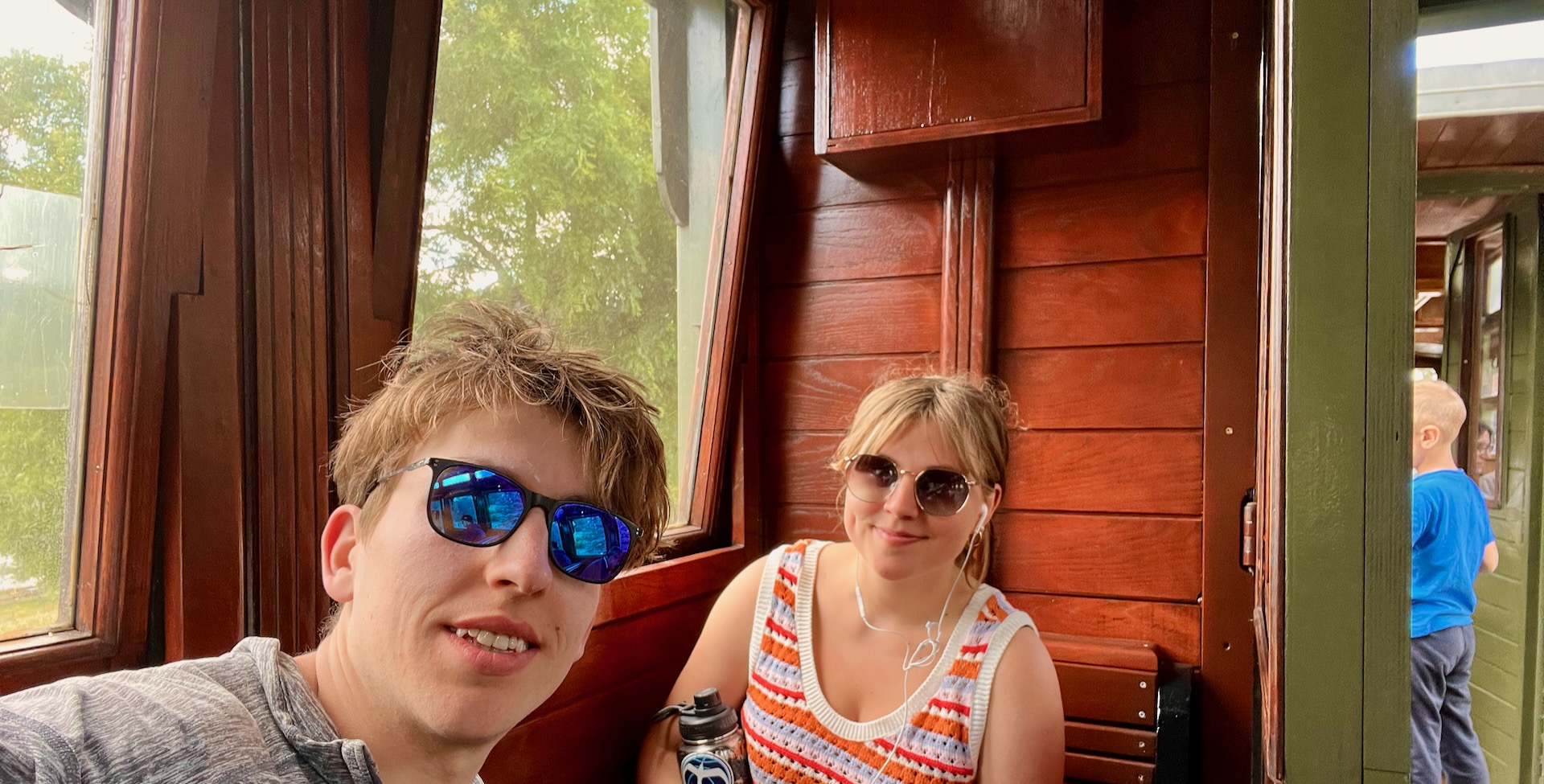
The rest of the road trip was also quite picturesque. We crossed into the flatlands of Serbia with no problem, and arrived in Belgrade.
Belgrade
I had visited Belgrade before, on a weekend while studying abroad in Budapest. To quote from a Serbian tourism video that my friend Misha and I loved a decade ago -- Belgrade blew my mind.
The things I remember: it was raining and almost flooding, the buildings were dated, everything was very inexpensive, and there was a complicated legacy around Tito.
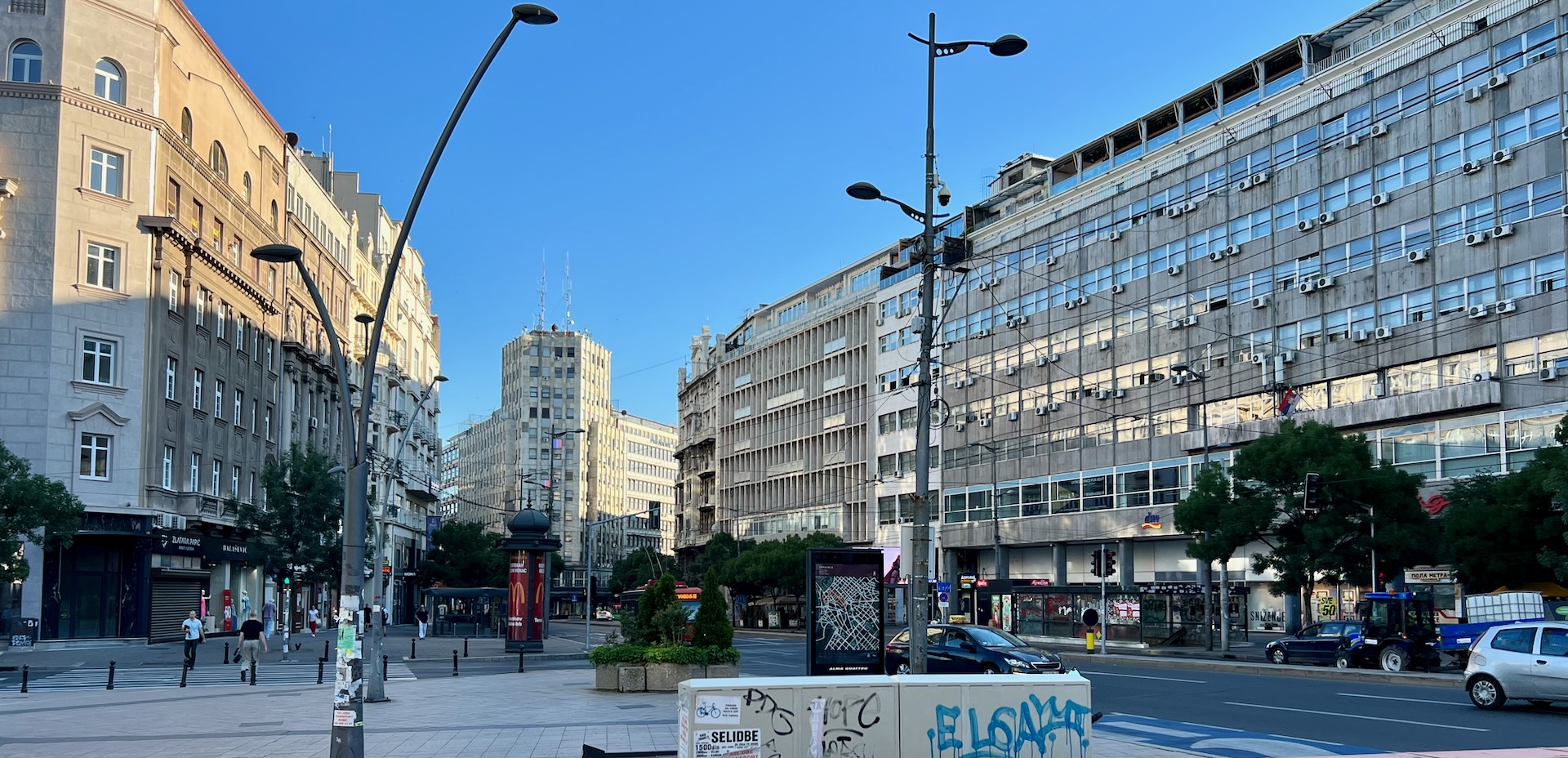
Old and New
In a lot of ways Belgrade was more or less as I remembered it. Though with more vegan restaurants, among other things.
We took a walking tour downtown.
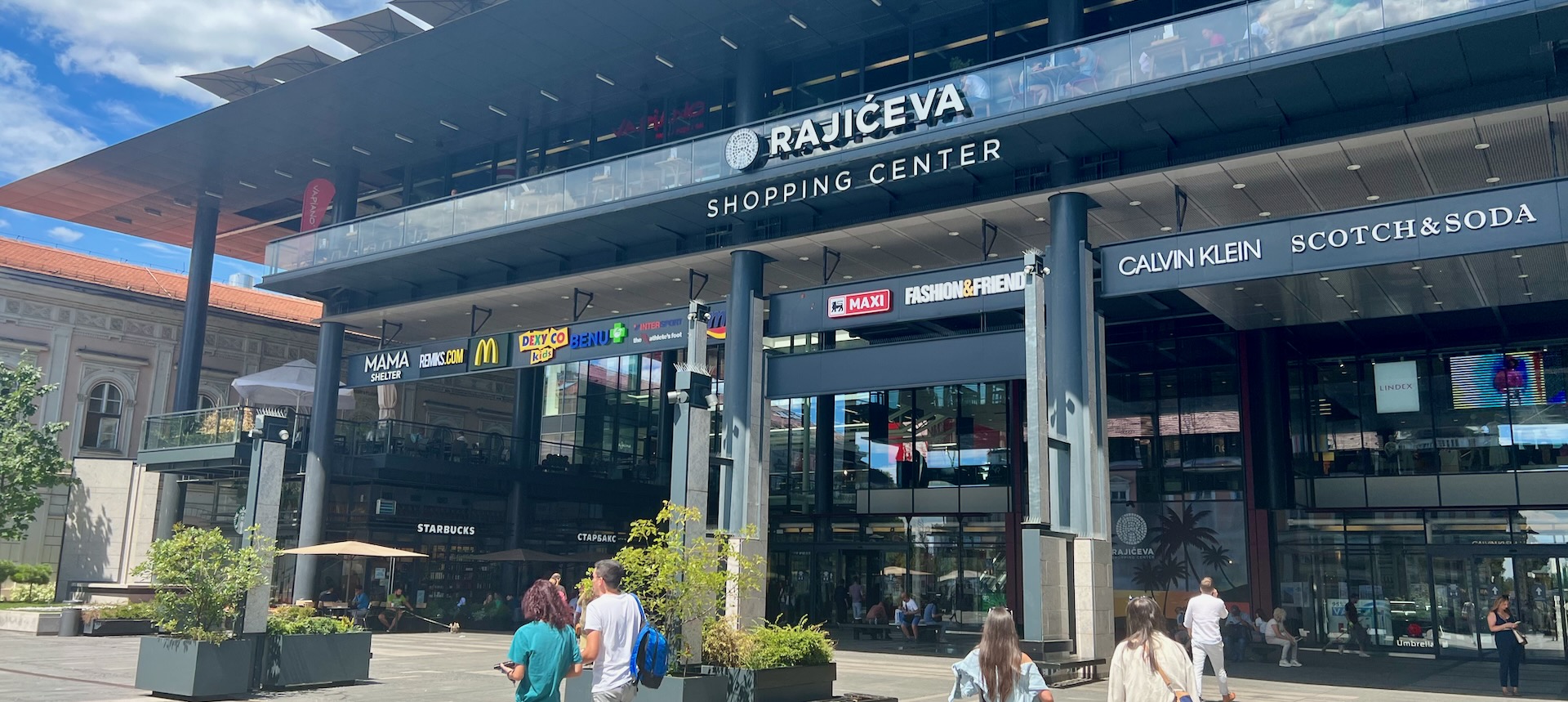
A lot of old stuff that seemed the same – but 8 years out and there was a new very modern shopping mall downtown.
We took a hike up to Zemun, the Austro-Hungarian neighborhood, and got a view of the city.
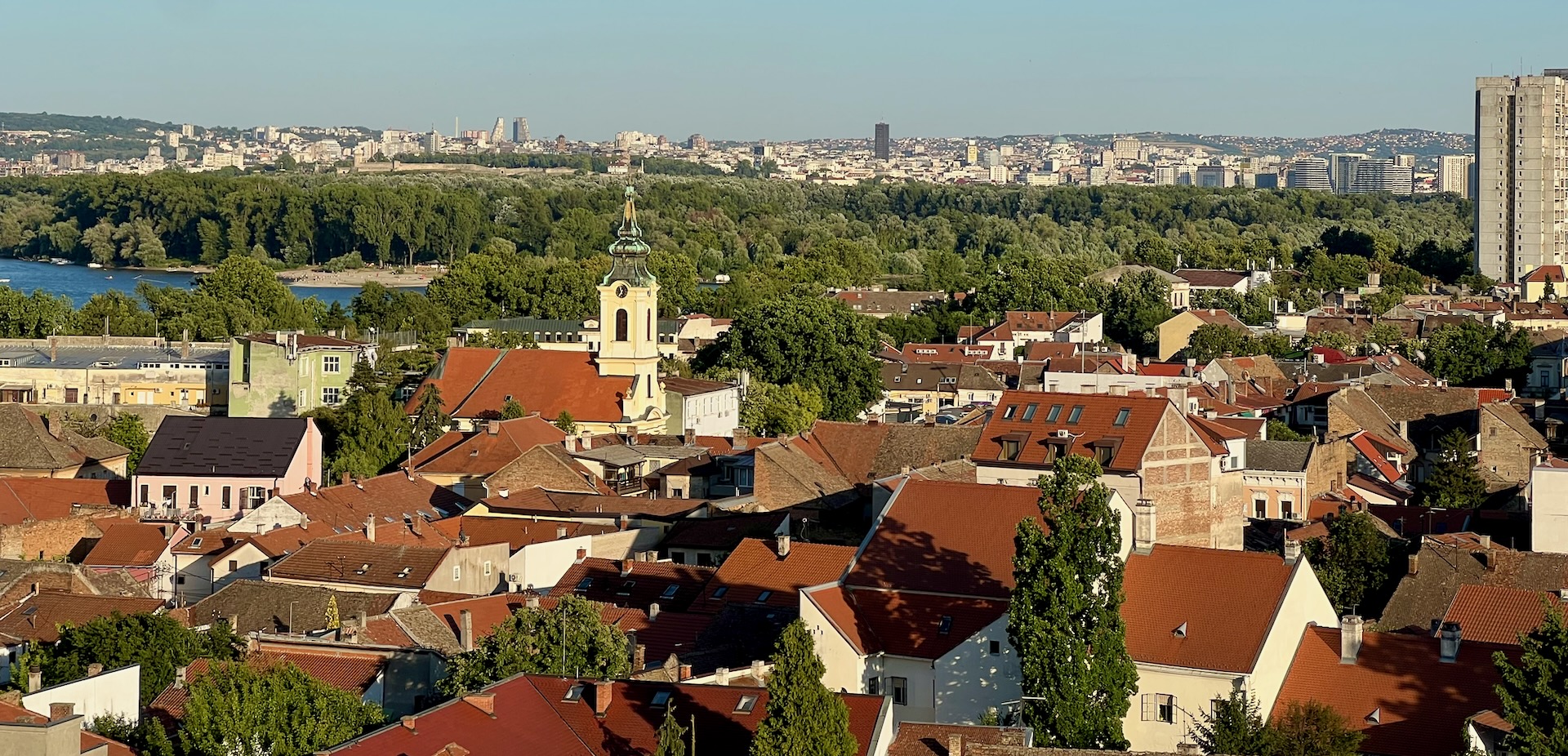
Nationalism
Back downtown, we checked out some of my favorite propaganda - the bombed Yugoslav Ministry of Defence building, bombed by Nato during the Kosovar wars in 1999.
We visited the Church of St. Sava - still under construction; but helped out by a lot of money from Serbia’s friend, Russia.
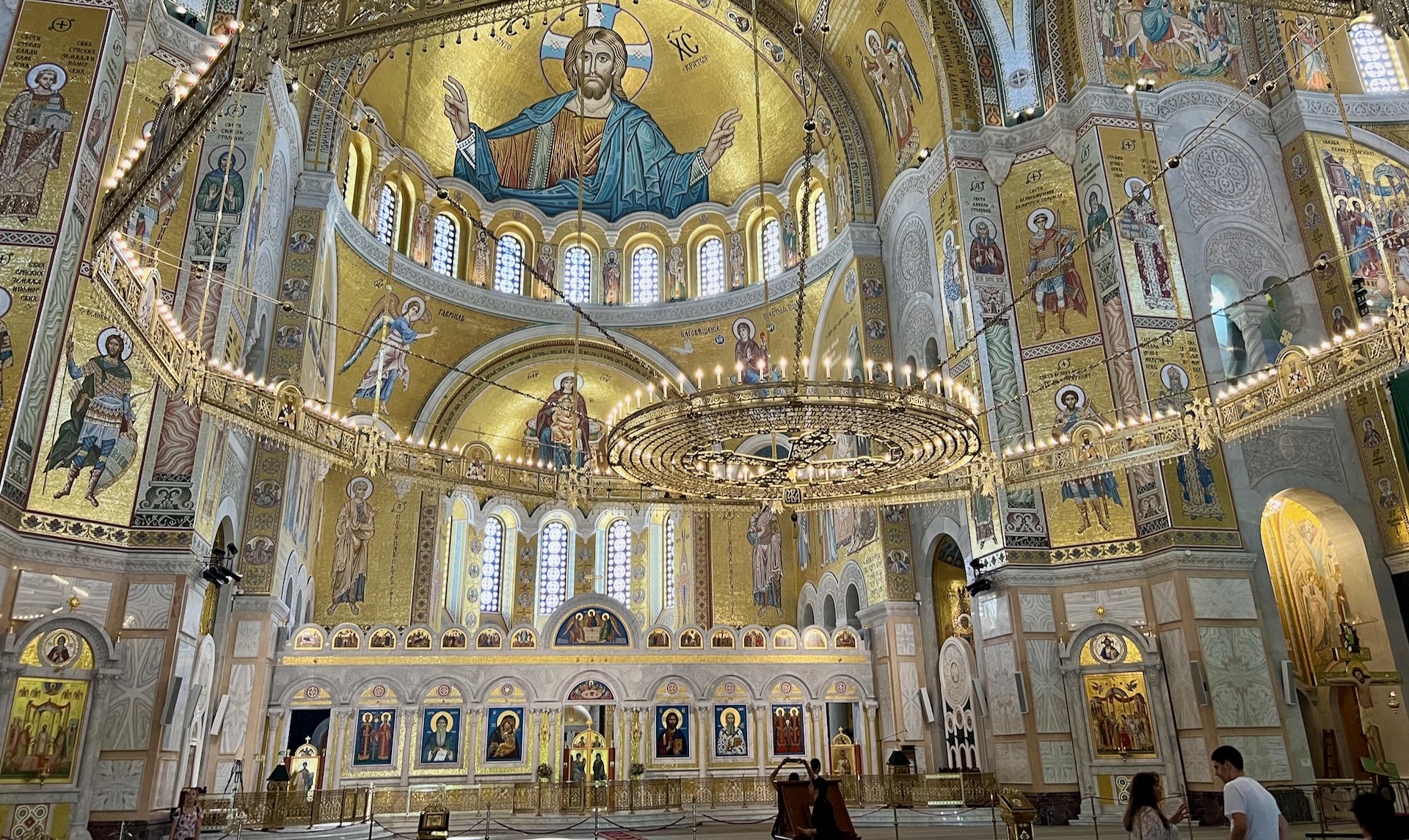
Finally, we visited the House of Flowers.
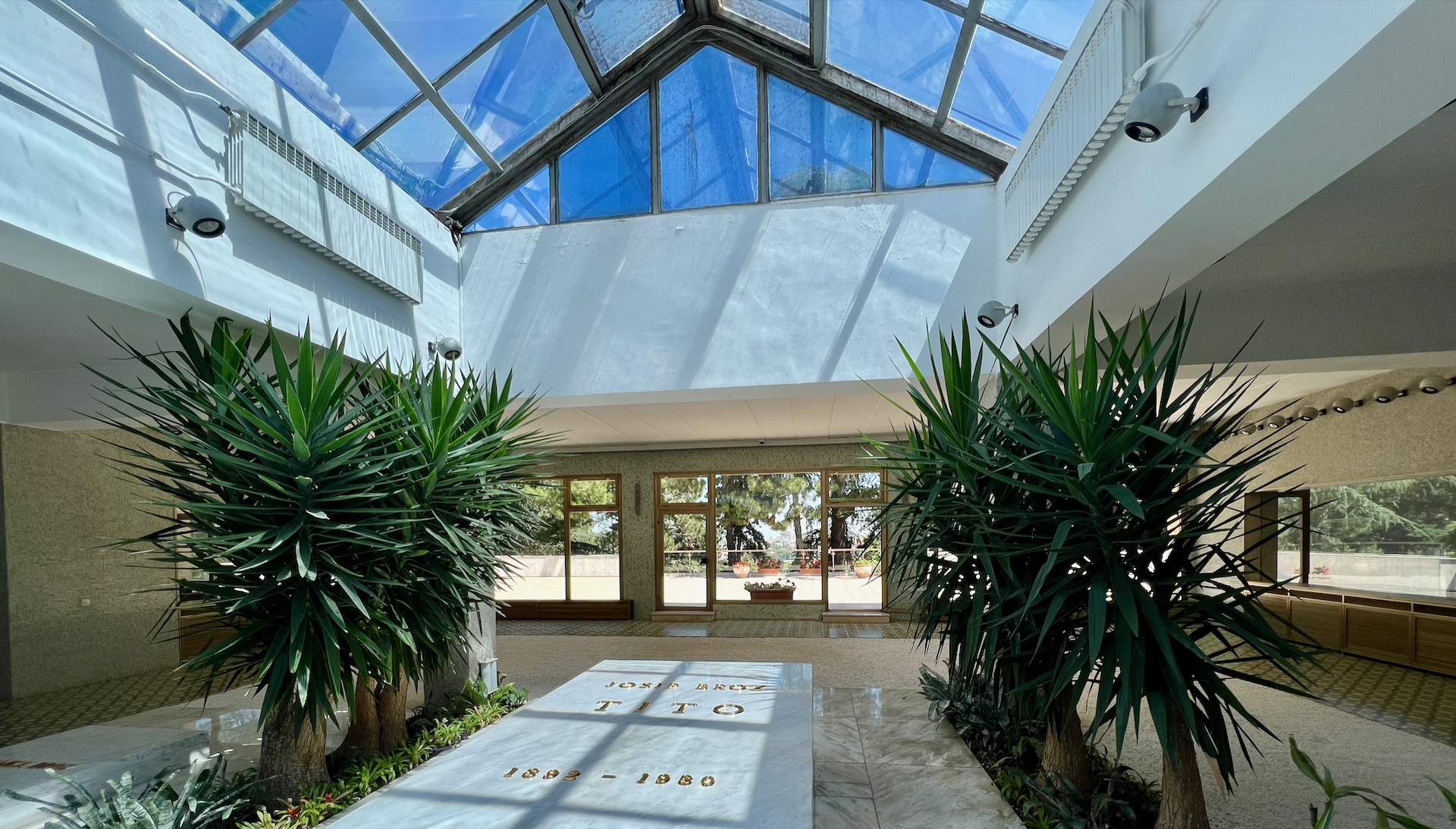
This was the resting spot of Tito. It was fairly empty when we visited, but I had strong memories of this from last time. Ten years ago, I was here along with my friends Misha and Rachel. We had coincidentally visited on the anniversary of Tito's death, and saw old ex-Yugoslav veterans in military attire put flowers on his grave.
As a total outsider, the nostalgia for Tito here interests me. Maybe in some ways, it's nostalgia for something beyond ethnic nationalism. Though Tito was a dictator, he also was a force that brought Yugoslavia together.
After he died is when the ethnic conflicts really began and Yugoslavia fell apart.
On our trip, we saw another nationalism-related protest.
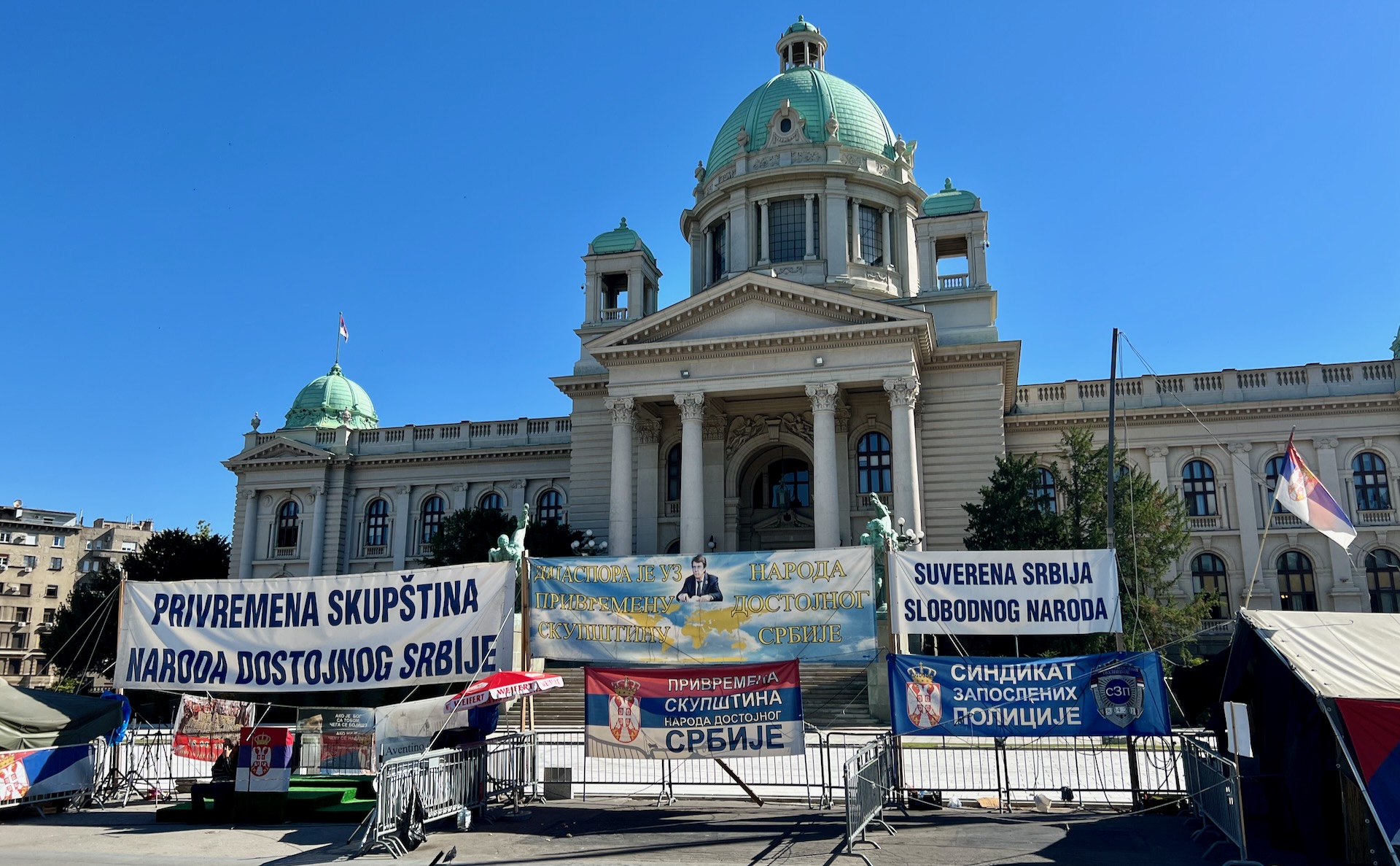
Over the course of our Balkan tour, we went on a bunch of walking tours as mentioned. The history of the Balkan wars was a resounding theme throughout. The young people who led the tours seemed sick of it. One tour guide mentioned that he identified proudly not as Bosnian, Croatian, or Serbian, but Yugoslav. The famous performance artist Marina Abramović is quoted as saying the same.
Budapest
Budapest was where I studied abroad in 2014. Zanny and I met up with her partner, Dennis, who had come down from Berlin to visit us.
The nostalgia factor was high. We stayed near where I lived next to Margit híd (Margaret bridge, connecting to Margitsziget or Margaret Island).
Margitsziget runs
My neighborhood in Budapest was where I started running for the first time. There’s a 5K route around Margitsziget that’s nice, car free, and quite accessible. I can’t say I was very fast, but it was nice.
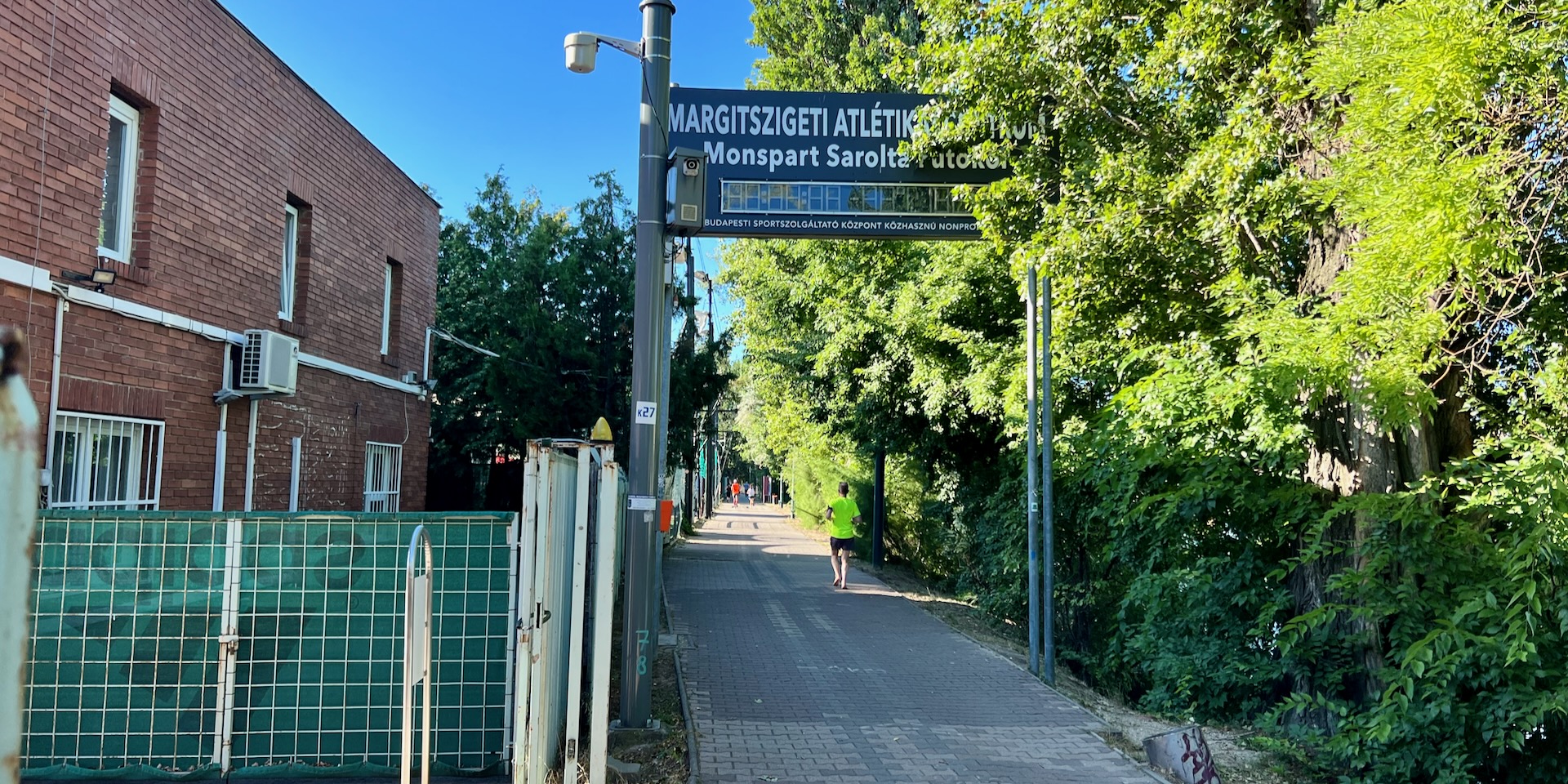
The 5K track loops around the entire island.

Delicious food
I visited two of my favorite haunts. Szeráj, a turkish restaurant where I would order Döner for less than $5.
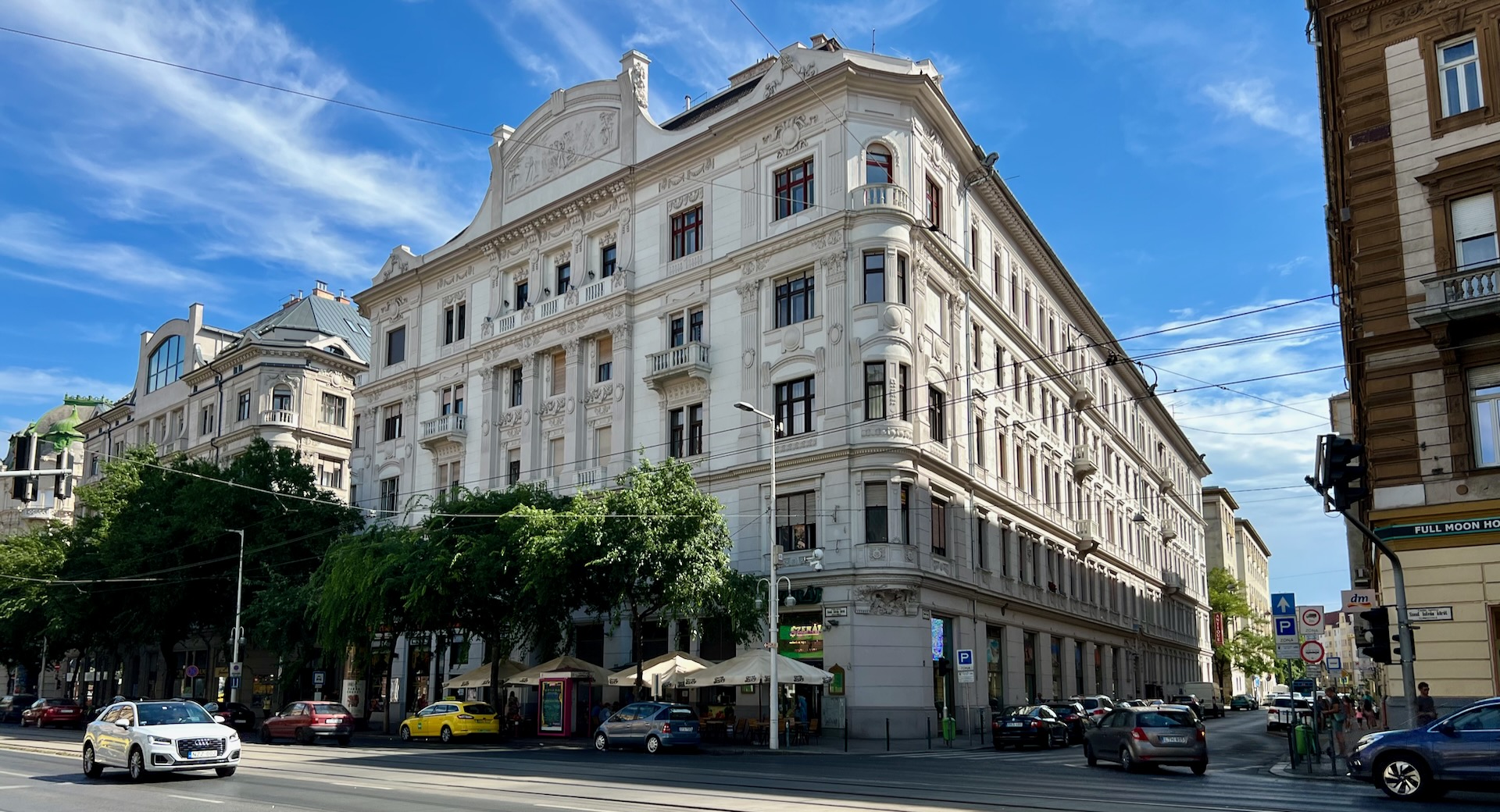
The forint prices were about double what I remember, but that was in part due to very heavy inflation (heavier than in the US).
I had gone vegetarian since leaving Hungary and I gotta say, the falafel sandwich was not as good as the Döner that I remember. Alas.
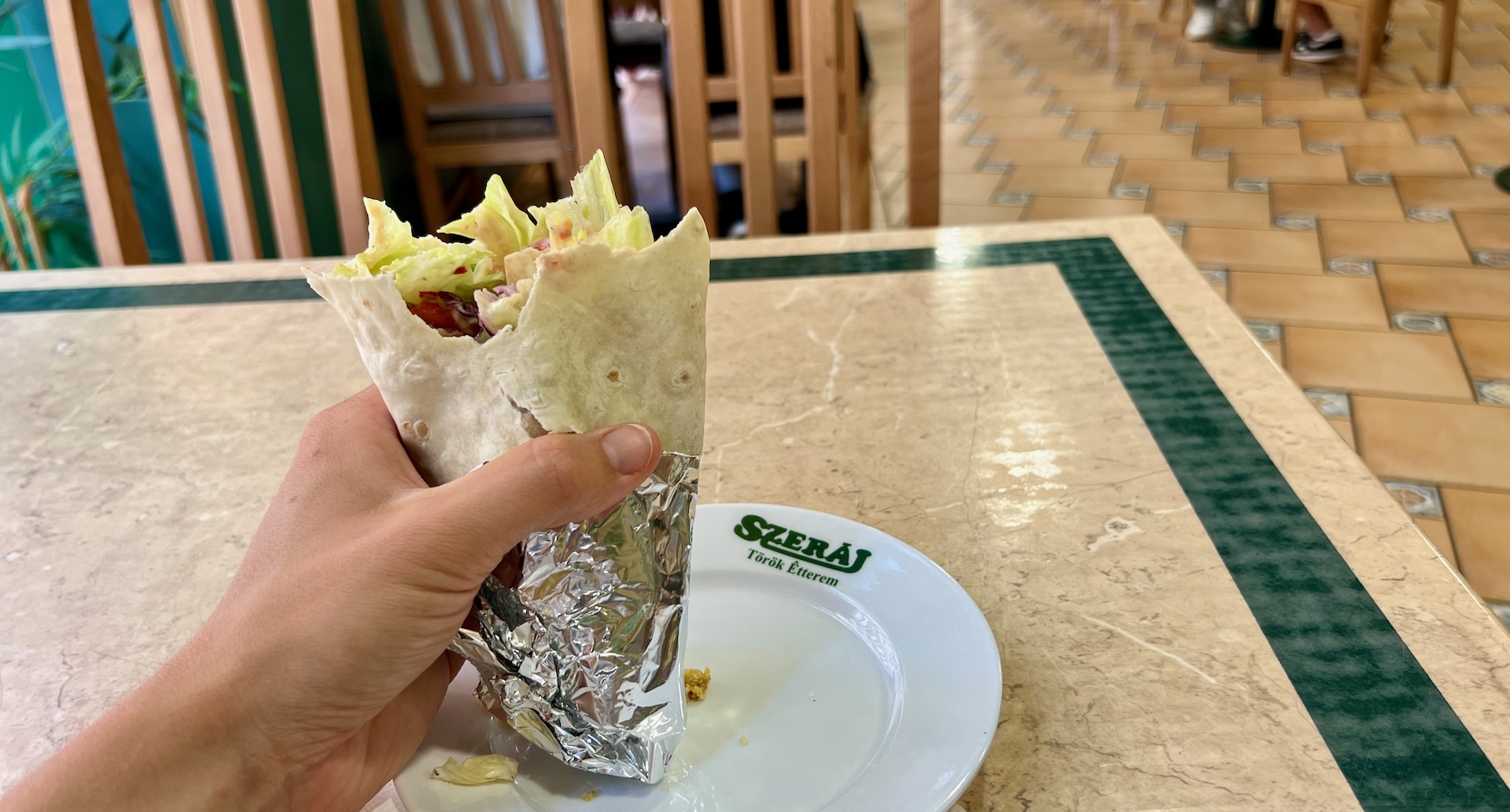
We ate Michelin-starred food at probably the cheapest price anywhere (though maybe some places in Singapore are cheaper)! We went to Borkonyha, aka Wine Kitchen.
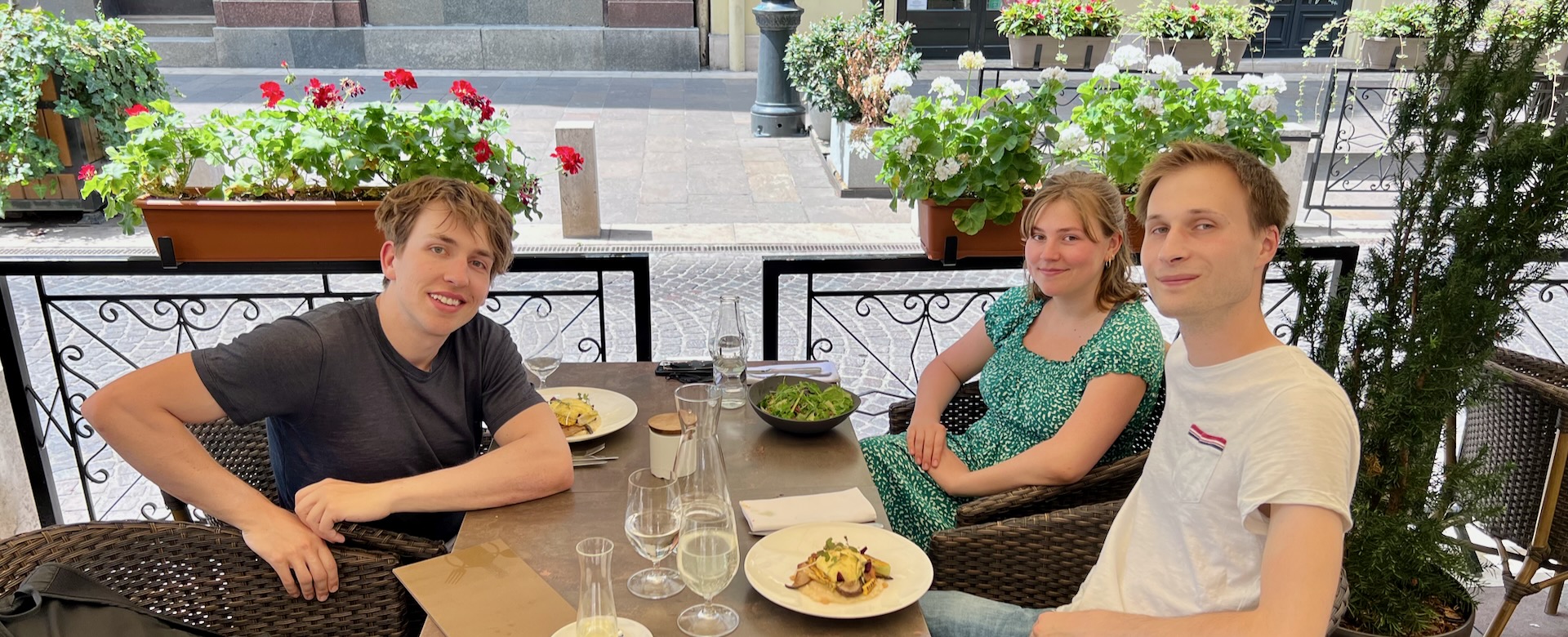
Even the bread was memorable. It had just the right amount of chewiness. They served it with fresh creamy butter and flakes of sea salt.
Ruin pubs and baths
The touristy activities in Budapest were some of the things I missed the most.
Budapest is famous for its ruin pubs. Zanny and Dennis don’t drink, and neither do I very much, so we visited Szimpla during the day, when it was instead hosting a Farmers market.
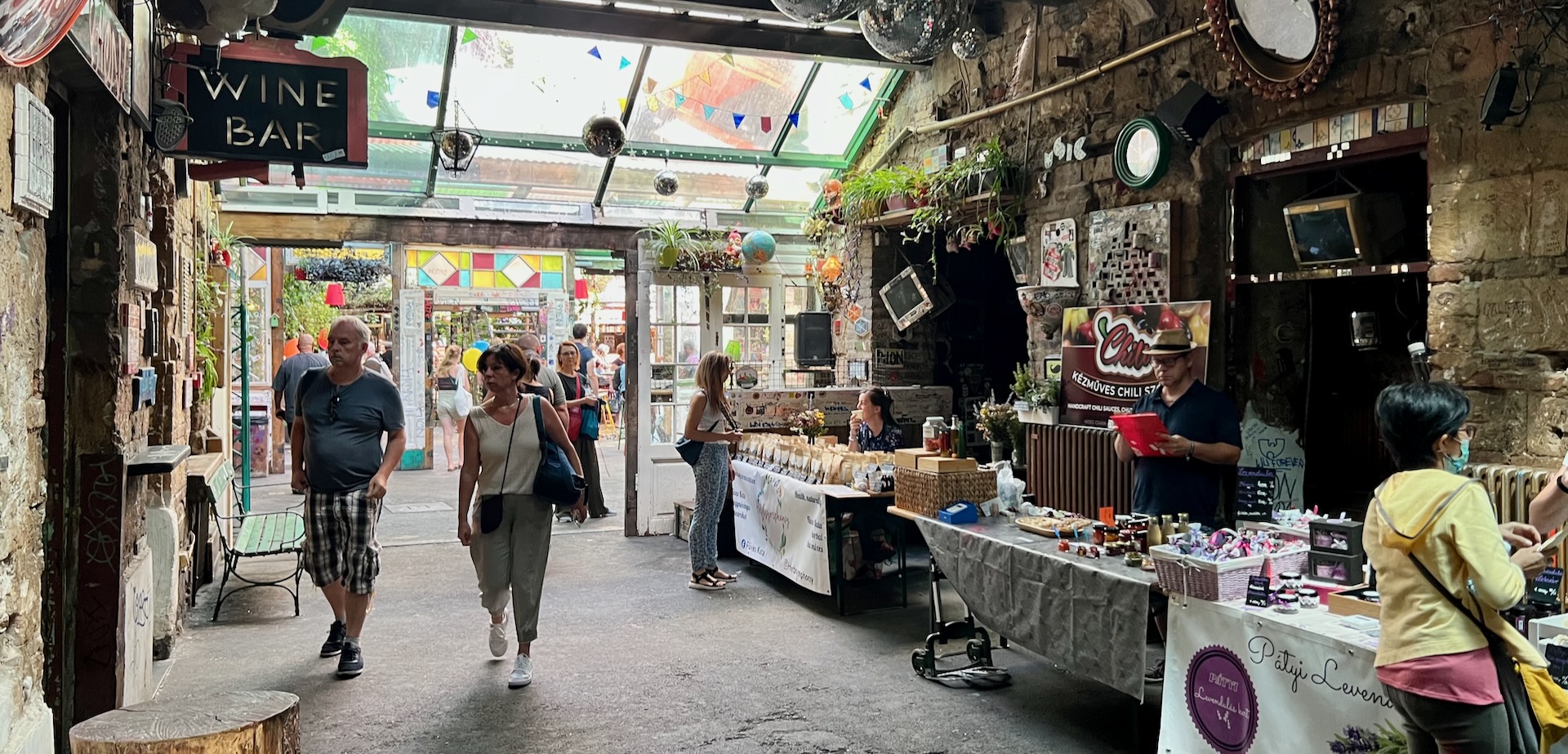
The baths were one of my favorite things about Budapest. Budapest happens to be on top of a lot of geothermal activity.
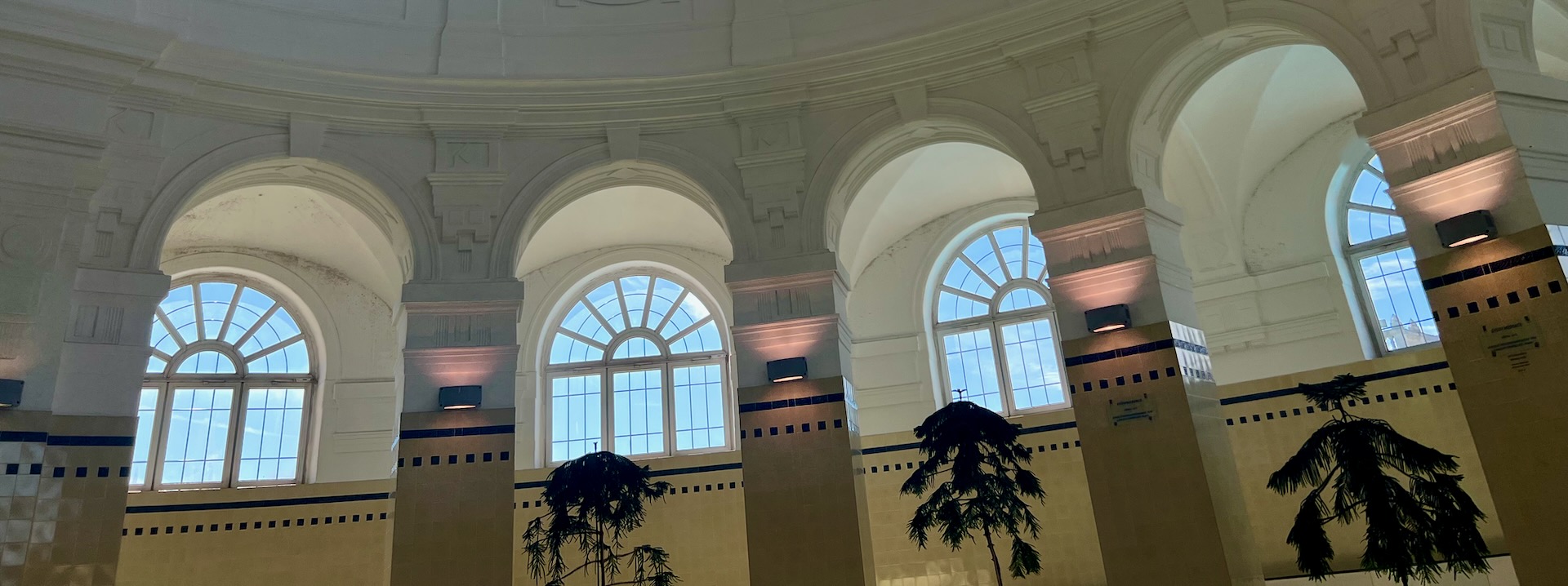
I went a few times when studying abroad, but didn't go regularly because I was super stingy back then. The baths are expensive in Hungarian prices, but cheap by US standards. They're all absolutely gorgeous too, with the classic Art-Nouveau architecture that Budapest is famous for.
Overall, it was good times. I love Budapest. It was the first "real city" I got a chance to live in.
Vienna
Vienna was the final destination of our trip.
Unfortunately, Zanny had caught a stomach bug and so she had to leave shortly after we arrived. Dennis went along with her.
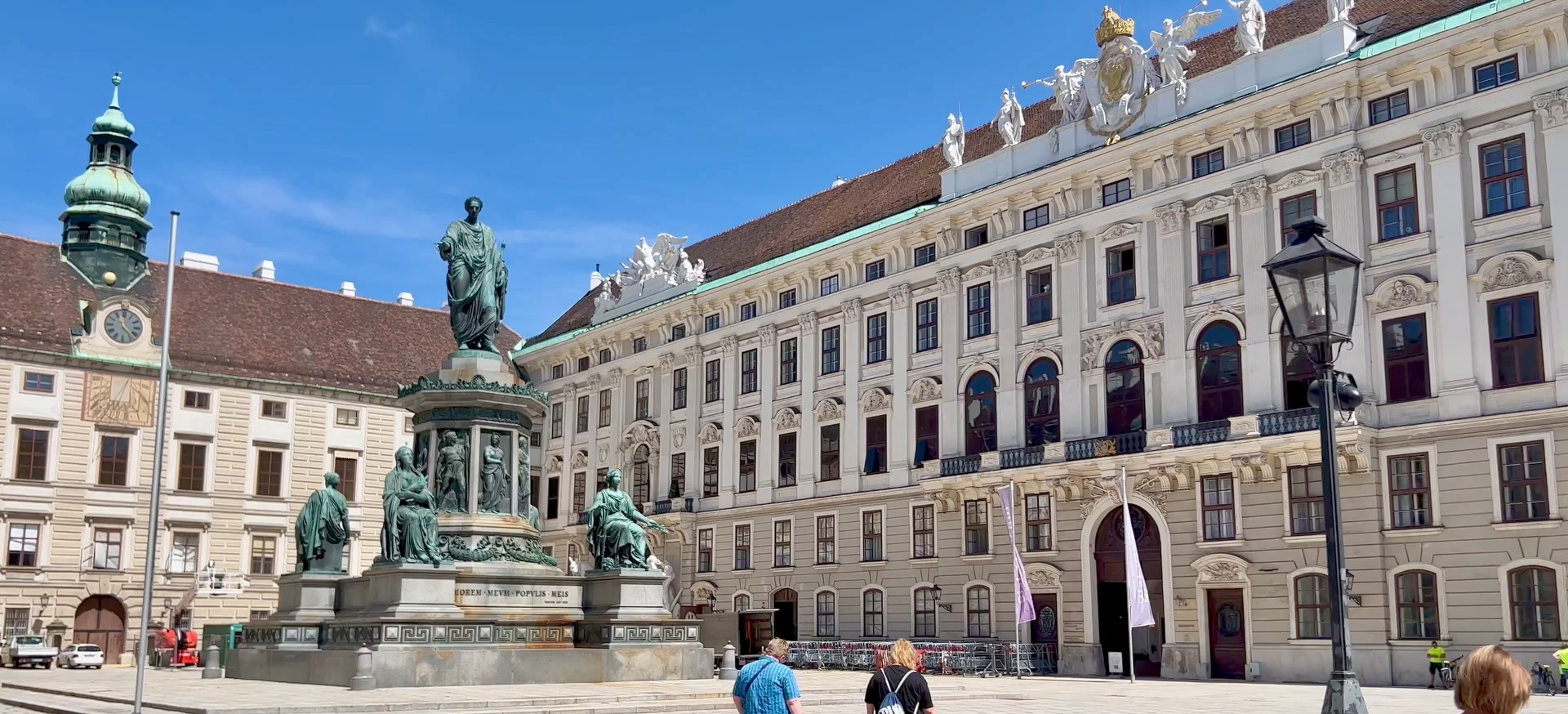
Hot take, but back in 2014 I wasn’t so much of a fan of Vienna. It felt a bit too polished and clean versus Budapest. Also everything felt like it cost twice as much and I was super cheap back then.
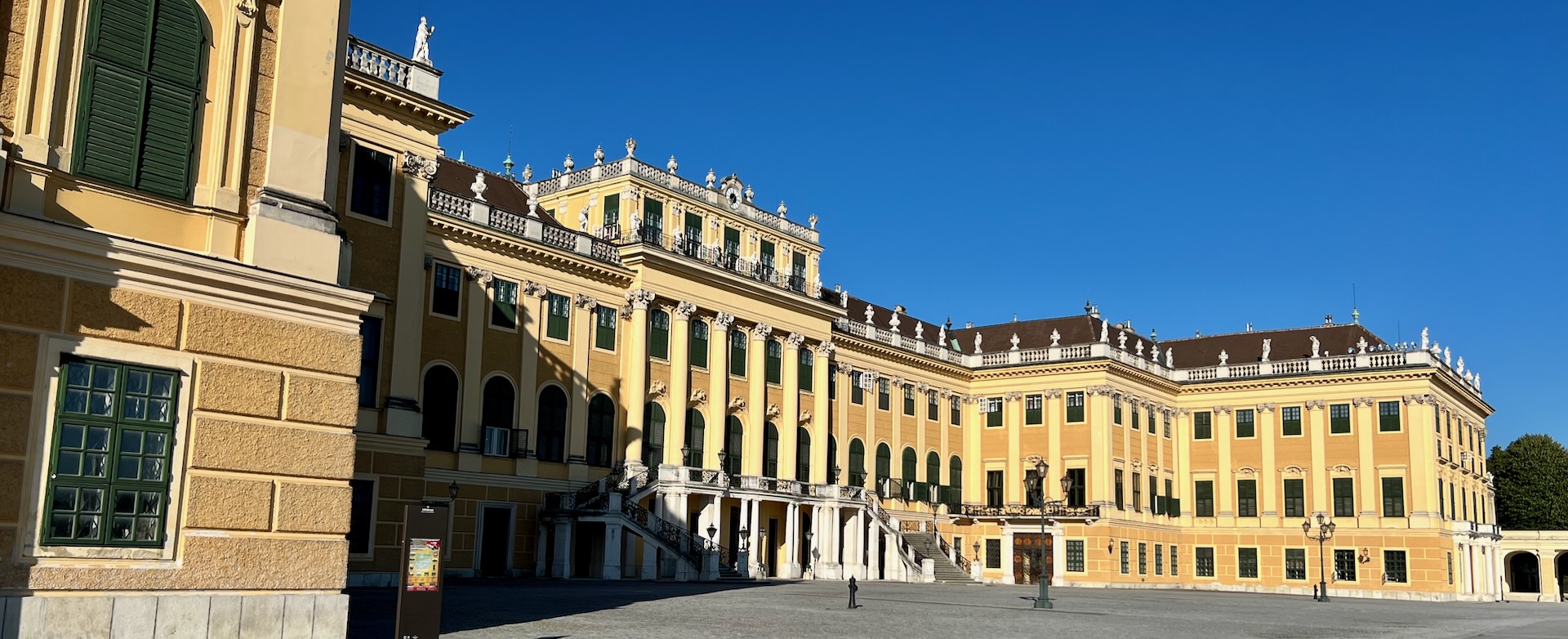
I liked it a lot more this time around. Maybe I just visited different things.
Design and housing
I visited the MAK - the Museum of Applied Arts.
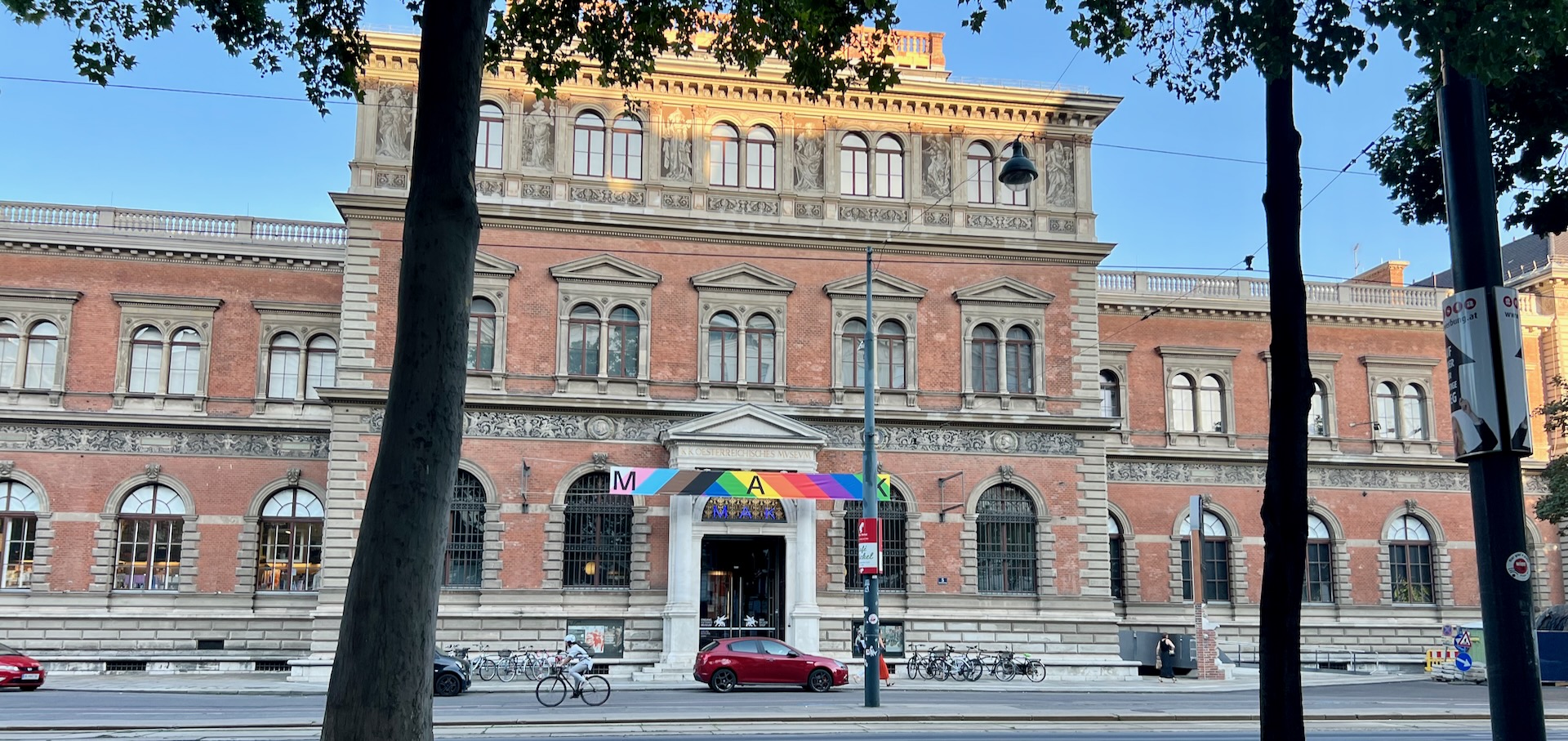
The collection was pretty cool. It ranged from old stuff like the Viennese Succession and Art Nouveau styles, all the way to new gadgets.
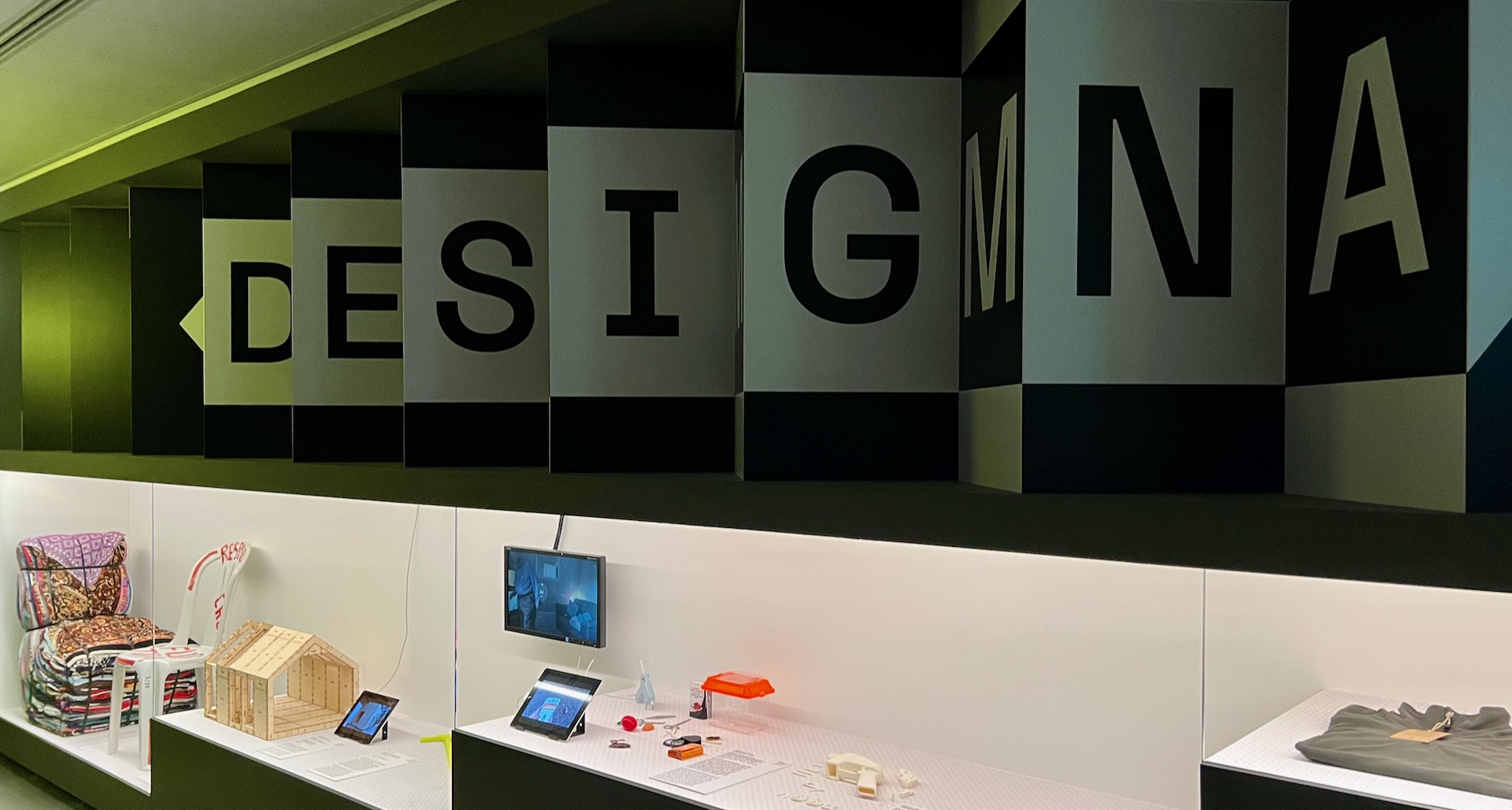
I downloaded an app that had a guided walking tour of downtown. It had a lot of context on some historic buildings, like the studded facade of the Post Savings Bank.
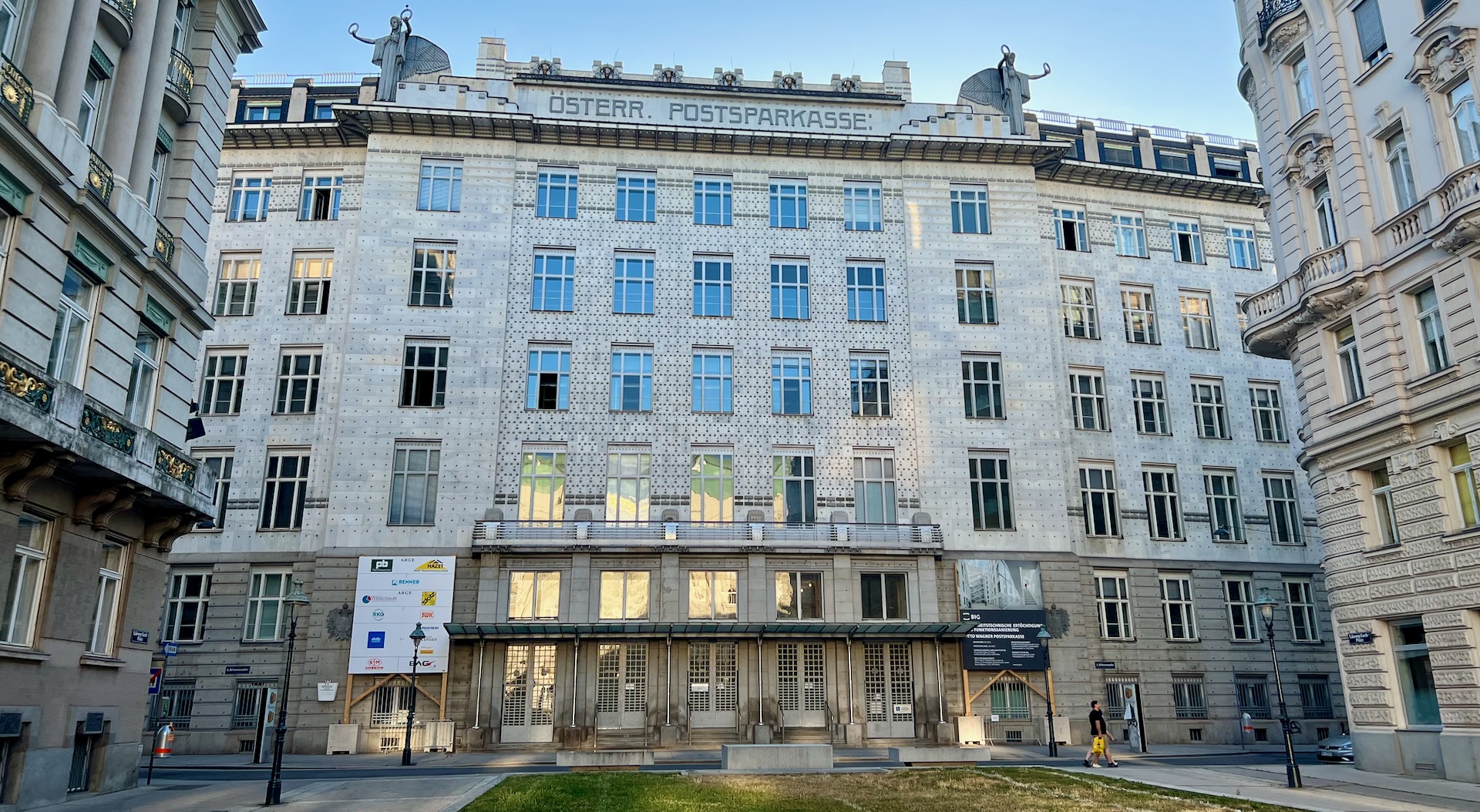
Design-wise though, my favorite is the Hundertwasserhaus.
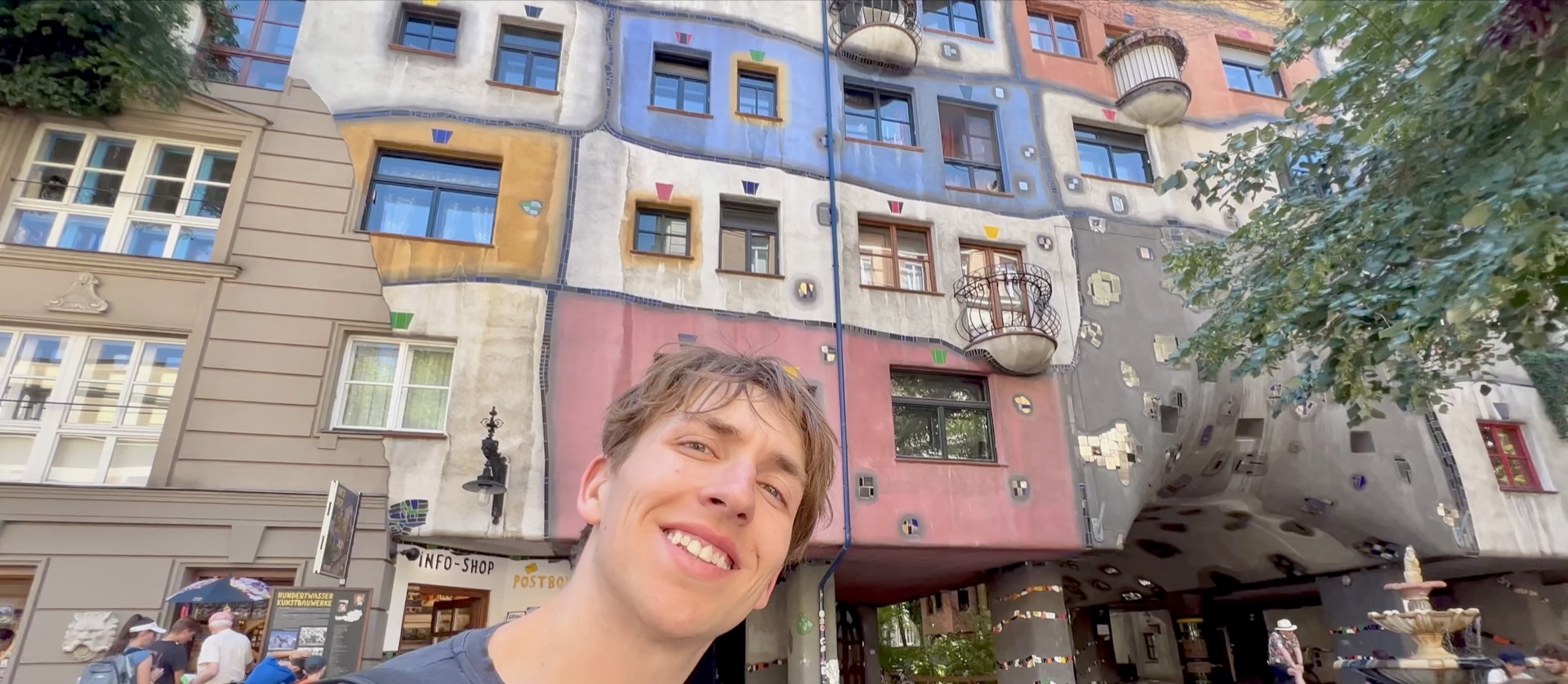
We need more funky and organic apartment buildings in the US. In Seattle, where I had lived for six years, the new apartment buildings are predominantly these bland "five-over-ones" -- five wooden stories over one concrete story. They all have pretty generic names, like "The X at Y". (I lived for a year at "The Heights on Capitol Hill".)
There's loudness only in the form of flashy, ugly advertisements for move-in deals. Because Seattle doesn't have rent control, The loudness comes from flashy, ugly signs advertising rent deals.
Seattle doesn't have rent control though, and these new apartment complexes are controlled by corporate landlords who seem to be engaged in price-fixing. The metagame is to make as much profit as possible, which doesn't necessarily entail housing people. It's likewise profitable to jack up rents and then charge exorbitant move-out and move-in fees.
Anyways, Vienna takes a different approach. Obviously, not everyone lives in the Hundertwasserhaus. But I did see a ton of signs marking Vienna's social housing.
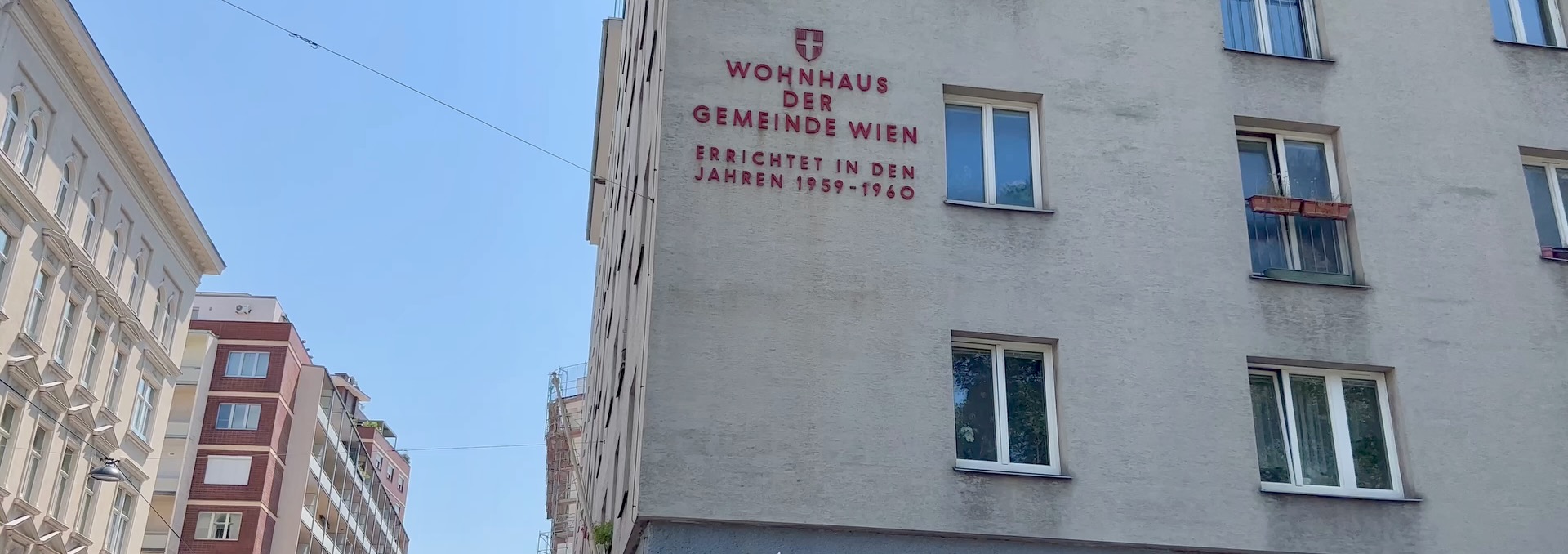
It seems to work really well.
Beating the heat
When I visited, Vienna was in the midst of a heatwave. I hung out by the river, which was really nice.

There were also little misting stations nearby the Rathaus.
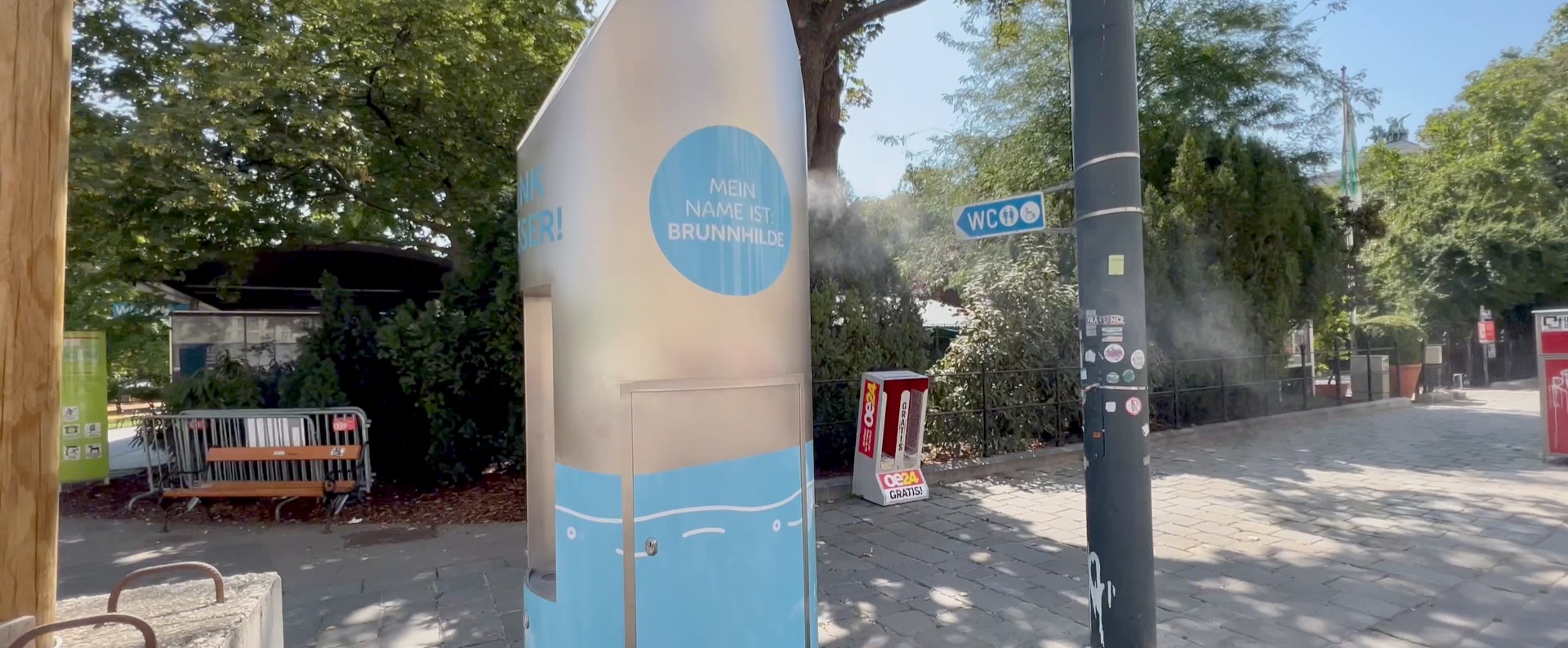
The end
I took a train ride back to Berlin.
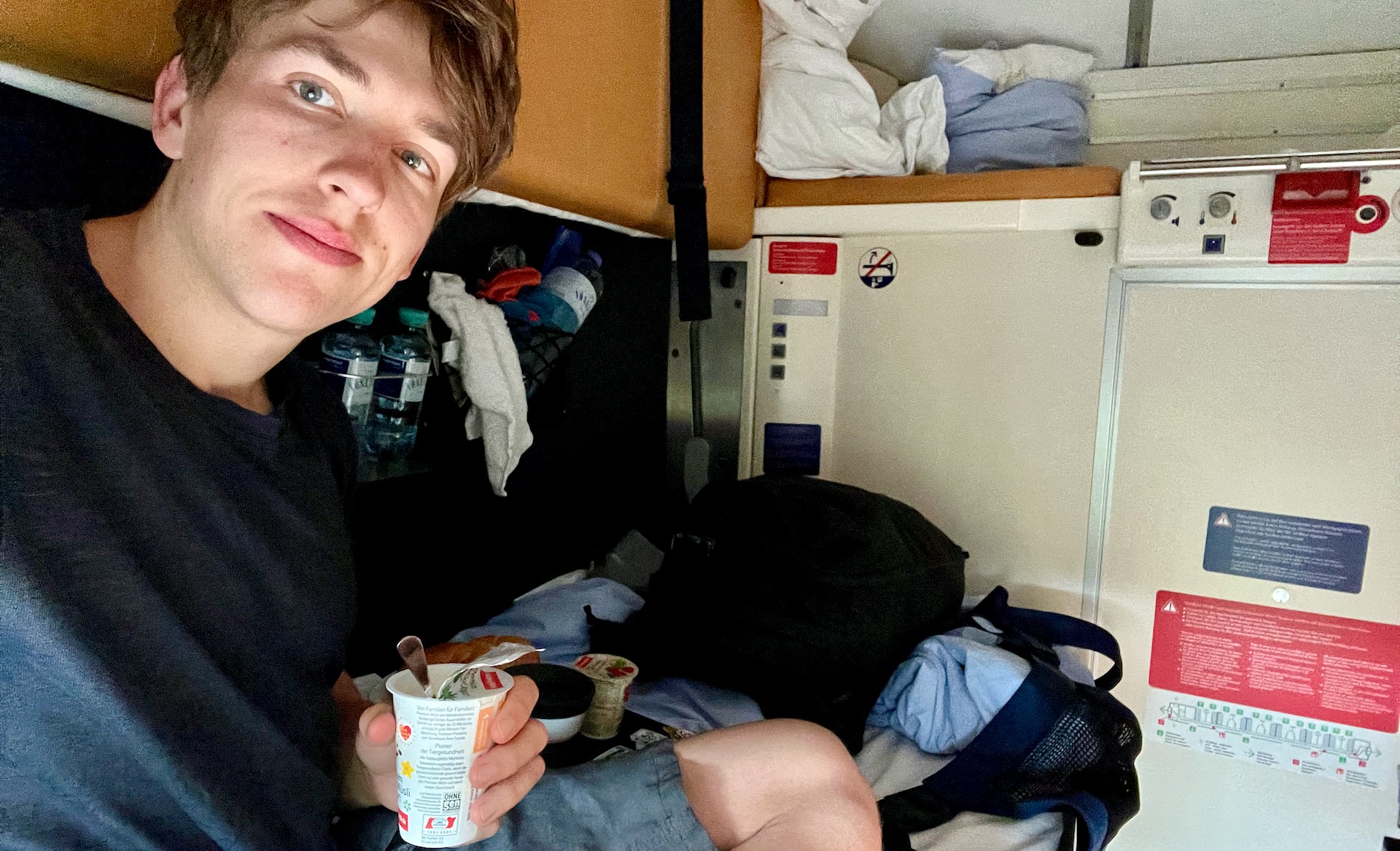
Then off to Seattle, and to San Francisco where I began my job. I'm still here.
There's a lot to reflect on. Though I'm not sure what to say right now except for the above. Besides, showing is better than telling.
Still though, I should probably try to upload these things in more manageable increments. Maybe in a couple years AI will be able to take care of all the photo and video editing for me. Maybe sooner?
It feels as much a question about raw (multimodal!) intelligence as it is about getting the interface right.
In the meantime though, expect delays. And hopefully, some more manageable travel posts - when I get around to editing and writing them.